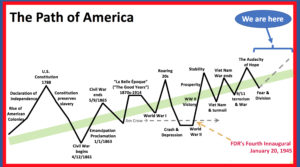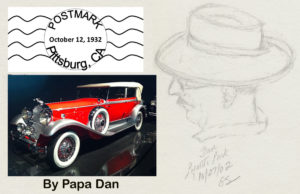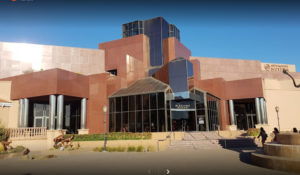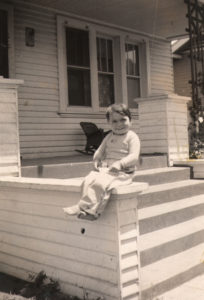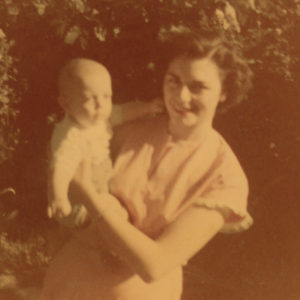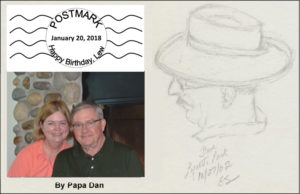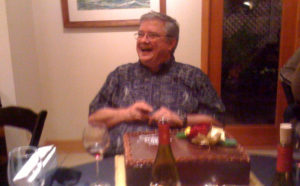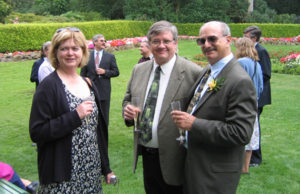Did A Human Write This?

Last Fall
New York Times Columnist Farhad Manjoo
wrote a piece called:
Did a Human Write This?
Well?
Click here for a PDF of this post: Did_A_Human_Write_This_SEPT1_FINAL
= = = = = = = = = = = = = = = = = = = = = = = = = = = = = = = = = = = = = = = =
In the Fall of 2020, a columnist named Farhad Manjoo reported in The New York Times something that many of us have come to realize — that machines have been gaining in their ability to write for a long time now; and, he says, “they are getting terrifyingly good at it.” Many people and businesses have greeted this news with appreciation, for it can enhance our ability to do our work in many useful ways. So, why does Mr. Manjoo use the phrase “terrifyingly good” to describe this phenomenon? … (pause here a moment for internal reflection) … In another sentence, he nudges a bit closer to our real, human, concern — “I’ve never really worried that a computer might take my job because it’s never seemed remotely possible.” However, he goes on to introduce us to a relatively new piece of software, a “language model” called GPT-3 that seems to contradict this reassuring sentence. Apparently, you can “program” this software language model by providing a writing sample. It claims to be able to match the pattern and “learn to write” in the same style as a human writer would.
Hmmmmmmmmmmmm …
So, the subject of Mr. Manjoo’s piece, “Did A Human Write This?”, is intriguing in itself;
BUT here, in THIS piece of writing, I am asking a question that intrigues me much more:
–> “How Can You Tell?” <—
In other words, if we claim that we can tell that a human and not a computer wrote something, what is it about the writing that would enable us to make that distinction?
Let’s explore this question.
Human Attributes: “The Usual”
Over centuries, humans have identified a set of attributes that we claim for ourselves as distinctly human. Some of these capabilities are fundamentally cognitive, like these two:
• The ability to recognize and remember a set of sequential stimuli and complex patterns
• A high-level ability to generate and comprehend complex language.
Computer programmers and software developers attest that computers can certainly do these two things in ways that sufficiently imitate human performance. Even if that’s true, I don’t think these are the determining factors in recognizing a human source for a piece of writing.
There are other recognized human attributes that are much more closely associated with what we think of as our “humanity,” like these two examples:
• empathy — the ability to understand and share the feelings of others
• the ability to recognize and apply patterns of moral and ethical decision-making.
So, I ask: can these two examples of “humanistic” attributes be simulated or credibly imitated — heck, independently performed — by computer systems in ways that we would recognize? Can the resulting writings sound human? The makers of modern “language models” claim that they can. You and I might claim that we can tell whether attempts are genuinely human or computer-generated imitations. BUT, that would just lead to an argument between us and software engineers; and we might not win that argument. Once again, I don’t whether those are the determining factors either. So, let’s set that aside for a moment. So, let’s go back to Mr. Manjoo’s question in the New York Times: if computers could possess those abilities, does that mean that computers can take jobs being done today by our human writers? Can computers make human writers obsolete? I’ll give you my answer.
My Answer: I’m saying “No”
There are formulations I have seen in the work of human writers over centuries (and in my own writing) that demonstrate distinctly human patterns of thought. I insist that these patterns are evidence of our human-ness that we can all recognize in our own behavior, and in the behavior of others, as distinctly human. They are NOT, I insist, patterns that computers would generate on their own. Even if they could, after looking at some examples, one can’t help but ask, “Why would a computer want to intentionally imitate these human patterns of thought and expression? (It’s not an unreasonable question to ask why humans would want to exhibit these patterns, but we can leave that for another time.) What are they? Let’s examine three examples of traits that human writers have attributed to their human characters, both in fiction and nonfiction:
• The propensity for lapses in memory, and patterns of incongruity
• The potential of individuals to hold opposing and contradictory views simultaneously
• The habit of some individuals to act in ways that are contrary to their own best interests.
Well, now maybe we’re getting closer to answering our question. These are human behaviors that appear repeatedly in writing about human characters. I am not convinced that writing generated entirely by computer software would or could feature these behaviors unless guided by an interfering human. On further reflection, even if they could, I don’t think these are the most important features that could answer the question: can computers make human writers obsolete?
Below are what I claim are the three principal indictors that matter: human attributes that writers portray in their characters that exhibit the most common elements of our humanity. Without these examples (and I’m sure there are others), much of our literature would be deficient:
• Digression, also known as ‘stream of consciousness’ thinking
• Silliness
• Illogic
Perhaps there are other examples, but let’s look at these three.
The Three Human Indicators: What do we see in Human Storytelling?
ONE: Digression: A lot of great American literature is built, at least in part, by this feature.
“… but as I was saying when … “ or “let’s set that aside for a moment”
Literature is full of examples of “stream of consciousness” storytelling in which the “voice” of the story speaks to the reader directly and digresses from the telling to share seemingly random thoughts along the way — Jack London (“To Build a Fire”), Ambrose Bierce (“Occurrence at Owl Creek Bridge”), Edgar Allen Poe (“The Tell-Tale Heart”), Mark Twain (“Speech On The Weather” and many others), Kate Chopin (“The Night Came Slowly”), are impressive examples.
It is interesting to me that some of the best examples of digression are not just found in stories, but also poems. In one of my favorite pieces of distinctly human literature, Robert Frost uses digression to capture an important element of imaginative reminiscence. In his poem “Birches,” Frost imagines a boy bending the branches of his father’s birch trees. He retells an entire childhood scenario of the boy climbing the trees in a particularly stylish way while doing his chores — “as he went out and in to fetch the cows.” A boy’s entire world view is shaped by this imaginary process. BUT then we discover that it’s all a digression. We hear that the speaker in the poem IS this boy, and then, as the poem brings us back to reality, it turns out that the ice storm is what bends the branches into their particular shape; but he would rather imagine something else:
But I was going to say when Truth broke in
With all her matter-of-fact about the ice-storm
I should prefer to have some boy bend them
As he went out and in to fetch the cows—
For Robert Frost, in his own recollection … or maybe in his imagination … he IS that boy:
So was I once myself a swinger of birches.
And so I dream of going back to be.
It’s when I’m weary of considerations,
He goes on to describe what it means to be “weary of considerations.” His imagination allows him to escape “considerations,” “rise toward heaven,” but return to earth because:
Earth’s the right place for love:
I don’t know where it’s likely to go better.
So, reality wins out over imagination … but … he concedes that the life of his imagination is not a bad place to visit:
One could do worse than be a swinger of birches.
But … I digress (you knew that was coming, eh?)
To return to Mr. Manjoo’s question — No, a computer could not have used such a digression from reality to imagination and then back again to reality to convey important messages about being human. Only a human could do that.
Below is the full text of Frost’s poem (you were hoping for that, eh?) It’s chock full of examples that confirm that no computer program imaginable could tell a story that takes you inside the human mind and heart the way these words do.
Birches, By Robert Frost
When I see birches bend to left and right
Across the lines of straighter darker trees,
I like to think some boy’s been swinging them.
But swinging doesn’t bend them down to stay
As ice-storms do. Often you must have seen them
Loaded with ice a sunny winter morning
After a rain. They click upon themselves
As the breeze rises, and turn many-colored
As the stir cracks and crazes their enamel.
Soon the sun’s warmth makes them shed crystal shells
Shattering and avalanching on the snow-crust—
Such heaps of broken glass to sweep away
You’d think the inner dome of heaven had fallen.
They are dragged to the withered bracken by the load,
And they seem not to break; though once they are bowed
So low for long, they never right themselves:
You may see their trunks arching in the woods
Years afterwards, trailing their leaves on the ground
Like girls on hands and knees that throw their hair
Before them over their heads to dry in the sun.
But I was going to say when Truth broke in
With all her matter-of-fact about the ice-storm
I should prefer to have some boy bend them
As he went out and in to fetch the cows—
Some boy too far from town to learn baseball,
Whose only play was what he found himself,
Summer or winter, and could play alone.
One by one he subdued his father’s trees
By riding them down over and over again
Until he took the stiffness out of them,
And not one but hung limp, not one was left
For him to conquer. He learned all there was
To learn about not launching out too soon
And so not carrying the tree away
Clear to the ground. He always kept his poise
To the top branches, climbing carefully
With the same pains you use to fill a cup
Up to the brim, and even above the brim.
Then he flung outward, feet first, with a swish,
Kicking his way down through the air to the ground.
So was I once myself a swinger of birches.
And so I dream of going back to be.
It’s when I’m weary of considerations,
And life is too much like a pathless wood
Where your face burns and tickles with the cobwebs
Broken across it, and one eye is weeping
From a twig’s having lashed across it open.
I’d like to get away from earth awhile
And then come back to it and begin over.
May no fate willfully misunderstand me
And half grant what I wish and snatch me away
Not to return. Earth’s the right place for love:
I don’t know where it’s likely to go better.
I’d like to go by climbing a birch tree,
And climb black branches up a snow-white trunk
Toward heaven, till the tree could bear no more,
But dipped its top and set me down again.
That would be good both going and coming back.
One could do worse than be a swinger of birches.
TWO: Silliness
Illustrating another distinctly human attribute — here is a childhood ditty that got translated into something that endured for more than a century:
Mares eat oats and does eat oats and little lambs eat ivy
A kidd’l eat ivy too, wouldn’t you?
That ended up being translated by generations of kids into this human silliness:
Marsey-dotes and dosey-dotes, and little lambsey-divey
A kidd’ldey-divey-doo, wouldn’t you?
Literature throughout western civilization is full of enduring uses of silliness to demonstrate a host of human values and truths. Monty Python is a modern example. We can go back a bit farther to Don Quixote by Cervantes and some of the writings of Roald Dahl with his “vocabulary of made-up words.” Even the ancient Greeks made use of silliness to make people giggle many centuries ago. For more — take a look into a book by art critic Peter Timms Silliness, A Serious History, which looked at the ways we’ve been made to laugh in pursuit of serious themes through our literary history.
These examples affirm the assertion that a computer is not capable of using our innate human silliness to write something that is purely fun and ridiculous without resorting to some bit of logical sense. Only humans are sufficiently silly to reveal that aspect of our human selves.
THREE: Illogic: Spock’s breakthrough
The masterful writing of Gene Roddenberry in the TV series Star Trek, repeatedly illustrated the effect of combining human (i.e., Earthling) and nonhuman (i.e., Vulcan) attributes. In the episode “The Galileo Seven (co-written by Oliver Crawford),” Lt. Commander Spock illustrates, as always, the contrast between his Vulcan dependence on logic as the overriding guiding principle of all of his decisions and the more “human” decision-making typical of Captain Kirk, which sometimes utilized emotion and impulsive reliance on intuition.
In this story, Spock is commander of a landing spacecraft whose small crew launched from The USS Enterprise to land on a small planet and solve a life-threatening problem. When the expedition went awry and trapped Spock on the planet’s surface, the crew risked the safety of their ship to save Spock’s life. He had ordered them to take off without him to save the ship and crew (a logical order); but they disobeyed his order by applying their human compassion, risked their own lives, and went back to the planet to save him. Although he reprimanded them for their illogical decision, what followed was a decision he had to make to save them all from certain destruction.
For technical reasons, the Starship Enterprise was unable to locate the Galileo to beam them back to the ship. With fuel running out, the Galileo and all on board, appear to be doomed to fall and burn up in the planet’s atmosphere. Spock’s response was, for him, illogical — he launched and ignited the remaining fuel tank — ending their control of the ship — effectively sending up a flare. The slim hope was that the Enterprise, heading in a different direction, would see it and determine their location well enough to beam them aboard and save them all.
MCCOY: It may be the last action you’ll ever take, Mr. Spock, but it was all human.
SPOCK: Totally illogical. There was no chance.
MCCOY: That’s exactly what I mean.
At the last moment, as the ship begins to burn up, transporter beams lock onto the crew members and transport them safely onboard the Enterprise.
Back on duty, a bemused Captain Kirk questions Spock about his last-minute command decision:
KIRK: There’s really something I don’t understand about all of this. Maybe you can explain it to me. Logically, of course. When you jettisoned the fuel and ignited it, you knew there was virtually no chance of it being seen, yet you did it anyhow. That would seem to me to be an act of desperation.
SPOCK: Quite correct, Captain.
KIRK: Now we all know, and I’m sure the doctor will agree with me, that desperation is a highly emotional state of mind. How does your well-known logic explain that?
SPOCK: Quite simply, Captain. I examined the problem from all angles, and it was plainly hopeless. Logic informed me that under the circumstances, the only possible action would have to be one of desperation. Logical decision, logically arrived at.
KIRK: I see. You mean you reasoned that it was time for an emotional outburst.
SPOCK: Well, I wouldn’t put it in exactly those terms, Captain, but those are essentially the facts.
KIRK: You’re not going to admit that for the first time in your life, you committed a purely human emotional act?
SPOCK: No, sir.
KIRK: Mr. Spock, you’re a stubborn man.
SPOCK: Yes, sir.
Illogic is such an intrinsic feature of human behavior and understanding that only a human writer would be capable of expressing is convincingly. It is one of the clear qualities of human writing that cannot be successfully imitated by a computer. We humans recognize it when we see it.
So, no, the jobs of human writers are not in danger of being overtaken by computers. End of discussion. So says the human writer.
![]()
A Writer Tries to Emerge from a COVID Fog
Planning and Optimism
Click here to download a PDF of this post: Writer_COVID_fog_Jul18_ConVivio
I am sitting here at my computer screen, trying to do something that has been easy and familiar for a long time.
Before the COVID took over our collective consciousness in early 2020, I had kept myself happily engaged with my writing. To illustrate, during the twelve months of 2019, I wrote 21 stories and essays that I posted to my website at ConVivio-online.net. Prior to that, I had posted 20 pieces in 2018 and 18 pieces in 2017. I also wrote several chapters of my “long family story”; I wrote three chapters of “The Flying Pig Novel”; fabricated two time-travel pieces, and started thinking about writing Act Two of the one-act play I had written in 2013 called “Some Explaining to Do.” Friends of mine got to contribute their favorite poetry as guests to a series of ConVivio posts acknowledging “National Poetry Month.” In addition, each month during those years I prepared a piece of writing to read to the group at monthly meetings of The Whistlestop Writers at The Swirl — a wine bar in Livermore. So, my writing was humming along pretty well in 2017, 2018, and 2019 — and well before that — AND that writing had an audience.
But then, a dramatic change happened — COVID-19 arrived and took possession of us all. In all of 2020, and through July of 2021 — over the span of 19 months — I posted only eight (8) pieces of writing to my website and I wrote NOTHING for The Whistlestop Writers, which had been suspended because of the virus. I couldn’t count the number of times, I sat at my computer and stared at drafts of ‘next chapters’ and got nowhere. I guess we can say that was a dramatic drop-off, eh? In conversations with other writers, I have learned that this effect has become fairly common. So, what happened?
A Change of Venue
One big change was the fact that, because of COVID-19, the Pleasanton Public Library closed.
Over a couple of years, I had gotten in the habit of packing up my computer, driving across town, settling into one of the desks in the back half of the library, and spending an hour or two writing. It was, by definition, a quiet venue with few distractions and a comfortable place to sit. Perhaps being surrounded by thousands of books contributed to the stimulation that desk provided. I got a lot of work done there and was quite pleased with the results. Driving to the library had a familiar, and comfortable feeling of “going to work.” In that setting, I wrote three time-travel fantasies set in other times and places — Paris, San Francisco, and even my old home town of Antioch. I conjured up a fictional but plausible story in which my alleged fifteenth-century ancestor worked on Brunelleschi’s Dome project and then decided to leave his family’s marble business to escape the turmoil that engulfed Florence in the 1490s and moved south to a less prosperous but “safer” location in Calabria. While that story was 100% fiction surrounded by historical facts and some real characters, it set up a believable answer to a family question: how and why did members of my family end up in Southern Italy so, four centuries later, they could emigrate to America from the small town of Savelli in Calabria? In turn, that story led me to imagine that my grandparents, who traveled from the extreme poverty of Southern Italy in the first decade of the 20th century, certainly must have left behind family members in southern Italy whose descendants, 100 years later (right about now), might wonder what became of those relatives who got on ships and sailed across the Ocean to Ellis Island a few generations before. That library writing desk also brought to life stories of appreciation of the work of one fictional artist and one very real one (Gretta). That desk also provided a platform to write about our seven trips to Europe and the local connections Gretta and I made there.
I suppose I can’t give the library desk full credit for all of that, but it seems to have helped.
But then — the library closed and I found that the dominance of COVID in America caused me, and so many others, to focus unwillingly on some very unsettling factors: the very real dangers of the virus, the nearly complete shutdown of the social interactions that had mattered so much to us with friends and family and places (like libraries, bookstores, and restaurants) before COVID, and the frame of mind that came with all of those features that stimulated my writing, and that of other writers, prior to 2020. For so many of us, that pre-COVID frame of mind certainly contributed to our ability to focus on topics larger than ourselves and the “normal realities” that were driving our world. In 2020, many of us learned that “Zoom” and “Facetime” meetings were an imperfect substitute for REAL family gatherings and REAL meetings. During that time, crawling toddlers became walking, running, talking kids. Middle schoolers showed up remotely on laptop screens as high school students. One painful memory will stick with me for a long time — the day Gretta and I showed up at the home of two of our grandchildren to celebrate an important day. When we appeared at the kitchen window, the kids, aged three and five, were expecting us and were delighted to see us. They yelled:
“Papa! GG!” with big smiles on their faces. When we placed a gift on the front porch and left after just a few minutes without coming inside, they cried. While driving away I wondered: had we done something good by visiting today? I dunno.
So, many of the effects of the COVID life are emotional. Adam Grant wrote in the NYT:
“I started watching standup comedy specials, hoping to get a taste of collective effervescence while laughing along with the people in the room. It was fine, but it wasn’t the same. Instead, many of us found ourselves drawn into a dark cloud. Emotions are like contagious diseases: They can spread from person to person. Emotional contagion is when we are literally infected with other people’s emotions.”
AND it turns out that those emotions can be spread by the absence of other people, as we become accustomed to avoiding contact with others to avoid the COVID.
So, it seems that some writers have found themselves in a fog that had the effect of limiting the quality and quantity of our productivity. It was a COVID-induced partial Writer’s Block.
Progress?
Can we PLAN our way out of this? How about:
— mask up and go to a grocery store (and stop ordering delivery) — Done, done again √√
— go to a restaurant (Esin) in their outdoor tent (for their famous pot roast) — Done √
— go to a restaurant (Esin again) and (wait for it) sit INDOORS! — Done!! √
— visited Yosemite in April (√) scheduled to return in October — got reservations √
— plan to go to a Giants’ game — planned, scheduled, got tix √
— consider taking BART to game — considering … it’s a maybe … we’ll see …
— plan to spend time at the library desk — planned … when the time is right.
— write about it — got started, right here √
It turns out that one other factor, added to hopeful planning, becomes the key:
Optimism
It’s one thing to plan for a time when we can do things the way we used to do them, with the people we used to do them with, in the places we used to go. It’s another to believe that such “re-opening” (to use what is becoming a well-worn phrase) will become a sensible thing to do and will soon become a routine part of our regular lives. We’ve heard it before and now we’ve learned from real-live experience how important believing really is. During a very dark time, Eleanor Roosevelt taught us this (and, as usual, she turned out to be right):
“The future belongs to those who believe in the beauty of their dreams.”
So, it’s not that complicated. Even if the “dreams” are relatively simple. We know what life is supposed to be like — we’ve been around awhile. We just have to believe it will return.
So, will the progress we’ve made, and our belief in even more progress, help reduce the Writers Block? Will that optimism lead to more progress in other aspects of our real lives — the lives that stimulate writing and enable everything else we do? My first answer was:
We’ll see …
But I think, after exploring it further, the better answer that is emerging is, simply:
Yep … It’s coming back. We believe it. And THAT can help make it happen.
![]()
Did Anyone Else Get RAINBOWS?

Did Anyone Else Get RAINBOWS?
— by Guest Writer Andy Faletti
And the Best thing about it?
The Pandemic could not do a Thing about it !
It had Not … One … Word …
to say about This…!
Download a PDF of this post: ConVivio_Rainbows_Jan_2021
= = = = = = = = = = = = = = = = = = = = = = = = = = = = = = = = = = = = = = = = = =
Call me weird but I love Rainbows.
At 5:00 today, I (and our puppies Jack and Bobby)
just saw the most
Beautiful
Double-Rainbow
The dogs like going for a ride.
So we happened to be driving down a big boulevard near us – on the wide curve
– next to nothing-but-fields of remaining open space East of Davis.
So the view was amazing.
Two Rainbow Legs on the South end – one a bit dimmer than the bold stark one –
– soared in a broadening arc, then lost their way above in the cloudy-dark sky.
I see a man taking pictures with his phone and realize I am not the only one who sees it.
Then the North end came into view, truncated, yet equally stark in hue.
So-o pretty – distinctive incredible color bands
“all the colors that you know…,”
don’t you know… : – )
And best … they went all the way to the ground – Right to where the pot of gold can be found
(not sure if the east end or west end has the fabled gold – the other surely has the leprechaun)
They usually do not touch the ground – this is only the second time I remember seeing that phenomenon.
Not even in Hawaii, when we have been struck by evanescent 5-minute evening-shower-rainbows…
To be completely accurate, I couldn’t see all the way to the ground, as
on the South end, there were some low white cloud wisps being stirred up.
Disturbed by the curving heavy boot of the rainbow,
as it dove and buried itself into the ground after its 180 degree journey from the North.
Families started coming out of their houses to view it, as it lasted at least 25 or 30 minutes.
(People perhaps were tipped off to it by neighbors posting on Nextdoor.com… ; – )
And cars going 50 mph both ways around the wide distended curve of the boulevard
were literally pulling over at the sight in order to (safely!) take in the view.
Whew.
I had to make a U-Turn instead of going to the Park (sorry, Jack and Bobby)
to see it again ! Then needed to finally get out and look…
And the Best thing about it?
The Pandemic could not do a Thing about it !
It had Not … One … Word … to say about This…!
… OK, so Andy’s lost it…
But anyway, it was amazing!
A harbinger of good, I’d like to imagine.
Wishing you a Double Rainbow where you are, too! … maybe tomorrow…
Andy Faletti
To Witness the Miracle
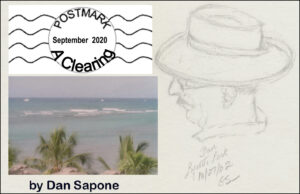
“We are here to witness the miracle.”
— Ray Bradbury
“So, what’s it all about?”
— An American college student in Florence
Since this year, 2020, has not been kind
to travelers (or anyone really); some of us
who have enjoyed the pleasures of travel,
pleasures that have been denied to us
during this COVID year, might want to remind ourselves
of some ideas that emerge from an important question.
= = = = = = = = = = = = = = = = = = = = = = = = = = = = = = = = = = = = = = = = =
Why Travel?
Kappa’a, Kaua’I, Hawaii — A taxi to the BART station, a train to the airport, a series of hurry-up-and-wait movements, and we find ourselves on an airplane, seatbelt buckled, ready to go. Hours later, a smooth landing, more rolling through another airport, a taxi, and a hotel — and here we are! A comfortable place to sit, a glass of wine overlooking the ocean, this was clearly a good idea. No question about it.
We have arrived. Now what? What exactly am I looking at? What should I think about?
— • —
A Clearing
In the 1950s, philosopher Martin Heidegger suggested that, if you can clear away all of the ‘stuff’ that you carry with you that clutters up your life, what emerges from that clearing will help clarify the world around you. He called it (among other things) “truth.” That sounded useful; so, I tried to do that — to make such a clearing — since, here on a beach on an island in the Pacific Ocean, I seemed to be in a place conducive to the making of clearings.
We were sitting at a small patio on the edge of the northern-most Hawaiian island: Kauai. Looking out at that vast ocean, it is easy to let go of things that usually clutter up your mind. The “clearing” that remains offers a lot of room for large ideas to appear, and even a few small ones.
So, what shows up in that clearing?
Surprisingly, the ideas that emerge are not complicated, but simple observations that might be obscured by the details we think about on “normal” days in more familiar places. OK, like what? Well, as I look out to sea, the scene is dominated by one thing: the horizon, just a line, really. I notice that there are no straight lines in this scene, just this one decidedly curved one. No doubt about it, the left and right “ends” of this line that forms the horizon are clearly lower than its midpoint. There can be no question that the complete object, of which this piece of horizon is a part, is not flat.
This observation argues clearly and simply for a round earth. OK, so the earth is round.
That was easy.
Since this “fact” is a relatively new one in human history, I marvel at the power of whatever must have cluttered up the minds of people only five hundred years ago that could have obscured the simple observation that emerges from the clearing I see here. Did nobody notice in all of generations that have walked the earth that the only truly straight lines in existence were man-made? Amazing! And to think that sitting here at the edge of this island made this historic piece of knowledge obvious — a round earth — knowledge that had escaped so many smart people for so long.
Setting aside my amazement for a moment, all the other wonders and beauties we can observe on this island lead eventually to other questions not as easily answered. They are not so much questions about the natural beauty we see around us, but … something else.
OK, so anyone who has tried to ask the “Why?” question knows that it’s never quite that simple. “Why what?” What are you really asking? Why is it round? Why does the water move the way it does? Why does the land occasionally rise above it? The “Why?” questions continue until you stop to consider that there is a question at the root of all of them:
“Why am I here making these observations and asking these questions?”
Of the many humans who have ventured an answer, one writer has held my attention for some time. On the day Neil Armstrong first walked on the moon, science fiction writer Ray Bradbury answered that question for Walter Cronkite: “We are here to witness the miracle,” he said.
–> We are here to witness the miracle. <–
Lots of writers have offered the opposite view that we human beings ARE the miracle — that all of creation has had the primary purpose of bringing human life to this planet. Bradbury’s very different view begs three further questions:
One: If WE are not “the miracle,” then what exactly IS the miracle?
Two: Why does the miracle need a witness?
and, of special interest to artists and writers,
Three: What are the responsibilities of beings created to witness to such a miracle?
While seeking answers to the large questions that emerge from ‘clearings,’ one might ask a smaller one: –> Where does one go to get a closer look at such a miracle?
So, we travel in search of it.
Writers have been telling us that for a long time, and they’ve identified different kinds of miracles. Thornton Wilder has a character who explains that for us in his play Our Town — and she was a character who spent a lifetime without ever leaving Grovers Corners. She observed: “It seems to me that once in your life before you die you ought to go see a country where they don’t talk in English and don’t even want to.” And why is that worth anything? Mark Twain answered this way: “Travel is fatal to prejudice, bigotry, and narrow-mindedness.” And he went on to say, “…nothing so liberalizes a man and expands the kindly instincts that nature put in him as travel and contact with many kinds of people. Broad, wholesome, charitable views of men and things cannot be acquired by vegetating in one little corner of the earth all one’s lifetime.” When faced with a contrary argument, Twain got specific in his book of travel stories, Innocents Abroad: “The gentle reader will never, never know what a consummate ass he can become until he goes abroad. I speak now, of course, in the supposition that the gentle reader has not been abroad, and therefore is not already a consummate ass. If the case be otherwise, I beg his pardon and extend to him the cordial hand of fellowship and call him brother.”
Back to “The Clearing”
If travel is a way of making ‘clearings,’ maybe Heidegger’s “truth” is too large a treasure to expect to find in any single clearing. Maybe the grand moments we expect — like standing before Brunelleschi’s dome in Florence or staring up at the ceiling of the Sistine Chapel in Rome — maybe they are not the most significant of the ‘humanizing’ moments that Twain spoke of. Perhaps more important are the small moments of connection that, when strung together, can add up to ‘truth,’ or some approximation of it. Maybe they can consist of fleeting moments that flash brightly and are then gone. Looking back on our years of travel, some examples emerge.
Humanizing Moments
I recall a weekday night during our first visit to Florence in 2001, we walked around the corner and dropped into a small neighborhood restaurant for dinner – Nello’s. It wasn’t busy, so we struck up a lively conversation with the waiter, who identified himself as “one of the owners.” He answered our touristy questions about Florence and we answered his about San Francisco. We talked about what it was like to live in these two similar places spread so far across the world. He spent a lot of time with us and, near the end of the evening he brought three glassed and we sipped Amarone together for a while before we left. It was delightful. We felt we had made a ‘connection’ with a ‘local’ and it felt good.
When it came time to find a place for dinner on the weekend, we remembered the nice time we had on Tuesday and decided to go back to Nello’s. What the heck, maybe that same guy will be there. That could be fun. So we did.
This time, a Friday night, a tour bus had unloaded and the place was jammed. The same guy was there again, but he was so busy we barely got a glimpse of him. We were lucky to get a table for two in the corner. We greeted him warmly and hoped for a moment of recognition but there was none. Were we ready to order? he asked. I mentioned that Gretta and I had spent the afternoon at Il Academia, which we had talked about with him on Tuesday, but he simply asked, “Some wine?” He took our wine order and left without a nod of recognition. We wondered, had we offended him? What happened to the ‘connection’ we thought we had made? Over the course of the meal, looks passed between us and the waiter indicating that something seemed missing but nothing was said. We decided, he’s just too busy. So, we lingered over dinner and waited until the ‘tourists’ had mostly cleared out. When he noticed that we were still here, he finally came over to us and asked if there would be something more. I tried again to engage him in conversation and commented, “this place is quite different when the tour bus unloads, eh? It was really quiet on Tuesday.” He said, “If you were here on Tuesday, you met my identical twin brother.” He and I looked at each other for a long moment and realized what had been missing. He smiled. “Oh, so we HAVE met. Or so it seemed.”
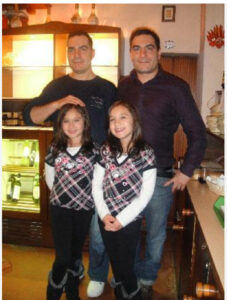
Yes, another connection.
Twin brothers at Nello’s in Florence
Such connections can happen in surprising places. One foggy Spring day, on our last day in London in 2003, we got all dressed up to have “High Tea” at the world-famous Savoy. I wore my best Fedora — a “Sinatra-esque” hat like the one my Father wore when he wanted to look dignified. In the restroom of all places, a distinguished-looking gentleman, dressed in a three-piece suit was standing at attention in his role as the restroom attendant. When he handed me a towel, I asked him with mock gravity, which he seemed to understand, “Tell me, sir, is mine the only Fedora in all of London?”
Yes, sir,” he replied returning my serious expression.
“So, does that mean that all of my efforts to bring Fedoras back into fashion have failed?”
“Yes, sir.”
The momentary grin we exchanged as I tipped my hat to go and dropped a few bills in his jar was worth every bit of the price of afternoon tea at the Savoy.
Finally, on a sunny day in Paris, we were sitting at a shady spot overlooking the Luxembourg Gardens. Gretta was drawing the scene of Parisians enjoying one of their unique spots of civic beauty and I was sitting with my notebook, trying to look like a writer. An older couple walked up and leaned on the stone wall in front of us and we struck up a conversation. They showed an interest in what we were doing — “Gretta paints with watercolors,” I said, stating the obvious.
“And you are a writer?” she asked, pointing at my notebook.
“Oui,” I grinned.

As if in reply, she said, “Let me tell you a story.”
So, sensing an opportunity, I pointed my iPhone and pushed the record button, surreptitiously, I thought. Turns out that they had met as teenagers here in Paris a very long time ago, fell in love, but went the separate ways that life took them — he to the army and she to marriage and children. After many years she returned to Paris — now a widow — and, at the suggestion of her grown son, looked him up on Facebook. And now, here they are, they live in Paris together, where they belong, and were clearly celebrating that fact. As she told her story, the gentleman and I exchanged glances at each other and at my iPhone and he nodded approval. When she was done, I said, “With your permission … “ and I gestured to the iPhone to admit my intrusion. She interrupted me, “Yes, I noticed. It’s a good story, isn’t it? Perhaps you’ll write it down.” We bid each other good day and they were off.
A good story.
The small moments of connection never seem to stop, if you look for them: a woman from the East Bay we met on a boat on Lake Annecy … a bottle of homemade wine gifted to us at the end of a stay at Pomerlo Vecchio in Umbria … an American college student in the Academia in Florence, looking up at Michelangelo’s David, who asked me, “This David is supposed to be a big deal. What’s it all about?”
So, I told him a story that had been told to me — about an inspiring mythical character and a story told in stone by a sculptor more than 500 years ago — “and here we are still looking at it with admiration.” I think he “got it.”
There are many small miracles to witness when clearings are made.
![]()
Falling Down
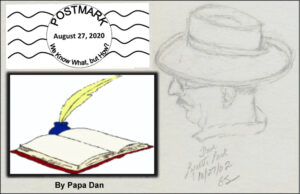
Let’s take a look at an old joke,
an old, crude and insensitive little joke,
and see if it applies to a current feature
of our American Democracy.
Falling_down_FINAL_BREL_Aug272020
= = = = = = = = = = = = = = = = = = = = = = = = = = = = = = = = = = = = = =
An Announcement
The scene is a large office building — the headquarters of a large national corporation. We see one, wide, uninterrupted floor of this office building containing several dozen cubicles and desks where people are working at their jobs. A voice comes over a loudspeaker and fills the room:
“Ladies and gentlemen, may I have your attention please? It has come to the attention of management that some employees who are dying on the job are failing to fall down. As a result, given the nature of our workforce, it has become difficult for management to distinguish between employees who have died and those who are still working. Therefore, beginning immediately, employees who die on the job are instructed to fall down. This action will contribute significantly to our ability to assess our productivity and make necessary management decisions. Thank you. That is all.”
Applying the “Joke”
So, what does this rude and insensitive little story, have to do with the state of our American Democracy?
Since the early history of our “great American experiment in democracy,” the United States of America has organized itself into political parties. The Founders did not intend it to be so — parties are not mentioned in Hamilton’s “Federalist Papers” nor in the Constitution — but it happened anyway. They haven’t always been the same parties — some parties have come and gone as they became irrelevant (remember the Whigs and the Tories?); some have changed their names (recall the “Federalists” and the “Democratic Republicans?”); and throughout our history some citizens have declared themselves to be independent of those parties. But over my lifetime, American politics and government have been structured predominately by two competing political parties that have populated most of the positions of power and influence in our national decision-making. One is called The Democratic Party and the other is called The Republican Party. Both parties have long stood for a common set of values, broadly recognizable as American values, as initiated by the Founders, values that have kept the nation together over the past century or so since the Civil War. In that respect, the two parties have a lot of historic similarities. The differences between those parties have largely centered on the policies and strategies they have preferred in pursuit of those values. Most often, national decisions have been made with more-or-less respectful debate, persuasion based on regional interests, compromise (only possible because of the common values I mentioned), and voting.
Today in America, however, the party that calls itself The Republican Party has died. It has died, but it has failed to fall down. As a result, there are still large numbers of citizens who believe that The Republican Party still exists. But it does not. It has died.
Growing up, I accepted my father’s assertion that “We are Roosevelt/Kennedy Democrats”— and I still do. However, well into my thirties, he and I knew and respected a number of Republicans. For them, if they are still alive and remember, their party has died. There was no funeral and some Americans mistakenly believe that it still lives.
OK, so that is a dramatic assertion, which some may not accept. I understand that. So, how do we test that assertion? How does a person notice that The Republican Party has died? All my life, certainly since I was in high school, the Republican Party has stood for at least these 7 consistent values:
1. preserving American institutions,
2. supporting fiscal conservatism, defined as a federal budget balanced between income and expenditures (i.e., opposition to “deficit spending”),
3. supporting small business (evident in consistent support for local Chambers of Commerce),
4. maintaining strong international alliances in support of global economic strength and American foreign policy objectives like reciprocal trade and fierce opposition to foreign dictators (especially those in Communist Countries) all in support of international peace and stability,
5. basing policy decisions on science and academic excellence by supporting and consulting experts,
6. supporting reliable safety-net programs to ensure a minimum, decent standard of living for Americans
7. actively promoting the value of common sense.
Those have been the fundamental values of the Republican Party since I was in high school, as confirmed repeatedly by spokespersons for that party. Those have long been called “Conservative” values. An observer will notice that those who claim to speak for the Republican Party today no longer stand for those values. Consider these observations on those topics — members of the Republican Party have advocated for the following things in very recent years:
1. They have worked very hard to diminish the effectiveness and credibility of long-standing government institutions such as the Justice Department and immigration authorities, criticized “so-called judges” of the federal courts who have ruled against Republican policy decisions, and depleted the ranks of long-standing institutions that have provided policy stability such as the State Department, Environmental Protection Agency, Postal Service, and Department of Energy.
2. They have proudly and repeatedly handed out large tax cuts for the wealthy blatantly causing budget deficits.
3. They have openly supported interests of the largest corporations, knowingly endangering the viability of small businesses, with tax policy and a willingness to renege on legitimate debts and agreements.
4. The current Republican Administration has repeatedly demonstrated deference and support for foreign dictators (e.g., Russia) who have shown a disregard for established national boundaries and attempted to undermine American elections. Republicans have resisted efforts to defend against those threats, undermining investigations and weakening alliances the nation has relied on for decades.
5. They have rejected science, denying well-established scientific knowledge like the effects of our energy choices on destructive changes in the global climate — actually subsidizing corporate polluters! Under the current Republican administration, America is the only nation to withdraw from the Paris Global Climate Agreement.
6. They have slashed long-standing safety-net programs, cast dozens of votes attempting to take away health insurance from ordinary Americans, resisting and demeaning long-standing progress in the rights of women, and unravelling campaign finance regulations to give billionaires outsized influence over all government decision-making, while systemically attacking voting rights to make it harder for the young people, minorities, and the poor to vote.
7. They have thrown common sense to the winds by embracing wild conspiracy theories, like the health threat from windmills, widespread voter fraud, the fabrication of climate change by the Chinese, the credibility of certain birth certificates, (and more), despite public evidence to the contrary.
As former President Obama summarized in a speech in 2018, this Republican behavior is “not conservative. It sure isn’t normal. It’s radical. It’s a vision that says the protection of ‘our’ power and those who support ‘our’ party is all that matters, even when it hurts the country. It’s a vision that says the few who can afford a high-priced lobbyist and unlimited campaign contributions set the agenda. And over the past two years, this vision is now nearing its logical conclusion.”
The conservatism that guided the Republican Party of my youth is gone. Yes, the Republican Party has died. Believe it or not, the seeds of that death were planted during the first term of the Reagan administration (check out his huge budget deficits: $195 billion in 1983, $180 billion in 1984 – look it up). Reagan’s “Conservative” administration also undid restrictions on Saving and Loan institutions, leading directly to the S & L crisis and slashed federal mental health funding precipitating today’s homeless problem.
So, what has replaced this now-deceased political party? Those who currently call themselves Republicans have embraced the politics of “resentment, division, and paranoia” instead of what we used to understand to be “conservatism.” Fiscal conservatism, of course, has become an often-invoked myth. The values to be preserved are power and influence.
What To Do
The dead-but-still-standing Republican Party, needs to be replaced by a large group of people who have a genuine interest in governing. I suppose, the problem could be described simply as a vocabulary issue. It seems that Republicans no longer understand the word “govern” to be a verb — that is, something that you DO. For some time, they have only recognized the word “government” — a noun that they utter bitterly as if it were a cuss word, pronounced either before or after spitting, as in “government regulation, ptieuuw!” They failed to learn (it was in the fifth grade), that the phrase “government regulation,” was one of the central purposes of government, as established by the Founders, to protect citizens against threats that they cannot fight individually. Over thousands of years, that phrase, “government regulation,” has been the single dominant characteristic that has distinguished uncivilized disorderly collections of people from what historians and anthropologists call “civilization.” To answer the “what to do” question, there are three steps (there are always three):
Step One: the election of 2020 — A large Democratic Majority must be elected in both houses of Congress and in State Legislatures and City Councils across the country to replace the mythical and deceased, Republican Party of old. This must be accompanied by restoration of confidence in the integrity of elections — an effort to be pursued in parallel with Step One.
Step Two: A Democratic President must be elected in 2020 while simultaneously preserving and expanding the Democratic majority mentioned in Step One. Then, the challenge will still be immense. There will be a lot of damage to repair from years of cowardly fake conservatism (known as “Trumpism”) and the weak national response to Trumpism that made it possible.
Step Three: The utter completeness of the Republican defeat must be accompanied by a movement to re-establish traditional conservatism as the bedrock of a new party with a new name — how about “The Grand New Party.” That party needs to sit down across a table with Democrats and re-engage in the business of governing. They need to reassert a set of values that would be recognizably American and taught in public schools (well-funded public schools, by then) as principles we can all pursue together with our own regional flavors. Oh, by the way, elected representatives of the Democratic Party need to be rejuvenated (OK, replaced) with folks with a commitment to the future in addition to their commitment to the values of the past. If you want to read that to mean “replaced by younger folks,” go ahead.
So, our question: Can all this be done in this generation?
My answer: Nope. Clearly, my generation (the “Post-War Baby Boom”) has had its chance to make a difference and gets mixed reviews. We made some progress in the 1960s, but my generation also brought us all some pretty awful outcomes, in spite of a handful of promising leaders. So, my answer is No. Given who we are, collectively, and HOW we have been approaching this problem, it’s not going to happen. But I suppose we can start with Step One and Step Two today, so my grandchildren’s children can have a place to start.
But Wait —
We described a serious problem and proposed a challenging “What To DO” to solve it. BUT, in assessing whether we can accomplish that goal anytime soon, is it possible that we have left out the most important question:
How?
Maybe it will take a dramatic, but simple, answer. Can we supply the simple human ingredient that has been missing from our politics and governance? Maybe that answer can come from a song from the 1960s (OK, an approach my generation has offered many times). Here it comes –
the climactic final song from an important musical from the late 1960s, which I had the privilege of seeing on the stage twice: “Jacques Brel Is Alive and Well and Living In Paris.” Translated from the French by Eric Blau and Mort Shuman, the lyrics (below), offer a solution. Sounds simple. Take a look at the lyrics and consider whether it is useful here in the 21st century. If we only …
If We Only Have Love
If we only have love
Then tomorrow will dawn
And the days of our years
Will rise on that morn.
If we only have love
To embrace without fears
We will kiss with our eyes
We will sleep without tears.
If we only have love
With our arms open wide
Then the young and the old
Will stand at our side.
If we only have love
Love that’s falling like rain
Then the parched desert earth
Will grow green again.
If we only have love
For the hymn that we shout
For the song that we sing
Then we’ll have a way out.
If we only have love
We can reach those in pain
We can heal all our wounds
We can use our own names.
If we only have love
We can melt all the guns
And then give the new world
To our daughters and sons.
If we only have love
Then Jerusalem stands
And then death has no shadow
There are no foreign lands.
If we only have love
We will never bow down
We’ll be tall as the pines
Neither heroes nor clowns.
If we only have love
Then we’ll only be men
And we’ll drink from the Grail
To be born once again.
Then with nothing at all
But the little we are
We’ll have conquered all time
All space, the sun, and the stars.
— 1968 — Original soundtrack audio: https://www.youtube.com/watch?v=M9ILw3D5yrU
![]()
Shelter
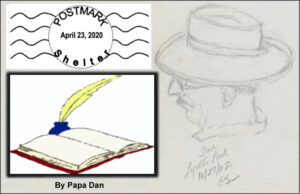
“So be the change, so be the shelter.”
— Danny Burke and Marieme Diop
“Screw This Virus”
— David Brooks
“It is not enough to help the feeble up,
But to support them after.”
— William Shakespeare
(Today: April 23, is honored as his birthday)
To download a PDF of this post, click here: Shelter_ConVivio_Apr23_2020
= = = = = = = = = = = = = = = = = = = = = = = = = = = = = = = = = = = = = = = = =
The word “Shelter” is at the forefront of America’s thinking these days. California was among the first states to implement a “Shelter In Place” strategy for everyone who is not performing “essential” duties. As the virus has become more pervasive and deadlier, state governors have filled the leadership void left by … well … you-know-who. So, today, with advice from the World Health Organization (WHO), “Shelter In Place” is what passes for the “American Way of Life” — at least for now, and for most of us. Of course, “Commander Chaos” (“He Who Must Not Be Named”) has defunded and demeaned the WHO for those who are listening to him and encouraged people to resist the shelter-in-place regulations that most governors have imposed. While the President wants to “open up the economy,” most individual states and counties are strengthening “shelter” policies and have begun requiring the wearing of masks outside the home. It is clear that opening up the economy prematurely will directly cause a predictable number of deaths. This morning, 75% of the American people support “Shelter In Place” regulations and only 11% do not. As we lift our eyes to the horizon, we can see that much of the rest of the world has been “Sheltering” for some time now with strong regulations.
Of course, buried in that approach to “Sheltering” is the need to define what is “essential.” Which workers should be considered sufficiently “essential” to continue working outside the home? The consensus on that definition has settled broadly on health-care professionals, first responders, and workers providing services and products (like food, medicine, fuel, etc.) that keep civilization operating. Those professions are considered sufficiently ‘essential’ to go to work. They don’t GET Shelter — they make Shelter possible for others.
So, for the vast majority of us, this new way of life means simply: “Stay Home.” for an unknown number of days … weeks … months … Sounds simple, eh? And yet it ISN’T simple at all.
Staying home
Staying Home, of course, means not going to work, not going to school, and staying away from (or at least distant from) people who don’t live in your home. It means at least three things:
1. Not going to work: Here in the 21st century, America employs the largest number of people in history — our ‘work force’ is about 165 million. While that sounds powerfully prosperous, it also means that this record number of people have been relying on those paychecks to buy food, pay bills, and keep a roof over their heads. So, NOT going to work is NOT simple.
By contrast, here in April of 2020, more people are UNemployed than at any time in our history. Nearly 20 million Americans have filed for unemployment benefits in the past three weeks alone. Some economists warn that, next month, the unemployment rate could reach as high as 15% — a number that could add up to about 25 million people. That’s a lot of rent payments, utility bills, mortgage payments, and groceries. We tend to compare hard times to the depression of the 1930s when unemployment reached 24.9% of the workforce. In 1935, that added up to “ONLY” about 15 million people. Today’s unemployment, though a smaller percentage, has a much greater effect.
2. Staying home from school: This year, more than 56 million students attend school (elementary, middle, and high school) in America. According to the Bureau of Labor Statistics, nearly 62% of American households have two working parents (not including working single parents). While some number of parents will have the opportunity to ‘work from home,’ the whole picture of parents and students not going where they usually go, every day, is a gigantic disruption for millions of families. So, “Shelter in place” is a two-edged strategy: many parents will not be earning a living during the “Shelter” strategy and their children will not be attending school. If they are all home, well, at least there is not a day-care expense, right? AND they will be avoiding contacts that can expose them to the virus. But nobody would agree that is a solved problem.
3. Providing food for yourself and your family: Again, this cuts two ways: many families will come close to running out of cash to buy food if they are not working AND they must solve the problem of going out into the world to the grocery store if they do have the money.
–> –> How Do We FEEL About it All?
The stress of this widespread disruption is new for most of us who were not alive during the Great Depression of the 1930s. While America has had economic downturns and recessions every couple of decades, this is a new level of disruption. History tells us that how we feel about it often influences how well we survive. People react to the stress of disruption in many different ways. Over time, our writers and thinkers have provided words that have been thought-provoking and — sometimes — help us to find comfort, and sometimes even solutions. If we are collectively, as a civilization, forced to save ourselves by taking shelter, let’s look at a random collection of words that have been offered for the specific purpose of managing how we feel about adversity. Historically, we might ask: what effect have our writers had on widespread hard times — AND have our writers been helpful? Let’s see.
•• Pierre Teilhard de Chardin offered his thoughts about how to respond to adversity:
— “In the final analysis, the questions of why bad things happen to good people transmutes itself into some very different questions, no longer asking why something happened, but asking how we will respond, what we intend to do now that it happened.”
•• David Brooks often takes a philosophical approach to consider what it takes to be human during difficult times. Here, his New York Times column titled “Screw This Virus” acknowledges the need for more than shelter, but the greater need for solidarity. He wrote:
“Solidarity is not a feeling; it’s an active virtue. It is out of solidarity, and not normal utilitarian logic, that George Marshall in “Saving Private Ryan” endangered a dozen lives to save just one. It’s solidarity that causes a Marine to risk his life dragging the body of his dead comrade from battle to be returned home. It’s out of solidarity that health care workers stay on their feet amid terror and fatigue. Some things you do not for yourself or another but for the common whole. …
It will require a tenacious solidarity from all of us to endure the months ahead. We’ll be stir-crazy, bored, desperate for normal human contact. But we’ll have to stay home for the common good. It’s an odd kind of heroism this crisis calls for. Those also serve who endure and wait. …
I wonder if there will be an enduring shift in consciousness after all this. All those tribal us-them stories don’t seem quite as germane right now. The most relevant unit of society at the moment is the entire human family.
•• Robert Christau wrote, in “Going Into the City”: “Nuts to the educational value of suffering.”
•• Alexandra Kostoulas, a writing teacher in San Francisco (Cary Sapone sent me her words) tells us of the responsibility of writers (like David Brooks) and other artists, to respond to difficult times:
“There is no time for despair, no place for self-pity, no need for silence, no room for fear. We speak, we write, we do language. That is how civilizations heal.” …
•• Cormac McCarthy wrote of the paralysis of deciding what to do in difficult times:
“Nobody wants to be here and nobody wants to leave.”
•• Ernest Hemingway described how he tried to recover from unhappiness and fear (albeit, in his case, with mixed personal results). From his novel A Moveable Feast:
— “As I ate the oysters with their strong taste of the sea and their faint metallic taste that the cold white wine washed away, leaving only the sea taste and the succulent texture, and as I drank their cold liquid from each shell and washed it down with the crisp taste of the wine, I lost the empty feeling and began to be happy and to make plans.”
–> –> And, On the Subject of Leadership in Difficult Times:
•• Abraham Lincoln spoke on this subject in a way that is relevant in today’s America— judging the character of people who are tasked to make decisions that affect other people:
“Nearly all men can stand adversity, but if you want to test a man’s character, give him power.”
•• Frida Ghitis, a world-affairs columnist, writes in response to leaders who waste their power by trying to solve the wrong problem: “The virus can be stopped by keeping it from spreading. That’s how we suffocate it. That’s how we reignite the economy. Trump’s wish to see the economy return to growth is shared by the American people. But the cause of the economic crisis is the virus. This is a cause-and-effect situation. To save the economy we need to stop the virus. Trump already tried to stop it by denying it was a problem. The new plan he is considering could prove just as ineffective and just as deadly. The decision on how to move forward should be left in the hands of the experts.”
•• Bryan Tracey — Another leadership question for our time: “Is a leader really successful?” Answer:
“Successful people are always looking for opportunities to help others. Unsuccessful people are always asking, What’s in it for me?”
•• Howard Beale reacted to the inadequacy of leadership in a famous scene from the movie “Network”:
“We’re mad as hell and we’re not going to take it anymore.” Will America react in this way?
•• Terry Goodkind writes about choosing between easy and difficult solutions to the challenges we face:
“If the road is easy, you’re likely going the wrong way.”
–> –> Across Centuries: An obvious Solution: Help Others. Be the “Shelter” for Someone Else
Here’s what a few of our writers have said about this highest priority of our time:
•• Charles Dickens (19th century) — “No one is useless in this world who lightens the burden of another.”
•• John Bunyan (17th century) — “You have not lived today until you have done something for someone who can never repay you.”
•• Shannon Alder (April 2020) — While Sheltering in place, can we still maintain our connection to others?
“One of the most important things you can do on this earth is to let people know they are not alone.”
•• Mother Teresa (20th century) — “Never worry about the numbers. Help one person at a time, and always start with the person nearest you.”
–> –> OK, So What about the Writers? Can the poets survive? Can They Help?
•• As reported recently in The Atlantic, William Shakespeare (today’s supposed to be his brthday) wrote some of his best works during the plague. In that article, Daniel Pelzner makes some insightful connections between our “plague” (coronavirus) and that one. He wrote, “As with everything that the coronavirus leaves in its wake, the suspension of operations by most major theaters around the country feels surreal.” The closing of theaters — happening today around the world — is not, a new phenomenon. He continued: “Whether theater provides an entertaining diversion from “the evening news” or might be the cause of further suffering, however, is a debate that goes back at least to Shakespeare’s day. Elizabethan theaters were frequently shuttered in London during outbreaks of the bubonic plague, which claimed nearly a third of the city’s population. The official rule was that once the death rate exceeded thirty per week, performances would be canceled. (As an infant, Shakespeare himself barely survived an outbreak that killed his older siblings.) Like New York’s governor Andrew Cuomo, who has banned gatherings of more than 500 people, London officials in the 16th century worried that people flocking to town to “see certayne stage plays” would be “close pestered together in small roomes,” creating the means “whereby great infeccion with the plague may rise and growe, to the great hynderaunce of the common wealth of this citty.” Shakespeare’s troupe, The King’s Men, had to rely on royal gifts and provincial tours to replace their lost box office. No such luck — so far — for our 21st-century theaters.
How was The Bard’s writing affected by the plague? It’s historians tell us that Shakespeare turned to writing poetry when — and because — the plague closed the theaters in 1593. That year he published his narrative poem, Venus and Adonis, in which the goddess begs a kiss from a beautiful boy, “to drive infection from the dangerous year.” Ironically (to our ears), the goddess claimed, “the plague is banish’d by thy breath.” Love poetry, it seems, could be spurred by the plague, and—in the fantasy of the time—even cure it. Maybe so — history suggests that another closure of theaters, in 1606, allowed Shakespeare, an actor and shareholder in The King’s Men, to do a lot of dramatic writing. While sitting out London’s early-17th -century version of “Shelter In Place,” Shakespeare wrote King Lear, Macbeth, and Antony and Cleopatra that year. Can we, today, make such lemonade out of this terrible lemon?
•• One modern poet, David Malouf (© 1992), wrote a few prophetic lines in a longer poem anticipating a modern plague:
“The sickness in this month is grown so general
no man can judge. It comes to this: we kill
our neighbours with the very prayers we sigh
to Heaven. O my Lord, spare me, spare me.”
–> –> Finally — Heroes of this time of Shelter: The Uniters
•• Andrew Cuomo, Governor of New York:
“And we’re going to get through it … because we are united, and when you are united, there is nothing you can’t do. And because … we are tough. You have to be tough. This place makes you tough. But it makes you tough in a good way. We’re going to make it because I love New York, and I love New York because … New York loves all of you. Black and white and brown and Asian and short and tall and gay and straight. New York loves everyone. That’s why I love New York. It always has, it always will. And at the end of the day, my friends, even if it is a long day, and this is a long day, love wins. Always. And it will win again through this virus. Thank you.”
•• California’s Governor Gavin Newsom is exerting significant leadership. He wants us to be steadfast, compassionate, and optimistic:
“Check in on loved ones; check in on your neighbors. Stay home. This is not a permanent state. This is a moment in time, and we will meet this moment together.”
–> –> Epilogue: Some “poets” shine a timeless light, from their own time, on times like these
•• Gwendolyn Brooks, “In the Mecca” 1968:
“One reason cats are happier than people
is that they have no newspapers.”
•• Joshua Ferris, “Then We Came to the End” 2007:
“Some days felt longer than other days. Some days felt like two whole days.”
•• Samuel Pepys, “Diary,” 1667:
“Lord! How sad a sight it is to see the streets empty of people.”
•• Barbara Pym, “Excellent Women” 1952:
“The burden of keeping three people in toilet paper seemed to me rather a heavy one.”
•• Michael Hofmann, interview in The Paris Review December 2014:
“One day someone will use the last surviving Latin word in English to say something like, This sucks.”
•• Stephen King, “The Stand” 1978:
“I’ve heard the saying “That sucks” for years without really being sure of what it meant.
Now I think I know.”
•• William Shakespeare, “Cymbeline” 1611:
“Nothing ill come near thee!”
•• Rita Dove, “Fiammetta Breaks Her Peace” April 12, 2020:
“All is infection, mother …
We shall sit quietly in this room,
and I think we’ll be spared.”
•• Flann O’Brien, “The Best of Myles” 1999:
“Do your friends shun you? Do people cross the street when they see you approaching?”
•• Ellen Bryan Voigt, “Kyrie” 1995:
“How we survived: we locked the doors and let nobody in.”
•• Clive James, “Latest Readings” 2015:
“If you don’t know the exact moment when the lights will go out, you might as well read until they do.”
•• Attributed to Charles Baudelaire 1860s:
“No restaurants? The means of consoling oneself: reading cookbooks.”
•• Kingsley Amis, “On Drink” 1972:
“Make up your mind to drink wine in quantity.”
•• Samuel Johnson, in James Boswell’s “The Life of Samuel Johnson” 1791:
“If you are solitary be not idle.”
And, finally, two of my favorites:
•• Attributed to Charles Lamb 1800-ish:
“The greatest pleasure I know, is to do a good action by stealth, and to have it found out by accident.”
•• Attributed to Edmund Burke (but really: John Stuart Mill 1867, and John F. Kennedy 1961):
“The only thing necessary for the triumph of evil is for good men to do nothing.”
![]()
The Vulcan Salute — Its Time Has Come
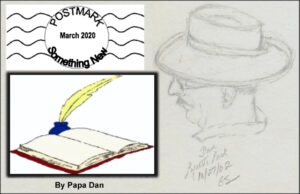
“Live long and prosper.”
“Logic is the beginning of wisdom,
not the end.”
— Mr. Spock
To download a PDF of this post, click here: ConVivio.Vulcan_Salute
===========================================================
The Vulcan Salute

During the days when “Star Trek” was a popular TV show, Mr. Spock (Lieutenant Commander and Science Office of the Starship Enterprise) taught us the Vulcan Salute. In language, it translates to “Live long and prosper.” It was a friendly, respectful greeting that those of us from the 21st century might use in a way similar to our human handshake. So, given today’s reluctance to shake hands for sanitary reasons, it might be used to become a germ-resistant cultural replacement for that time-honored gesture.
Considering the source, Mr. Spock (played by actor Leonard Nimoy) had a dramatic backstory — he had a mixed Human-Vulcan heritage, he taught a number of respectful behaviors to his human colleagues. The character’s father was named Sarek, from the planet Vulcan, and his mother was Amanda Grayson, a human. Due to his mixed-race heritage, the young Spock character had a difficult childhood, bullied on his home planet by full-blooded Vulcan children who made fun of the human emotions he inherited from his human mother. He grew up alongside his half-brother, Sybok, who was eventually cast out for rejecting logic. Although Spock was accepted in the Vulcan Science Academy, he did not enter the academy because they would never fully accept someone who was only half Vulcan. Instead, he succeeded in entering Starfleet, while spending the next 18 years estrange from his Vulcan relatives.
The evolution of the character was interesting in that the network wasn’t pleased with the mixed-race feature of the character and often airbrushed out the pointed ears of the character in promotional photos. After the first season, a rift grew between the show’s creator, Gene Roddenberry, and Nimoy because the writing of the character deteriorated into brief expressions of “fascinating” and “logical”; and more complex interactions of the character with other characters, focusing on his unique racial heritage, were rejected by the network. However, the Vulcan Salute in today’s environment has a number of useful qualities to offer to us 21st-century humans.
Many aspects of Spock’s character endured in popular culture and the boundary between the character and the actor was eventually blurred and then erased. The character was adopted as an informal mascot by NASA and was incorporated into a number of literary successes by authors like Isaac Asimov. An asteroid was named Mr. Spock in 1971 and the character, further promoted by Mr. Nimoy, became an inspiration to a number of scientists and engineers along with a number of more recent honors:
- In 2004, Spock was ranked number 21 in Bravo’s list of The 100 Greatest TV Characters. According to Wlliam Shatner, the other star of the series, “much of the acting praise and media interest in the show went to Nimoy.”
• In 2008, Unified Gamers Online Inc. (UGO) named Spock one of the 50 greatest TV characters for both the original series and subsequent movie appearances.
• In 2012, Imagine Games Network (IGN) ranked the character Spock as the second top character of the Star Trek universe, with Kirk in the top spot.
• In 2016, Adam Nimoy released his very popular documentary film For the Love of Spock, about his father and his iconic character.
• Spock (Nimoy) has been honored by a multitude of film and television institutions for his dominant role among the characters of the Star Trek franchise over fifty years, from the original pilot in 1964 to his final film performance in 2013.
• After the death of Leonard Nimoy in 2015, there has been an increase in the practice of altering the portrait of Canada’s seventh prime minister, Wilfrid Laurier, on Canada’s five-dollar note to look like Spock.
For today, if we all begin promoting the Vulcan Salute as the clinically safe and respectful greeting to replace the handshake, it may actually have a positive impact on reducing the spread of the coronavirus here in the twenty-first century.

Why don’t we give it a try? (Can you do it?)
Finally, at this difficult time in our human history, I am reminded of some words — once used in a movie but originally attributed to John Lennon. He said:
‘“Everything will turn out alright in the end.
If it is not alright, it is not yet the end.”
![]()
The Winter Solstice: Revisiting a Time for Reflection and Review
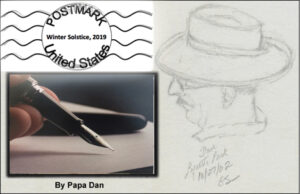
“The dance between darkness and light will always remain— the stars and the moon will always need the darkness to be seen, the darkness will just not be worth having without the moon and the stars.”
― C. JoyBell
To download a PDF of this post, click here: Winter_Solstice_Dec_2019
===========================================================
Some say that the seasons drive the way we feel about the events swirling around us. Here in America in the twenty-first century, most of us might say that, this time of year, most of our feelings are dominated by celebrations of Christmas and The New Year. We are filled with thoughts of exchanging gifts, decorating a tree, and making New Year’s resolutions. We think of these cultural forces as having always been with us — but there are stories that can take us back to their origins. If we speculate on where all of this comes from, we might consider that it all comes from one common astronomical fact — The Winter Solstice: the shortest day of the year.
This year, 2019, here in our part of the world, the official astronomical moment of the Winter Solstice takes place at 8:19 pm PST on Saturday, December 21. Since ancient times, this time of year has signaled a time for review and thoughtful reflection. Historians tell us that we can trace this back a long way. The Romans, for example, like other ancient peoples, had festivals acknowledging that the birth and death of Winter signified important trends in their world, often credited to — or blamed on — “the gods.” That habit has endured through a variety of cultures.
We are also told — although quietly — that early Christians selected the last week of December to celebrate the birth of Jesus of Nazareth to coincide with the pre-Christian celebration of the Winter Solstice. If true, it was a sensible thing to do since it was already a time celebrated with the giving of gifts and official pronouncements about the state of society. So, what’s the story?
It turns out that, for the first three centuries of the existence of Christianity, there is no record that the birth of Jesus was celebrated officially at all. In those early centuries, the two most significant “holidays” were Epiphany on January 6 — reputed to be the arrival of The Magi (“The Three Wise Men”) after the birth of Jesus — and Easter, which celebrated the resurrection of Jesus. The first official mention of December 25 as a holiday honoring Jesus’ birthday appears in an early Roman calendar from 336 A.D. BUT, you may ask: was Jesus actually born on December 25?
The answer is ‘probably not.’ The Bible doesn’t mention a date for his birthday; but the Nativity story contains some clues. Among the examples of such ‘hints,’ the presence of shepherds and their sheep in the story suggests a Springtime birth; but a lot of time went by before anyone settled on a date for the occasion. Historians tell us that the Western Roman Emperor Constantine made Christianity ‘legal’ in his empire with the Edict of Milan in 313. In 336, he is said to have formally established the birth of Jesus at December 25 (while the Eastern Empire celebrated the birth on January 6). So, the date is not planted on solid ground. Even in more recent American history, the celebration of Christmas as we know it has not been without controversy. The Puritans of colonial New England, for example, banned the observance of Christmas traditions —giving gifts, lighting candles, and decorating trees — primarily because of its pagan roots. Later, Christmas fell out of favor following the American Revolution as a rejection of a peculiarly British custom. It didn’t become an American Federal holiday until 1870.
So, whether or not we accept the story that Emperor Constantine “stole” the Winter Solstice and turned it into Christmas, this part of the calendar has for a long time been recognized as a time of reflection and review by societies and individuals associated with many beliefs and traditions.
Winter Solstice Rituals from Around the World
Setting aside for a moment the powerful Christmas traditions that dominate the modern western world in the last week of December, thousands of people around the globe will herald the Winter Solstice, the shortest day of the year, with centuries-old rituals. It is, of course, the first day of Winter, — the turning point of the year in many cultures — the moment that our hemisphere is pointed at its farthest distance from the sun. Some of the vocabulary that comes down to us from the ancients provides examples. Pagans called it the “Yule,” acknowledging the birth of the new solar year, celebrated to this day in North America by the Circle Sanctuary, one of several prominent pagan groups in Northern America. Here are a few other notable examples of Winter Solstice observances that are practiced here in our own twenty-first century:
–> 1. Catching the Sunrise at Stonehenge
England’s famous Stonehenge lures thousands of visitors during both the summer and winter solstices. Dozens of pagan and druid groups head to Stonehenge to pay tribute to the Sun on this occasion. Revelers gather at the prehistoric site of ancient stones in Wiltshire to sing, dance, play instruments, kiss the stones, and do yoga as they wait for the sun to rise. The iconic Stonehenge is known for its precise alignment with the sun’s movement and has been known as a sacred place of worship and celebration of solstices for thousands of years.
–> 2. Absorbing the First Rays of the “New” Sun
At the Newgrange Monument in Ireland, dozens of people, lucky enough to be selected through an annual lottery, get the chance to stand inside the ancient Newgrange monument in Ireland and absorb the first rays of the day during the Winter Solstice. Newgrange is a burial mound in Ireland’s Boyne Valley that is over 5,000 years old. The Stone Age monument contains a 62-foot passage that leads into a chamber that is aligned with the sun as it rises during the Winter Solstice. Between Dec. 19 and Dec. 23, around dawn, sunlight pierces through the top of the chamber and slowly illuminates the room for about 17 minutes. More than 32,500 people applied for a spot inside the chamber this year. Only 60 of them were picked from the lottery to partake in this Winter Solstice ritual.
–> 3. Soaking in “Fruit Baths” in Japan
In Japan, people traditionally soak in hot baths filled with yuzo citrus fruits to welcome the Winter Solstice and protect their bodies from the common cold. During a typical solstice celebration, children from a local preschool share a dip in a traditional yuzu tub as dozens of the yellow yuzu fruits float around them on the surface.
–> 4. Getting Scared by the Krampus in Austria
Hordes of revelers descend on Hollabrunn, Austria, each year during the Winter Solstice to watch a swarm of people dressed like Krampus — the half-demon, half-goat counterpart to Santa Claus. They terrorize and tease the crowd in giant horned masks, sharpened teeth, fur body suits, and whips. The traditional ‘Krampus Run’ in Austria is believed to ward off bad spirits near the Winter Solstice, but it is also a source of entertainment — “It is weird, but it’s fun,” according to local scholars. “It’s sort of like Halloween, you get to dress up in these really disgusting costumes. You get to do stuff you don’t normally get to do.”
So, what do these ceremonial observances have in common?
1. Taking advantage of the opportunity to “start over” as the Sun does every year.
2. Reflecting on the things that have happened over the past year as the Sun dies — and “closes the curtain” on a portion of our lives.
3. Taking part in the rebirth of the Sun and, with it, starting our own lives over again by learning lessons from what has gone before and finding ways to make the coming year better than the last one.
So, Can All of this celebratory stuff actually make a difference?
While I have tried (and occasionally failed) over the past year to avoid writing about our corrosive politics and the bad news that follows from it, maybe this Winter Solstice can provide an opportunity to recall good things that have happened that we might be able to build on.
Let’s take a look at ten examples of Good Things
1. In 2019, the most diverse class of lawmakers in history was sworn into the 116th Congress: the most women ever (105 in the House, 25 in the Senate); a record number of Hispanic and Latino members (45 in the House, 5 in the Senate); 56 African American members (53 in the House, 3 in the Senate); 30 members who are Asian American; a record number of Native American, Pacific Islander Americans; the most diverse religious representation ever (Christian Protestant, Catholic, Jewish, Mormon, Buddhist, Muslim, Hindu, Greek Orthodox, Pentecostals, Unitarians, and Adventist); and 96% have a college education.
2. Sixteen-year-old Greta Thunberg was honored as Time Magazine’s Person of the Year for starting a world-wide movement of young people to motivate world leaders — notably by speaking at the General Assembly of the United Nations — to urgently address the threat of climate change. Millions are paying attention at the highest levels. (Only one person we know of was publicly displeased with this news.)
3. The European Union banned single-use plastic bags, plates, forks, and straws in Europe. This act could avoid nearly $25 billion worth of environmental harm by 2030. The U.S. is … uh … well … (not) following their lead, slowly, reluctantly, from well behind … but … well … it’s early (isn’t it?) California and New York were the first U.S. states to follow this example.
4. A Federal Judge stopped the Trump Admin from ending no-cost birth control that was subsidized in the Affordable Care Act. (The decision will be appealed.)
5. UCLA gymnast Katelyn Ohashi scored a perfect “10” on her floor routine, making it look fun and effortless, with a jaw-dropping final landing!
6. Chicago became the largest city in US history to elect a black female, openly gay mayor.
7. The Scripps National Spelling Bee crowned eight co-champions when the kids ran through five consecutive final rounds of perfect spelling, causing the contest to run out of words. (I guess someone is learning something out there.)
8. Michelle Obama’s memoir Becoming in becoming the most popular memoir in history, selling more than 10 million copies in one year (and still counting) and staying on the NYT top ten non-fiction books for a record number of weeks (53 as of this writing).
9. A 48-year-old Cookie Monster from Sesame Street made his baseball debut — singing “Take Me Out To The Ballgame” at Wrigley Field during the 7th inning of a Chicago Cubs game. Thousands of old folks and young kids took photos.
10. Solar and wind power have started to gain popularity. Today, one third of power around the world is being generated by renewable sources and coal is now more expensive than wind or solar. Finland just committed to phasing out coal within ten years. So it begins …
What Does All This Stuff Have to Do with the Winter Solstice?
Maybe good things begin with good ideas. The Winter Solstice reminds us that the world is ready to remake itself once again. Those who try to influence the outcome, especially in concert with others, may be surprised at how much influence is possible. Maybe an opportunity like the Winter Solstice can cause folks like us (you know, Michele, Greta, Cookie Monster, and the rest of us) to pause, and reflect, and then maybe decide to make a difference and act in the coming year as the Sun rises out of the darkness of Winter. It is easy to moan about how cold and dark it is on the shortest days of the year; but it doesn’t take much more effort to consider how to help make it brighter when the Sun rises. And we don’t have to do BIG things. The list of ten good things we just noticed above did not start big. They started small, with individuals deciding to do something small and then joining others to do it together. We can decide to do some small things in our own families, our neighborhood, our town, you know, right here and right now. And, we can seek out others, let them know what changes we’d like to be part of, and join them to make them happen.
So, after the “reflection and review” that the Winter Solstice evokes, can the coming sunlight bring with it a call for action? But what kind of action and by whom? When we were kids, we are taught that our voices are very effective tools. And in a country like ours, we select representatives to increase the reach and volume of our voices. So, it would make sense to let those representatives know what kind of action we intend.
Some sample pathways:
https://www.feinstein.senate.gov/public/
https://www.harris.senate.gov/contact/
https://swalwell.house.gov/
https://govapps.gov.ca.gov/gov39mail/
Finally, I’d like to cite two writers I have mentioned before who have offered useful advice for this time. One is poet Annie Finch, the author of a poem called “Winter Solstice Chant.” In an interview, she reminds us of the two-step process of moving from darkness to light: “If you don’t experience the darkness fully, then you are not going to appreciate the light.” The other — a well-known and eloquent gentleman — advised us once to “become the change we seek.” It might be worth a try as the Sun, at its darkest point, prepares to rise.
Postscript — December 22, 2019: https://www.cnn.com/travel/article/stonehenge-winter-solstice-trnd/index.html
![]()
Let Me Help

“Don’t discount the power of fiction
to change the world;
it has happened over and over
throughout our history.”
Click here to download a PDF of this post:
Let_Me_Help_Final
City On the Edge of Forever
The television series “Star Trek” was a collection of 79 time- and space-travel stories that appeared from 1966 to 1969. As a teenager, it was my favorite TV show. The episodes were set in the future — some time in the 2200s. In the episode titled “The City on the Edge of Forever,” written by Harlan Ellison, the Starship Enterprise is flung back in time from the 23rd century to the planet Earth in the year 1930. Captain Kirk, Mr. Spock, and Dr. McCoy find themselves in New York City, which is suffering in the depths of the Depression. They meet Edith Keeler (played by Joan Collins) who is in charge of a soup kitchen set up to feed the (many) hungry. Captain Kirk, of course, falls in love with her. She senses that Captain Kirk and his two companions are distressed about something. She, of course, has no clue that they are stuck three hundred years into their own past, not sure how they are going to get back to their own time. They have this conversation:
Edith Keeler: Why does Spock call you “Captain?” Were you in the war together?
James T. Kirk: We served together.
Edith Keeler: And you don’t want to talk about it? Why? Did you do something wrong? Are you afraid of something? Whatever it is, Let Me Help.
James T. Kirk: Let Me Help . . . A hundred years or so from now, I believe, a famous novelist will write a classic using that theme. He will recommend those three words even over “I Love You.”
Edith Keeler: A century from now? Who is he? Where does he come from?
Where will he come from?
James T. Kirk: Want to hear a silly answer?
Edith Keeler: Yes.
James T. Kirk (points to the sky): A planet, circling that far left star in Orion’s belt, see?
— City on the Edge of Forever, Earth, 1930 (aired on TV April 6, 1967)
Captin Kirk tells her that this novel “changed everything.” From our perspective here in the 21st century, we realize that, if this novelist published his story about 100 years from that day in 1930, it would appear some time in the next few years here in our own twenty-first century. ………… More on that later.
The plot of this Start Trek episode itself focused on the dilemma facing the time travelers in light of “The Prime Directive,” also known as “Starfleet General Order #1.” The “noninterference directive” prohibited Starfleet crews from doing anything that interfered with the internal and natural development of alien civilizations.
While trying to figure out how to get back to their own time, Spock uses his tricorder to recreate the “actual” history of the time they are visiting and discovers that Edith Keeler was supposed to die that year in a traffic accident. Examining an altered timeline accounting for their interference, Spock learns that, if her life was spared, Keeler would go on to found a pacifist movement, causing the United States to delay its entrance into World War II and allowing Nazi Germany time to develop nuclear weapons, with which they will conquer the world. Kirk admits his love for Keeler, and Spock answers that Keeler must die in order to prevent millions of deaths.
Kirk is faced with a harsh reality: Edith Keeler must die in a traffic accident — which they could easily prevent — in order for history to proceed the way it must. So, at the climax of the episode, we see Captain Kirk restraining Dr. McCoy, preventing him from saving her life, to save the future of the human race — that is, to save us. Dr. McCoy, of course, doesn’t understand and shouts, “Do you know what you just did?!” Spock answers, “He knows, Doctor, he knows.” After that scene, a heartbroken Captain Kirk and his crew return to the Starship Enterprise, and he orders them to “get the hell out of here” — back to their own time.
Well, What About the Novel? Is this Story About Us?
Fifty years ago, in addition to the time-travel and space-travel aspects of this story, the tragic love story of Edith Keeler and Captain Kirk appealed to me. For those of us who live in this time of gathering turmoil here in 2019, a novel “expected” to appear about a century after 1930, titled “Let Me Help” — a novel that we are told “changed everything” in OUR time — might pique our interest even more. We might wonder, as the Edith Keeler character asks about this novelist, “Who is he? Where does he come from?” And, most important to us, what necessary changes would such a novel inspire? Looking ahead to OUR next few years leading up to 2030, presumably the aftermath of the current struggle, we can imagine what changes will be needed and how the novel, and its title, might inspire those changes.
Looking Ahead: A Novelist Writes in the Year 2030 — What might he say?
In the year 2030, an increasing number of people are likely to realize that a lot of very serious problems can be traced to some societal changes that began around 2016. A fictional novelist takes up his pen and writes a story — a piece of fiction — about the beginning of a small movement called “Let Me Help.” In the novel, a small group of friends, about a dozen or so, start meeting in a bistro in the Mission District of San Francisco, initially to whine about how bad things had gotten and how ineffective the government had become in addressing a series of growing problems — local and national. One afternoon, this group gathered around a table in a bistro and made a list of their observations:
• While the unemployment rate has reached a new low, the number of people under-employed (i.e., working full time at one or more jobs but not earning enough to afford a decent American life) is increasing. Why? With the diminishing influence of labor unions in many parts of the country, large numbers of workers cannot afford basic health care, childcare, or home ownership.
• Many of our kids, even in otherwise middle-class communities, go to school hungry. Some communities have programs that provide healthy school lunched, but those programs are few and far between. In spite of the strength of some parts of the economy, the homeless population, noticeably in San Francisco, has dramatically increased.
• More and more employed Americans are forced to live farther from their workplace, lengthening the work day, clogging freeways, and adding to air pollution.
• Increased use of fossil fuels continued its indisputable harm to the economy and health.
• In many parts of the country, financial support for public schools, which used to be an international source of pride for America, has diminished. As a result, test scores, especially in science and math, have declined and fallen behind those of other developed nations. Ignorance of American institutions is increasing. Basic job skills are in decline.
• In many parts of the country, a rash of natural disasters — hurricanes, tornadoes, floods, earthquakes and wildfires — have destroyed communities near and far, leaving large numbers of families without the means to rebuild their lives. In some cases, the need is temporary. In some cases, the need is ongoing.
At the end of the second chapter of the novel, the group reviewed their list, shaking their heads at how far everything had fallen from the hopes they had all grown up with. One member of the group decided to post their list on a couple of social media platforms, along with some local examples of ways that San Franciscans were being harmed by these issues. His post ended with a public invitation to join a small group planning to organize efforts to help locals who are affected by the lack of effective government attention to these and other local issues. The group gave themselves a name “Let Me Help” and scheduled their next meeting on a Saturday afternoon in two weeks. They hoped to acquire a handful of new members from their social-media invitation and figured that they could organize themselves to help out at some local soup kitchens and homeless shelters. Maybe they could organize tutoring to increase job skills and help people apply for jobs. Pleased with themselves, they ordered a round of drinks and turned their attention to a ballgame on the big screens.
‘Let Me Help’ Becomes a ‘Thing’
Two Saturdays later, the dozen or so people who had met to whine and make their list came back together to plan some next steps in their little project. One by one, as they approached their favorite bistro, they were stopped in their tracks in amazement. Traffic on the nearby streets was clogged. Once they were able to walk up to the bistro, they found a crowd of several hundred people had filled the sidewalks on both sides of Van Ness Avenue and bulged out into the street blocking traffic. People wanted to know where “Let Me Help” was meeting and they wanted to sign up to join the effort. Some were a bit annoyed that there seemed to be a noticeable lack of organization for such an important project.
What To Do?
This little group had not expected anything like this. After stumbling round awhile, they were able to herd the crowd over to the public square next to the BART station and one of them stood on a bench and spoke. It didn’t take long to discover that these people who responded to the online invitation were attracted to the idea that something could be done to mitigate the inadequacy of government to address the problems that had emerged in recent years, and they were hungry for an opportunity to help. After some discussion, a sign-up list was created with contact information and promises were made to set a new meeting date (at a larger venue) and organize some specific committees to address some of these issues at the local level.
To make a long story short …
• Committees were formed over the next month.
• Groups collected food donations and delivered them to several homeless shelters and soup kitchens in The City. Some went to a City Council meeting and petitioned the City to have the “Let Me Help” group registered as an official local charity. Arrangements were made for the group to meet with City officials about some long-term proposals to combat hunger and homelessness in San Francisco.
• Two local grocery stores pledged to start an ongoing program of excess food deliveries. A local hotel owner pledged a sizable donation; and a small facility was identified in one of his buildings to store supplies and eventually, serve members of the public.
• Using social media, “Let Me Help” groups were formed throughout the Bay Area with similar results in six cities.
• Stories appeared in the local newspapers and reported on a local TV station. The local story was picked up in the New York Times, and later CNN, describing the organizational model initiated by the small SF group.
• Within five months, copy-cat “Let Me Help” groups were formed in 25 cities in ten states. Local newspapers spread the word, initiating some competition among cities — rising to the level of a twelve state capitals — you know “Our state knows how to do this better than … “ and so it went, until …
• A low-level State Department official in Washington D.C. brought the story to the attention of the Secretary of State, who …
• At a meeting in Vienna of the newly-constituted Group of Seven Plus (G7+3) Alliance, the U.S. took the lead on a project to partner with ten national government agencies and make “Let Me Help” an international agency for supplying food, temporary housing, and employment support for citizens of all participating countries.
• The United Nations met in New York to discuss making “Let Me Help” a UN-sponsored, internationally recognized entity for standardizing border-crossing protocols and immigration support for all UN member nations. An interesting by-product of this effort was that attention was drawn to large numbers of people — both citizens and immigrants — in member nations who are living without basic necessities. The program expanded and many lives were improved.
The “Let Me Help” Novel Tops the ‘NYT Best Seller List’ for the Ninth Week
Let’s not forget that all of this takes place on the pages of a novel. A very good novel … just a work of fiction … OK, a novel that hasn’t yet been published …. But, in the novel, with such an uplifting and optimistic work of fiction discussed on talk shows and in literary magazines around the world, something interesting happened. A well-known former U.S. First Lady made the book the topic of her first speech to the world in her capacity as the newly-elected Secretary General of the United Nations. She asked, “Is it possible that this story could become OUR story? You know — you and me, all of us? Do we have what it takes to become the change we all have longed for since, well … you know … since we seem to have paused our world-wide commitment to … uh … you know, doing the right thing?” Do we have the humanity? If your answer is yes. Let Me Help. Here is how I’d like to help … “ She made a list of suggestions of programs that government can initiate and a list of existing programs to which individuals around the world can support.
And so it was …
And, of course, it was fiction — just a story in a novel … a novel to be written in our time — as foretold in a Star Trek episode that takes place in our future … and in our past … that we saw fifty years ago.
Just as Captain James T. Kirk said in a New York soup kitchen back in 1930 … and … well, will say in a couple of hundred years as captain of the Starship Enterprise, the novel “changed everything.”
Everything.
So, what about us?
I bet we could generate a list of existing programs that will accept our small donations that can make a difference for lots of people who need help. Here are just a few:
• World famous Chef Jose Andres has an organization called the World Central Kitchen. He brings his “kitchen staff” around the world to places devastated by earthquakes and hurricanes and set up kitchens where he has fed thousands of people who had lost their homes. His motto is: ”Wherever there is a fight so that hungry people may eat, we will be there.” Anyone can visit his website (https://wck.org/ ) and make a donation.
• Grace Cathedral in San Francisco (we go there for their Christmas music) co-sponsors The Winter Interfaith Shelter in collaboration with the San Francisco Interfaith Council and run by Episcopal Community Services. The Interfaith Shelter provides dinner, breakfast and a dry place to sleep for 60-100 homeless men during the coldest and wettest time of the year. https://gracecathedral.org/winter-interfaith-shelter/
• We have a neighbor who invites us to donate needed items to the local SPCA, especially to temporarily take care of animals who have been orphaned by the wildfires in northern California. Almost everyj town has one and they accept things like bedding (any used sheets, blankets, towels), newspapers, kitty litter, pet food, and more. My old friend Lew (OK, don’t tell him I said he’s old) actually volunteers at his SPCA in Monterey.
• The Alameda County Food Bank provides food for 116,000 people who turn to them each month (more at Thanksgiving). Take a look at www.accfb.org. A $25 donation will help to provide $175 worth of food.
Dear Readers:
—-> I bet you have a favorite charity to recommend that makes life better for those who need help. If you do, send me your “Let Me Help” suggestions and I’ll spread them around to our ConVivio readers. I bet we can help.
—-> Which of us will step up and write the novel that could change everything? You have ten years — plenty of time, right?
![]()
Yosemite — October, 2019

“The dry waterfalls and sparse rivers of Autumn simply provide a promise
for the coming of Spring.
The bright Fall colors are a reminder
of that promise.”
— PapaDan
= = = = = = = = = = = = = = = = = = = = = = = = = = = = = = = = = = = = = = = = = =
As I’ve written during previous Autumns in Yosemite, this wonderful valley is always changing. The two most prominent features of Yosemite are “Permanence” and “Change.” (See an old ConVivio piece on that subject.) What’s the Peter Allen song — “Everything old is new again.” Yosemite Valley certainly qualifies as OLD — having been carved by a slow-moving glacier beginning about two million years ago, with its sturdiest rocks (e.g., Half Dome) weighing in geologically at about 87 million years. AND as always, it is NEW again à This year, this month, we observed that the Fall Colors are more dramatic than ever (more on that later).
Another piece of Yosemite news in the “Old-and-New” category is that Yosemite National Park has re-acquired its old revered names — the Hotel is now again named The Ahwahnee and Curry Village and Wawona have their names back, as does Yosemite Lodge, and others. I have known these names for fifty years, and they mean something to me. The lawsuit was settled in July after a three-year fight over ownership of the names.
(Talking with a waiter in the Ahwahnee dining room, I observed that the fight was over money. He corrected me and explained, linguistically, that the problem was caused by ‘politics.’ He said, “ ‘politics’ is a word with two parts: ‘poli,’ meaning many, and “tics,’ meaning small blood-sucking creatures.” I expect to use that line again.)
The Ahwahnee Hotel is certainly old by our own standards, having been built in 1927. BUT, what’s interesting to me is this: the name Ahwahnee was given to this part of the valley by the native Ahwahnichi Tribe about 600 years ago — long before the National Park Service or even the United States of America existed. So, the idea that a 21st-century hospitality management company can claim to “own” that name is ridiculous. But now, sanity has been (temporarily) restored (repurchased) and some good old things are new again.

The National Park Service quickly, proudly, replaced the signs.
Yosemite’s Dramatic Fall Colors — October, 2019
We tend to think of the Stanislaus National Forest, where Yosemite is located, as being dominated by evergreen trees like the Giant Sequoia Redwoods, Ponderosa pines, incense-cedar, Sierra Juniper, white fir, and the like. With that in mind, most of us don’t expect there to be much in the way of dramatic Fall colors. BUT, Yosemite Valley is also populated by California Red Fir, various varieties of Hemlock, California Nutmeg, Black Oak, Alder, Birch, Dogwood, Laurel, Big Leaf Maple, Quaking Aspen, Cottonwood, and Willow. All of these punctuate the broad green background with prominent splashes of reds, yellows, golds, blues, ambers, and combinations of those. Here are just a few examples of photos I took just last week in Yosemite:




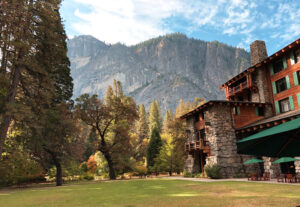
And The Water — October, 2019
As in Autumns past, one of the most striking features of Yosemite in October is:
The silence.
Unless you visit Yosemite in the Fall, when the waterfalls in the valley are dry, you might not realize how much the roar of Yosemite Falls dominates the sound of the valley in the Spring. When the waterfalls are not running, there is a remarkable silence.
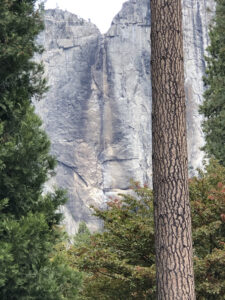
On the left, you can see the place where Yosemite Falls is normally pouring its heart out in the Spring. Here in October — not a drop. The water-scarred granite face of the mountain is bone dry.
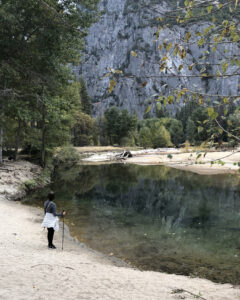
Here, you can see the Merced River where it meanders through the valley. Now, in October, it is lower than I have ever seen it and it’s not moving. In the Spring, on the spot Gretta is standing in this photo, she would be standing waste deep in water. Where I am standing to take this photo, I would be ankle deep. We were told that, even though there was a significantly wet winter this year, more of the precipitation came down in rain and fell later than usual. In fact, you can see the hundreds of fallen trees that were brought down this past winter by the flooding. And, a lot of the snow that had fallen melted quicker than usual between Spring and Fall, causing the waterfalls to dry up sooner and the river to recede more than usual.
Looking Ahead to Spring, 2020
Gretta and I also come to Yosemite every April, for our anniversary, and one thing is a constant in April — Yosemite Falls is always flowing with its usual vigor. The sound is not merely of running water, but of chunks of ice and fragments of logs from the high country crashing down on the rock formations between the peak of the falls and the valley floor. All of that — plus the constant rushing of the water — creates a polyphonic orchestration complete with percussion, and you can hear it everywhere in Yosemite Valley from Half Dome to El Capitan to Glacier Point. We’ll be back in six months to see, and hear, the results that we have come to expect.
The climate is changing. We’ll just have to keep monitoring our best gauge of the changing colors and the water — here in Yosemite Valley. It speaks to us. Our task is to watch and listen.
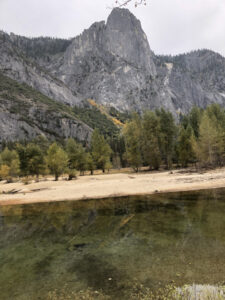

![]()
Reflections On Change — It’s Fall, Right?
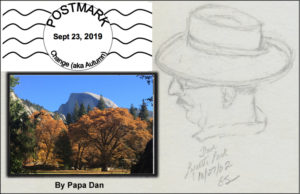
“One cannot make the words too strong.”
— Mark Twain
Click here to download a PDF of this post: Its_Fall_Change
It’s Autumn (aka Fall)
This year, Autumn begins on Monday, September 23 and ends on Saturday, December 21, here in the Northern Hemisphere. During this season, daylight hours become noticeably shorter and the temperature cools considerably. It is also the time when crops and fruits become ready for harvest. In English jargon, over time it has come to be known as The Fall because most leaves fall to the ground and change the color and texture of the landscape dramatically. As a result, all of this change provides great beauty to see in the Fall; and each region has its own style.
Vermont through a windshield—Fall 2013
 Now, some people will tell you that you must travel to New England to see “Real Fall Colors.” OK, Gretta and I did that in the Fall of 2013 just to see the colors and — OK — they do know how to do colors in the northeast when Summer turns to Fall. Vermont, New Hampshire, Connecticut, even Maine, did strut some colorful stuff. BUT, while that experience was spectacular, I’m here to tell you (among other things) that you don’t have to travel to the Northeast to see “Real Fall Colors.” Let’s not forget that we live in California.
Now, some people will tell you that you must travel to New England to see “Real Fall Colors.” OK, Gretta and I did that in the Fall of 2013 just to see the colors and — OK — they do know how to do colors in the northeast when Summer turns to Fall. Vermont, New Hampshire, Connecticut, even Maine, did strut some colorful stuff. BUT, while that experience was spectacular, I’m here to tell you (among other things) that you don’t have to travel to the Northeast to see “Real Fall Colors.” Let’s not forget that we live in California.
So, whadda We got?:
— In southern California, the most notorious source of “Fall colors” is the Black Oak, which turns its leaves to a nice golden yellow.
— In northern California, right here in the Bay Area, big-leaf Maple trees are famous for showing off their gigantic deeply reddened leaves before they fall to the ground.
— Farther north in Humboldt County, we see Oregon Ash, Dogwood, Red Alder, White Alder, Cottonwood, and (watch out!) Poison Oak. Each of these is spectacular and, when you can see them all at once … Whoa! … there are no words …
— In Shasta County, especially around Burney Falls, you can see ALL of those plus Vine Maple, Buck Brush, Deer Brush, Red Flowering Currant, and Squaw Bush — all turning from various shades of green to a profusion of reddish, orangish, yellowish, and brownish hues.
— AND THEN there’s the wine country(ies) throughout California, … as the grapes sweeten for harvest and prepare themselves to become the best wine in the world, the vines and ground cover can fill your eyes with multiple shades of greens and reds and even blues and yellows … well … OK, so you’re going to tell me that it doesn’t make sense to try to describe the dramatic changes that happen in the Fall with words, and you’ll be right. AND THEN, you’ll tell me that showing just one picture, or even two, as examples of this phenomenon will fall miserably short of the task. Below — First: Fall Colors in a California Vineyard — Second: And Up Close.
But, well, you gotta look at some colors before we talk about this subject some more.


So, before we continue, you may ask, what exactly is the subject? Is it really about the colors? Or is it about the only constant we can be sure of in this world — change.
Change Is Gonna Come — Oh, Yes It Will
Of course, all of these magnificent colors appear and the leaves fall to the ground because they are dying. Dying. You know, the living things that grow out of the Earth bud and blossom in the spring, they live their lives all summer, and then they die in the Fall. They must die because the trees and vines must shed their growth, spend the Winter in a comatose state — also known as hibernation, suspended animation, … uh … you know, “death” — so they can be reborn and come back to life in the Spring. But, we have to rake up the dead leaves first — And make no mistake, they are dead. Those are the rules.
It’s about change. It’s about change that must happen. But you knew that …
So, We Look to the Poets
Our poets go out of their way to move us past the obvious and convey to us more than the appearance of stunning changes like those we experience in the Fall; they are inspired by the cool fresh air and the end of oppressive inland heat; they celebrate the wonderful produce of all of that struggle (especially in wine country); AND, they also spend some effort marveling at the “terrible beauty” of the cycle itself — birth to life, life to achievement, achievement to beauty, beauty to death, and death to rebirth. Each of these steps must follow from the steps before them. So, often, poets are trying to reveal how all of this inevitable change feels for us humans and what expectations those feelings generate. So, how do we humans experience change?
Let’s ask some of our poets about change, through eyes that view the colors of the season:
- In this one, a young Shakespeare seems to focus on the sense of loss that Fall brings.
That time of year thou mayst in me behold — Sonnet #73 by William Shakespeare
That time of year thou mayst in me behold
When yellow leaves, or none, or few, do hang
Upon those boughs which shake against the cold,
Bare ruined choirs, where late the sweet birds sang.
In me thou see’st the twilight of such day
As after sunset fadeth in the west;
Which by and by black night doth take away,
Death’s second self, that seals up all in rest.
In me thou see’st the glowing of such fire,
That on the ashes of his youth doth lie,
As the death-bed, whereon it must expire,
Consumed with that which it was nourish’d by.
This thou perceiv’st, which makes thy love more strong,
To love that well, which thou must leave ere long.
- Next, Robert Frost appreciates the colors of the season, but laments the loss that follows.
Nothing Gold Can Stay by Robert Frost
Nature’s first green is gold,
Her hardest hue to hold.
Her early leaf’s a flower;
But only so an hour.
Then leaf subsides to leaf.
So Eden sank to grief,
So dawn goes down to day.
Nothing gold can stay.
- In her book Time and Place, local poet Lauren de Vore reflects on the responsibility for introspection that comes with the expectation of change. In the chapter on Autumn, her sonnet Taking Stock identifies the change of Autumn as something much more than colors.
Taking Stock by Lauren de Vore
October is my time to introspect,
As like a gleaner following the scythe
I cull through recollection’s field and, eyes
Attuned to see, unflinchingly reflect.
It’s easy to tot up the obvious,
That never-ending list of tasks that should
Be done before the rains arrive and would
Were I, in this, not kin to Sisyphus
Th’intangibles are harder to appraise;
Did I come through for those who needed me?
Did kindness guide my words and honesty
My acts, or did I tread a selfish maze?
One must at times take candid look within
In striving for a life that’s genuine.
- Frank DeRose comes right out and tells us that Autumn is gonna bring important change that will matter very much to us humans, well beyond the colors we see around us.
To Change Autumn is the Season by Frank DeRose
Colors turn,
Leaves fall.
For everything there is a time.
Autumn is a time for change,
A time for being human,
A time to reflect
(On warm summer nights),
And a time to anticipate
(Fiery winter days).
We are human.
Ever-changing,
Ever-moving,
Endlessly.
We are autumnal beings.
Yellow with happiness,
Orange with warmth,
And red with anger.
Red with love.
Red with hatred.
We are as cool
As the crisp breeze,
And as warm
As the colors around us.
To everything there is a season,
For everything there is a time.
A time to lie complacent,
And a time for change.
Autumn is the time for change.
- And our dear old friend Mark Twain brings this Autumnal experience to a close by showing us, entirely with his words, the natural climax of the change at the end of Autumn — words that convey this miracle in ways that a photograph could never do. He shows us the New England ice storm that brings the Fall to its dramatic conclusion. In front of an audience one day, Mr. Twain, rambled on like this (it is my favorite paragraph in all American literature):
— If we hadn’t our bewitching autumn foliage, we should still have to credit the weather with one feature which compensates for all its bullying vagaries — the ice-storm: when a leafless tree is clothed with ice from bottom to top — ice that is as bright and clear as crystal; when every bough and twig is strung with ice-beads, frozen dew-drops, and the whole tree sparkles cold and white, like the Shah of Persia’s diamond plume. Then the wind waves the branches and the sun comes out and turns all those myriads of beads and drops to prisms that glow and burn and flash with all manner of colored fires, which change and change again with inconceivable rapidity from blue to red, from red to green, and green to gold — the tree becomes a spraying fountain, a very explosion of dazzling jewels; and it stands there the acme, the climax, the supremest possibility in art or nature, of bewildering, intoxicating, intolerable magnificence.
One cannot make the words too strong. — Mark Twain
So much for the changes that Fall brings. Along with all of these features, the coming of Fall can remind us humans, at least subconsciously, of the other kinds of change we come to expect — if we are optimists — or the kinds of change that we want to see, that we hope for, that we desperately need to see, that we may fear are out of our reach, as we look around at the disappointing world of the time in which we live.
- Among our poets, songwriters have expressed some of our deepest feelings. Speaking for many of his time (late 1964) and of our own who have grown up in hard times, San Cooke wrote a song that never quite made it to the top of the charts, but still insisted on optimism:
A Change Is Gonna Come by Sam Cooke
I was born by the river in a little tent
Oh and just like the river I’ve been running ev’r since
It’s been a long time, a long time coming
But I know a change gonna come, oh yes it will
It’s been too hard living, but I’m afraid to die
‘Cause I don’t know what’s up there, beyond the sky
It’s been a long, a long time coming
But I know a change gonna come, oh yes it will
I go to the movie and I go downtown
Somebody keep tellin’ me don’t hang around
It’s been a long, a long time coming
But I know a change gonna come, oh yes it will
Then I go to my brother
And I say brother help me please
But he winds up knockin’ me
Back down on my knees, oh
There have been times that I thought I couldn’t last for long
But now I think I’m able to carry on
It’s been a long, a long time coming
But I know a change is gonna come, oh yes it will
Experience Teaches; and We Must Learn
So, those of us who look around and see so much that needs to change, so many who desperately need those changes, and so many obstacles stacked up against those changes — what’s a person to do? It seems increasingly clear that it will not be enough to be an optimist, like Sam Cooke, and rest assured that “Change is gonna come — yes it will.” So, we wonder if there are things that some of us urgently need to be doing to bring the changes that the seasons will not bring on their own? Once again, we are reminded of the words of Edmund Burke:
“All that is necessary for evil to triumph is for good men to do nothing.”
A poet of our own time gave us some further advice: “BE the change you seek,” he said. So, we know from the experience of the Fall that change is inevitable. Nothing stays the same and for very good reasons. Some things must die to make way for other things that must arrive. But must we just wait for it like Sam Cooke? Edmund Burke taught us long ago that is the worst thing we can do, and history has proven him right. We can look around and see that some people are MAKING change happen that is seriously evil while we watch — change that unravels progress we thought we had made. Positive changes we thought would endure in the way humans treat each other are reverting to hatreds we had hoped were diminishing. Opportunities for people to raise their standard of living are receding before our eyes in our country — and we see people in power making that happen by their words and actions. Must we merely wait and watch them do their damage and hope for the best? OR, does the optimism of San Cooke carry responsibilities with it to change the course of change itself?
It happens in nature as well as in human behavior. In a world with a warming climate, the changes that come at the end of Fall will be disastrous — we can see it happening if we are paying attention — the necessary ice melts; the rainfall floods the fields instead of nurturing the crops; the bees required to pollinate everything are dying out; the colors are different.
The hard truth is that we know why those things are happening. We know which industrial human behaviors are causing those changes. Yes, it turns out that actually can control the change. If we just wait and watch, others will control the outcome. Some are actually valuing dollars ahead of human survival. How can we make change happen that we need, instead of allowing others to dictate the destructive changes that we can see coming? There’s work to do. We do need to BE the change we seek.
We’ve learned that we are not likely to be successful acting alone. We’ve been told — it takes a village; it takes unions; it takes a unified political party; it takes a committed nation, it takes partnerships and alliances that cross all kinds of borders. Forces that divide and impede our collective efforts must be recognized for the harm they bring and must be defeated. These are hard words; but they are the lessons we have learned.
So, Fall is the time to take stock of our behavior and take responsibility for the effect we have on the direction of change. We have seen what happens when we do nothing. It is not a mystery. We must help each other survive the Winter and bring on the Spring.
![]()
The Lady in the Harbor — An Attempt to Revise Her Welcome

The Statue of Liberty has welcomed
immigrants to America since 1886. It has
proudly displayed Emma Lazarus’ poem
“The New Colossus” as the key statement
of that welcome since 1903. The poem has
been a central element of our American
heritage ever since. — PapaDan
Click here to download a PDF of this article: Cry_Shame_ConVivio_August_2019
= = = = = = = = = = = = = = = = = = = = = = = = = = = = = = = = = = = = = = = = =
A Startling News Story
On Tuesday, August 13, Ken Cuccinelli, acting director of U.S. Citizenship and Immigration Services (essentially, the head of the nation’s legal immigration system) raised eyebrows, and a lot of hackles, when he rewrote a central line of the poem at the base of the Statue of Liberty. (https://www.denverpost.com/2019/08/14/ken-cuccinellis-statue-of-liberty-poem/)
He rewrote the line this way: “Give me your tired and your poor who can stand on their own two feet and who will not become a public charge.” This “revision” of this essential part or our American heritage was part of his explanation of rule changes that make it more difficult for immigrants to obtain green cards if they take advantage of government benefits, such as food stamps and other assistance programs. Cuccinelli’s so-called “public charge” doctrine clearly targets poor immigrants and those most in need of sanctuary.
The details — and the purpose — of this new immigration doctrine, along with Cuccinelli’s edit of the poem on our welcoming statue, combine in a stark refutation of the entire spirit of Emma Lazarus’ poem. Lazarus wrote the poem in 1883 as part of fundraiser sponsored by newspaper tycoon Joseph Pulitzer to raise money for construction of the base for the Statue of Liberty. Lazarus herself came from a well-to-do Jewish family and became an advocate for immigrants in the early 1880s after witnessing the plight of thousands of newly arrived Eastern European Jews, forced to live in squalid overcrowded tenements, with little to no access to clean water, sanitation, education, or decent jobs. Her compassionate vision for America, a vision held by many others of that time (since her poem was selected from among many other submissions to be permanently mounted on the statue’s base) is clearly articulated in the sonnet’s closing lines:
The New Colossus
by Emma Lazarus (1883)
Not like the brazen giant of Greek fame,
With conquering limbs astride from land to land;
Here at our sea-washed, sunset gates shall stand
A mighty woman with a torch, whose flame
Is the imprisoned lightning, and her name
Mother of Exiles. From her beacon-hand
Glows world-wide welcome; her mild eyes command
The air-bridged harbor that twin cities frame.
“Keep, ancient lands, your storied pomp!” cries she
With silent lips. “Give me your tired, your poor,
Your huddled masses yearning to breathe free,
The wretched refuse of your teeming shore.
Send these, the homeless, tempest-tost to me,
I lift my lamp beside the golden door!”
As a member of an immigrant family, I find the continuing attack on immigrants to be powerfully hypocritical. It could be comical if it weren’t such a serious attack on the fundamental values of this nation’s identity, long held to be “a nation of immigrants.” My own grandparents came here to escape the poverty they knew in Southern Italy. They came with nothing to offer — they were illiterate and without valuable skills. A check of Mr. Cuccinelli’s family tree reveals that the rule change he is championing would likely have excluded his own Italian immigrant ancestors. (https://www.motherjones.com/politics/2019/08/cuccinellis-family-tree-suggests-his-new-immigration-rule-might-have-blocked-his-ancestors/) To our nation’s embarrassment, this rule change is just the latest in a series of immigrant exclusion efforts, counteracting the stated purpose of the immigration and asylum system imbedded in American law. Despite this recent disappointment, I must remember, even though this country sometimes falls short of its stated values, those values are still the ideals that have guided this country and its people for a long time.
But enough from me — let’s move on to a more interesting question: What would a revision of Emma Lazarus’ poem look like if one tried to “bring it up to date?” To answer this question, we turn to a familiar ConVivio contributor — our favorite local published poet, Lauren de Vore. You have seen her poetry presented in this space several times before.
What follows is Lauren’s description of her process in writing her revision of the original Emma Lazarus poem to fit our modern era — and, of course, the poem itself: “Cry Shame!”
Lauren’s Contribution
I first wrote this revisiting of “The New Colossus” in the fall of 2014. If you cast your mind back five years, you’ll remember the waves of immigrants flooding out of North Africa into Europe and the nationalistic backlash there. You’ll also remember President Obama’s sweeping executive action on immigration that attempted to do what Congress could not or would not do — revamp the nation’s broken immigration system in a practical, humane, and just way. Perhaps the most notable element of Obama’s effort was the Deferred Action for Childhood Arrivals or DACA program. The resulting media coverage, political grandstanding, and public discourse (much of it, to my West Coast liberal perspective, surprisingly anti-immigrant) spurred me to write my first version of “Cry Shame!”, for I felt then, as now, that many of the political and popular positions regarding immigration were shamefully hypocritical in light of the fact that America is a nation of immigrants. For most of us, I would wager that our immigrant forebears are only a few generations before us — our grandparents or great grandparents, probably the very people the exclusion acts of the day were aimed at.
I have sent “Cry Shame!” to both of California’s U.S. Senators, to the half-dozen or so East Bay Congressional Representatives, to California’s Governor, Lieutenant Governor, Secretary of State, and Secretary of Education, and to most of the East Bay’s state legislators. I have also sent it to The New York Times, The Washington Post, The Wall Street Journal, The San Francisco Chronicle, The San Jose Mercury News, and The Los Angeles Times, urging all of these recipients to publish it, post it, enter it into congressional and legislative records, use it on websites or in campaign materials. Not surprisingly, it was met with a resounding silence, not even a canned “thank you for your comment” email. Nonetheless, I persevere, recognizing that rejection is the writer’s lot. And so, I offer it to all of you ConVivio readers. Should “Cry Shame!” resonate with you, please — feel free to run with it, share it with friends, send it on into the wide world so it can do its small part to counteract the toxic hypocrisy and mean-spiritedness of today’s immigration debate.
Cry Shame!
A revisiting of the Statue of Liberty poem
by Lauren de Vore (2019)
I. Hypocrisy
Not like Ms. Liberty whose outstretched hand
And flaming torch did mutely bid welcome
To exiles seeking sanctuary from
Injustice in their far-off native land,
A barrier in fact and mind’s been built
Against newcomers yearning to breathe free.
Whence came such coldness and hypocrisy?
Have we forgotten all the blood we spilt
For freedom’s sake on foreign soil that would
Now turn our backs on those who seek the same
On our own shores, and doing so defame
Th’ideals for which America once stood?
A travesty that now our borders shout,
“You homeless, poor, and tempest-tost—keep out!”
II. Truths Self-Evident
How short, how fickle is the memory
Of those who’d shut this country’s golden door,
And in the closing willfully ignore
That not so long ago t’was they, t’was we
Who were the immigrants. For then, as now,
The hunger for a better life did drive
Them on to seek a place where they could thrive,
This land where founding fathers did avow,
As truths self-evident, that all men are
Created equal (women too) with right
To life and liberty and chance to fight
For happiness ‘neath freedom’s beacon star.
Such is the dream of all of life’s outcasts,
As true today as generations past.
III. Cry Shame
Cry shame on all false patriots, on all
Who stain their heritage fear-mongering
‘Gainst incomers with nonwhite skin, who sling
Their vitriol on any who’d forestall
Such bigotry. There is no honor in
A land that claims to champion liberty
Yet fences out th’oppressed, that piously
Hides prejudice behind flag-waving din.
Never forget, this country’s built upon
The backs, the blood of immigrants. They are
Our past, they are our future too, they are
America. If welcome be withdrawn,
Our star will dim, our greatness will decay.
We must with Liberty relight our way.
© Lauren de Vore (September 2014; revised August, 2019)
See Lauren’s previous Guest Poet offerings: https://convivio-online.net/lauren-celebrates-national-poetry-month/
A “Tense” Meeting
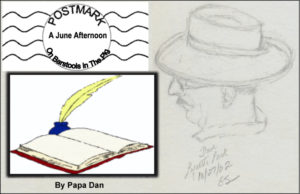
“The Past, The Present, and The Future
walk into a Bar.
It was tense.”
— A very old, ungrammatical, grammar joke
Click here to download a PDF of this article:
ConVivio_Tense_Meeting
= = = = = = = = = = = = = = = = = = = = = = = = = = = = = = = = = = = = = = = = =
The Past and The Present Walk Into a Bar – Their Companion Is Late
I’m sitting at my usual barstool at The Flying Pig, a friendly bistro in San Francisco’s Mission District, sipping a Sonoma County Zinfandel and enjoying my usual BLT (on Focaccia with extra bacon), when two people walk in and take two of the stools at the end of the bar to my left. The guy appears to be in his late fifties wearing dress pants, a sport coat, a vest, and a fedora. His companion, perhaps in her thirties, is wearing casual slacks, a scarf, and a sweater. He places his hat on the bar, looks around and confirms, “Yep, she’s not here yet. As usual, with her, it’s easier to settle on the place to meet; but the time is often a problem for her.” His companion agrees. “That’s the trouble with ‘The Future,’ ” she said; “She usually arrives later than we expect.”
The bartender greets them with his usual enthusiasm “Welcome to The Flying Pig. My name’s Will. I’m glad you could visit us. Can I pour you something? We have some very interesting choices!” After listing some of their most recent acquisitions — the latest up-to-date local craft beers — she orders a 2019 Founders IPA and, after some discussion, he orders a 2012 Napa Valley Cabernet.
I can’t help overhearing their comments about the companion they were waiting for. The gentleman says, “Sure would be nice knowing what to expect from her. I mean, she’s not always a surprise; but we just never know until he shows up, you know?”
His companion agrees. “Right, I know she’s from “The Future” and all; but I think she gets it wrong most of the time. Some of the things she has told me about … you know, ‘The Future,’ are just not believable. Others have just not turned out the way she warned. Last time we got together she had told me she was going to take a taxi, but she ended up arriving in something that didn’t even have a …” William interrupts and brings their drinks and a menu, “You were right, sir, about that Cabernet. It was very popular in its day and I’m surprised we still have some. It was hidden behind something … uh … more recent. Hasn’t been much call for it lately. Our French Dip would go well with it, as would the Classic Roast Beef Sandwich. And, of course, everything goes well with your IPA, … uh … ma’am.“
“They call me Alpha. He’s Janus.” She whispers to Will, “I call him ‘Tom.’ “T” “O” “M” That’s short for ‘The Old Man’ .”
“Uh … of course.”
Janus (aka “Tom”): “I’ll have the French Dip on sourdough. It was excellent last time.”
Alpha: “Have you been here before? I didn’t know that.”
Janus: “Just a few years ago … This place has been here for quite some time. Actually, my memory of this neighborhood goes back to the thirties. I was here with an Italian guy named Vince — a ballplayer with the Seals in the Pacific Coast League. He had his younger brother, Joe, with him. The ballpark was just a few blocks from here at 16th and Bryant. Believe it or not, in those days, it was hard to find a place to get a drink around here.”
Alpha: “You’re not gonna tells us that ‘DiMaggio’ story again are you?”
Janus: “Apparently not.”
Will: “And Alpha, what can I bring you?”
Alpha: “If the ingredients are fresh, I’ll have a salad — romaine, cherry tomatoes, perhaps an avocado, a little parmesan, olive oil, and a little vinegar. I can taste the ‘fresh’.”
Will: “Coming right up.”
Just then, a tall confident woman walks in and both Janus and Alpha say, in unison, “Well it’s about time.” Alpha: “We’d just about given up on you — ordered lunch already. Where’ve you been?” PapaDan notices the clock on the wall says 12:30 pm.
Cassie (sarcastically): “Nice to see you, too. You haven’t changed a bit.” She takes the barstool at the end of the bar next to Janus and ignores Alpha’s question.
Alpha takes charge of introductions. “This is Cassandra — Cassie. That’s Will and Ben behind the bar and this (she pointed to me, apparently aware that I had been eavesdropping) … I didn’t catch your name.”
PapaDan (just a little embarrassed): “Around here, they call me PapaDan. Pleased to meet you.”
Alpha (to Ben and Will behind the bar): “So, when’s the last time you had The Past, The Present, AND The Future here at … what’s this place called … ? The Flying something, right?”
Ben: “The Flying Pig. Uh, Cassie, can I bring you something?”
Cassie: “Is there a special today?”
Ben: “Yes, actually the chef is trying something new today, not sure what’s in it or what he’s calling it, but it probably has … ”
Cassie (interrupts): “Ground Lamb on Pita with olive oil, crushed garlic and sage, and ground tomatoes.”
Ben (with a grin): “Well, I doubt it … I mean we’ve never had …”
Cassie: “Don’t worry, you will. It’s new. Your chef’ll call it Cordero con ajo.”
Ben (a bit startled): “Well, I’ll check. And something to drink?”
Cassie: “You’ve got a mixed blend from up north — a Cab/Chard?”
Ben: “Uh … I don’t think I’ve ever … “
Cassie (with a knowing smile): “Perhaps something new came in this morning?”
Ben (confused): “Well, I don’t … I mean … I’ve never heard of a blend quite like that … I’ll see what came in. I’ll be right back.”
Cassie (to nobody in particular): “They’ll both be very popular before you know it.”
Alpha: “Alright, Cassie, you said we needed to talk. Something about some kind of warning?”
Janus: “Right, so is this another one of your … uh … surprises … predictions … ?”
Cassie: “Have some respect, will you? This time it’s serious. But, lunch first; and the wine will help.”
Will brings the French Dip and the salad, with silverware and some chips and salsa. Then he gestures to me, pointing to the far end of the bar. “Can I show you something? I’ve got this … uh … let me show you.” He leads me over past the last barstool, out of earshot of the three visitors, and leans across the bar. “These people with the strange names, they’re … uh … I don’t know. Different. He’s been talking about visiting the neighborhood like eighty years ago and, whatsername — Cassie — she seems to know things before we do. The other one seems kinda normal, but … am I missing something? What do you make of them?”
“Well, funny you should ask. Listening to them, I was reminded of — you’re not gonna believe this, you’ll think I’m crazy — OK, and it won’t be the first time — I’m reminded of way back in school, Greek mythology.”
Will: “Dad. You’re not gonna get all ‘back in the old days’ on me, are you? Again?”
“Well, yes, I guess I am. OK, I’ll say this and you can ignore it. This is what came to mind while they were talking. In Greek mythology, Cassandra, was the daughter of the king of Troy, and was quite beautiful. Apollo, the son of Zeus, was the god of a bunch of things like knowledge, music, art, poetry, oracles, and prophecy. He was a youthful, athletic god accustomed to getting his own way. According to the myths, he was mesmerized by Cassandra’s beauty, so he gave her the gift of prophecy. But when she refused his romantic advances, he placed a curse ensuring that nobody would believe her warnings. So, I think that’s Cassie. And the guy at the bar, Janus — the Romans had a god named Janus. He was the god of beginnings, transitions, doorways, the passage of time, and endings. I suppose he would be in charge of ‘The Past.’ And ‘Alpha’ — I guess she’s about things that start right now. OK, you laugh, but YOU asked. These folks ARE a bit different.”
Will looks down at the other end of the bar at the three new customers. “Well, ‘Alpha’ did say something like ‘So, when’s the last time you had the Past, The Present, AND The Future here? Apparently, Cassie says she brought them together for some kind of warning. But she’s saving it for after they have lunch. Maybe you need to go back and listen.”
“Well, I’ll do my best. Everybody has to be good at something.” I slide back to my place at the bar next to the three visitors. Say, Will, how about another glass of this Zin.”
Meanwhile, the chef walks up from the kitchen and, with a flourish, presents his new creation — “Cordero con ajo,” he announces. “It’s new. I’ll be interested in your review.” Ben and Will are dumbfounded to hear this. (Will notices that the clock on the wall still says 12:30 pm.)
During the next few minutes, Cassie enjoys the new dish, praises it lavishly, and passes around the Cab/Chard bend for others to taste with their food. It receives decidedly mixed reviews.
Alpha: “Ok, Cassie, you brought us together, here and now, to pass on some warning to us, right? Or so you said. Tell us. What’s coming?”
Cassandra then lays out a detailed story of what’s to come — stimulated by the current American leadership and perpetuated by supporters of that leadership — a story of worthless and all-but-forgotten government institutions, disintegration of the underlying cohesion of communities, increasingly overt racism, degradation of the role of women, the domination of extreme wealth resulting in economic and social upheaval, and a widespread isolationism that made alliances and partnerships, internationally and locally, all-but-forgotten remnants of the past. The long-standing values and connections that have held societies together would soon to be remembered only by Janus and few others. A bit of a crowd gathers around that end of the bar, listening intently without comment. When she was apparently done with her warnings, Janus interrupts the silence with an observation and a question: “So, Cassandra, your warnings are believable, in that they have all happened a number of times in the past across long memory and they have all been repeated over time. However, since you are from ‘The Future,’ I must ask you if they are inevitable.” Are they fixed in stone, as is ‘The Past?’ Is there nothing that can prevent or reverse the warnings you give? Or are they just predictions?”
Cassie: “I am sorry, but that is beyond my expertise. What I know about is ‘The Future.’ I can tell you that the path to ‘The Future’ is made up of a long series of cumulative decisions that you all make every day. I can tell you what is to come if current trends continue along the same pathways. Frankly, it’s not that difficult; I’m sure you can see it yourself if you’re watching the news. But, each of you, makes thousands of decisions every day. When you leave this place, you will decide to turn right or left. After doing that you will decide where to go and how to get there, whom to bring with you and whom to leave behind; and you will decide what to do when you get there. That is the nature of “now,” and it’s something that Alpha knows more about that I do. However, I suspect that ‘The Past’ — that’s you Janus — can provide some insight.”
Janus: “Well, Cassie, I do know about how such things have evolved in the past. AND, as you suggest, ‘Evolved’ is the right word. Important decisions and outcomes were always determined slowly and without much planning. Let’s see — an example — back in 1770 at an important moment in history, that process was described accurately by a member of the British Parliament. It was Edmund Burke. He had this to say: ‘The only thing necessary for the triumph of evil is for good men to do nothing.’ In England, slavery was abolished by the next generation of leaders on August 1, 1834. During that time, it turns out good men actually did something, but slowly. Here in America, it would take all that time, plus thirty more years AND a Civil War in the 1860s to abolish slavery here; BUT even then, good men continued to Do Nothing leading to the disastrous Reconstruction and the subsequent century of segregation and racism compelling the Civil Rights movement 100 years after that War — AND STILL, fifty years later, good men are doing a whole lot of nothing. So, Cassie, we ask: are the things you have warned us about certain to happen? Sounds like what you’re telling us is that the answer is a question — the same question — will good people actually DO SOMETHING about it? You see, there is time between now and later to DO something to change the outcome you have described. If nothing is done, I can see that your predictions can be accurate. If good people decide to change that outcome, it can be done. THAT’S your warning. I see that now. The time has come. Before too long, I suspect, your warnings will become inevitable.” Janus points to me — on the bar stool next to Alpha — “You’ve been listening, right?”
Before I could answer, Cassie stands up from the barstool. Will notices the clock on the wall still says 12:30 pm.
Cassie: “It’s time for me to go. You, Janus, can provide advice from past experience — you have lots of it. BUT, you, Alpha, and you, sir, have the present responsibility. Somebody here must lead these fine people here flying with The Pig. If you choose to do that, and find a way out of the consequences I have described, well, we’ll just have to see. It always falls to The Present to make the difference. And by the way, you get to pay for lunch. That comes with the responsibility. I don’t carry any cash, but I can leave you this tip (briefly lowers her voice): If you own a lot of ‘Tech’ stocks, it might be a good time to rebalance your portfolio. (Louder) Will, Ben, please extend my compliments to your chef. His new recipe will become popular, as will the new approach to wine blending — that is certainly, uh, one of the possibilities. Thank you.”
As Cassie walks out the door, PapaDan looks at his watch (it shows 12:31 pm). Nobody got a good look at the “vehicle” that met Cassie at the sidewalk in front of The Pig to take her back to ‘The Future.’ They were focused on the wine and the food in front of them and the people sitting beside them
— good people, all of them. There was much to consider. ![]()
King Arthur for 2019

“Tell the story”
“Don’t let it be forgot”
— Arthur
…
Yet some men say
in many parts of England
that King Arthur is not dead.”
— Sir Thomas Mallory
(of Warwick?)
—————–——–Click here to download a PDF of this article: King_Arthur_for_2019_May26_2019
In dark times, we humans tend to seek assistance from some form of intervention — perhaps a knight on a horse — to save us from dangers we can’t overcome on our own. History is full of examples; and my personal favorite example is the legend of King Arthur. At its core, the Arthurian legend promises that British greatness is secure as long as its royal heritage endures. Several ancient sources contain the prophecy that the ‘Rightful King’ would reveal himself by pulling an enchanted sword from a stone. In those stories, the sword, a sword named Excalibur, had been embedded in that stone under a spell that awaited a person with enough moral courage and wisdom (and, of course, physical strength) to remove the sword and save his people at a time of great danger. In our most enduring source of Arthurian legend, Le Morte d’Artur (1485), Sir Thomas Mallory tells us that the prophecy said: “Whoso pulleth out this sword of this stone, is rightwise king born of all England.” When that ‘Rightful King’ shows up to remove the sword, they were assured that he would lead his people to victory and guarantee their long-term stability. Arthur arrived on the scene to fulfill that prophecy in the sixth century. Presumably, all of Britain’s history follows from that moment. For centuries, many storytellers have taken up the legend — recently Alfred Tennyson in Idylls of the King (in the 1860s), T.H. White in his popular book The Once and Future King (1958), and, of course, the Broadway musical Camelot by Lerner and Loewe (1960). You’ve heard the story, right?
Most of the stories come to us from the 12th thru 15th centuries, with tales of chivalry, Knights of the Round Table, and a famous Camelot love triangle involving Arthur, Guinevere, and Lancelet; but the real, historical Arthur — and there actually was one — arrived on the scene to remove the sword and save his comrades at the Battle of Camlann in 560 AD. In that battle, Arthur, with the help of the sword, Excalibur, killed their enemy, Mordred, to achieve victory. Unfortunately, accounts from that time record that Arthur was mortally wounded in that battle and was taken by the sorcerer Merlin to the Isle of Avalon to die. Historically, most believe that he was buried in the churchyard at Glastonbury Abbey (below).

BUT Arthur’s story doesn’t end there. Mallory continues: “Yet some men say in many parts of England that King Arthur is not dead, but he was taken by the will of our Lord Jesus into another place; and men say that he shall come again, and he shall win the holy cross.” The legend provides further reassurance — we are told with the particular certainty of such powerful legends, that Arthur still waits at the Isle of Avalon (now known as Glastonbury Tor) for the day when his particular combination of greatness, goodness, and magic will be needed to save Britain again from great danger. Now, partial disclosure, I have visited Glastonbury Tor here in the 21st century in October of 2003. I have walked its full extent (I have pictures, below), and I must report to you that I did not see him there. But, the legend has endured long enough and forcefully enough to suggest that I must have missed him. I can tell you from my observation, there’s magic afoot on that hillside; so, we can be confident.
 Glastonbury Tor, 2003
Glastonbury Tor, 2003
So, the legend endures. (And it’s a good story, no?)
Over the centuries since that day, Britain has survived a long list of well-documented threats;
—> —> BUT today, the time for his return has clearly arrived.
Without Arthur’s intervention, Britain may be approaching a defining ‘point-of-no-return’ if it goes through with The Brexit, its planned separation from the rest of Europe, which will precipitate disastrous results for the British economy and the stability of Europe and the West. The entire arc of history enfolding from the 6th century to the 21st has been a constant struggle to unify and stabilize Europe under strong values and alliances. That struggle has continued through an alternating series of triumphs and setbacks over sixteen centuries. We’ve seen: destructive wars, expansions of a vast British empire, contractions back to a single small country, demonstrably less worthy kings, tasteless food, a few embarrassing prime ministers (that is, most of them since Churchill), and one worthless one (the current one). Arguably, the establishment of the European Union in 1993 was the greatest single step in the progress toward Arthur’s Round Table, as told to us by a succession of storytellers to our present day. The decision is now in the hands of the current British Parliament and the Prime Minister. If this Brexit decision goes the “wrong” way, and Britain shrinks from the responsibilities of its destiny, neither Britain nor the European Union are likely to recover from such a setback. The British people will need all of the wisdom and courage that Arthur, the “Once and Future King,” can provide to step back from the Brexit cliff.
So, the time has come, Arthur, to return and fulfill your destiny. The world still waits. I’m sure you are ready and waiting somewhere on that hill in Glastonbury. Time is running out.
Or, … maybe there is another way to think about this …
According to one version of the story, on the eve of battle, Arthur gave a gift to the future
(i.e., us). He was mindful that the battle was not certain to go well, that he might not survive, and his Round Table could die with him. As he brooded over that bleak future, he was startled by a young boy who had come to fight in the battle. The boy told Arthur that he wanted to fight in the battle to preserve the values of the Round Table. The dejected King, feeling that his life’s work was about to come to nothing, was skeptical, and asked the boy how he could possibly know about the Round Table. The boy told him, “from stories people tell — stories about might for right, right for right, justice for all, a round table where all the knights would sit.”
Arthur was encouraged by what he heard and, using Excalibur, he knighted the boy, Sir Tom of Warwick, and gave him these direct orders:
“You will not fight in the battle, you will run behind the lines and hide until the battle is over; you will return home to Warwick — ALIVE! You will grow up and grow old. For as long as you live, will you remember what I, your King, tell you and will you do as I command?”
“Yes, my Lord.”
Arthur then commanded him to tell the story, strong and clear, of the values of the kingdom he had hoped to create. “Don’t let it be forgot,” he said. (Click on the link to hear Arthur tell the story himself.) As the newly knighted Sir Tom of Warwick left to fulfill his orders, Arthur’s optimism is revived that “We will be remembered” and THAT would be his victory.
So, perhaps as the Brexit decision unfolds over the next few weeks, the story must be told, “strong and clear,” again and again, that Britain has an important role to play in the future of Europe and in preserving the values for which Britain, and Arthur’s Round Table, were founded. Maybe the telling of the story can tip the balance, even if Arthur himself does not emerge from Glastonbury Tor with his sword to save Britain from itself. Maybe the telling of the story is all that is needed. Maybe that is the lesson we must take from the legend:
à if the guys with swords let us down, let’s put our faith in the storytellers. Maybe the storytellers can influence the outcome, even today.
… … An afterthought — if Arthur can save Britain from itself, so you think he can jump across the pond and save US from … well … oh, nevermind.![]()
Ten Seconds in Oracle Arena

“It’s the round thing with the net on it.”
— various generations of Sapones
Click here to download a PDF of this post:”
Ten_Seconds_at Oracle_May15_2019
============================
 So, on this particular afternoon, I’m sitting on my usual
So, on this particular afternoon, I’m sitting on my usual
barstool at The Flying Pig Bistro in The Mission District
of San Francisco, sipping a Sonoma County Zinfandel
with my BLT (delicious on fresh Focaccia), when a guy
walks into The Pig, strides up to the bar, looks up at the
big TV screens and says loudly to nobody in particular,
“OK, so it’s baseball season, right? What’ve we got here — Giants fans? A’s fans? What?”
Like the others on the bar stools, I turned to look — at first annoyed that someone had so loudly interrupted our conversation, but then … I recognized him …
Believe it or not, the last time I saw this guy was here at The Pig during last Fall’s World Series. At that time, we came to an agreement on a “Who Cares” assessment of the World Series — for three reasons: 1) My Giants weren’t in it; 2) the (hated) Dodgers were representing the National League in the Series; and
3) The Red Sox represented the American League. (I grew up associating The Red Sox with “The Curse of the Bambino,” which forever labeled them as the stupidest organization in history because they traded Babe Ruth to The Yankees in 1920.) So, I could easily have rooted against either team but, there was nobody to root for in that World Series. Hence: “Who cares?”
So, while I appreciated this guy from last Fall — I wanted to tell him (before he sat down at the bar and got comfortable) “Look, I know it’s baseball season and all, but LOOK, with the Giants in last place and the Warriors in the Western Conference Finals, it is definitely BASKETBALL season today at this bar. Capiché?”
OK, you’d be right to observe that such an outburst would have been rude and I had never started a bar fight before; but before I could open my mouth another guy beat me to it and blurted, “Baseball didn’t used to be boring but today, it is, don’t you think? And, not only because the Giants are in last place right now. The big story is that the Warriors are about to thrash the Portland Trailblazers in a few minutes, so THAT’S what today is about.”
All of us at the bar held our collective breath waiting for this guy’s reaction. After a moment of reflection, he discreetly declared, “Of course, you’re right. Today is about the Warriors.” Then he changed the subject. “So, I hear you’ve got some beer on tap here, eh? And what’s good to eat here — besides the Portland Trailblazers, of course?” The collective exhale at the bar signified that this guy was gonna be OK; so I offered him the barstool next to me and he took his place. Game on. From behind the bar, William — one of the proprietors — answered his question, “The whole menu’s worth a try — we’ve got a great chef. The French Dip is juicy, the Reuben is popular, and the BLT is my Dad’s current favorite.”
“Your Dad?” Will pointed at me and I greeted the new guy warmly, as did Karl and James on adjacent bar stools. He introduced himself as Russell.
“Welcome. Around here they call me PapaDan, This is Karl. This is James. Behind the bar we’ve got Ben and Will — they own the place and they’ve got the best selection of local craft beer in The Mission District. And don’t worry, we’re not expecting any Portland fans here today.” (I said this quietly and pretended to look over my shoulder).
My son Ben, one of the proprietors, instructed me quietly that we don’t want to piss off any customers who happen to be from up north. “They are good customers; they’ll buy plenty of beer — even if it’s just to drown their sorrows. OK?” I nodded my head in agreement. His brother Will, the other proprietor, chimed in, “The game starts in a few minutes, so what’ll you have? Can I pour you a KBS stout?” Will always seems to know the right thing to say.
We agreed to keep our voices down on sensitive subjects and we ordered another round. I accepted another glass of Zin; Karl and James each had another Fieldwork IPA. The “new guy” turned out to have a refined taste in local craft beers — when he ordered an Altamont Maui Waui IPA — a number of heads turned in admiration and nodded approval.
Russell started again, “So, you guys are all Warrior fans, eh?”
I explained, “Yes, I grew up right here in the Bay Area watching the Warriors since back in the early sixties. So, they’re like family. So, Russell, are you from around here?”
“Well, no. I .. uh … “ he took a deep slug of his IPA and announced, “I grew up in Portland.”
Each of us suddenly took an intense interest in the drink in front of us. To break the silence, Ben showed up and delivered Russell’s BLT. His bartender’s wisdom dictated that he change the subject again. “So, you grew up in a place famous for both beer and wine. Heck, we’ve got some wine from your Willamette Valley right here. Have you got a favorite?”
“Sure, uh … “ He noticed the bottle in from of me and dutifully reported, “The Zin is excellent.”
So, the new guy settled onto a bar stool, raised his glass, and declared: “Now that all of that foolishness is over, it’s now officially basketball season. Pour me another one of these, will you, barkeep? And I’m thinkin’ PapaDan is gonna need another glass of that Zin pretty soon, dontchathink?” I liked this guy. He turned out to be a knowledgeable basketball fan — an admirable quality — who appreciated the exuberant style that the Warriors offered. With Steph Curry and his buddies warming up on the screen in front of us, and the Portland Blazers warming up across the court, we found we had a number of things in common.
We agreed on three fundamental things:
Thing One That Warrior basketball was fun.
— When Steph Curry hit one of his “downtown” three-pointers, he would dance across mid-court waving his arms, not so much to call attention to himself, but to say “Look at US, all of us. We know how to have a good time out here!” Warrior fans took his jubilation to be inclusive — “We’re all having fun, aren’t we?” He was right; and those of us sitting at these bar stools were part of his “We”; especially in the comfortable atmosphere of The Flying Pig. The Warriors were proud of their unselfish approach to the game. When Steph gets in his ‘zone” and can’t miss, other players get him the ball and get out of his way. When Klay Thompson threatens to break an all-time NBA record for three-pointers in a single game, they make sure he is the target of their typical passing barrage beyond the three-point stripe. And when the rest of team gets into a cold snap, they cheer Kevin Durant when he takes the ball himself the length of the court and dominates the game at both ends. They’re here for each other and that attitude rubs off on the fans in the arena and at the other end of the TV screen. Warrior basketball is about “us.”
Thing Two: The conversation settled on another topic of agreement: NBA officials are terrible … Some of them demonstrate that “they don’t know the game.” I chimed in with my usual preposterous theory: “I think there’s a corporate conspiracy in the NBA to create ‘artificial parity.’ You know, they want the league to look like a collection of equals. They hate it when a team comes long and wins three championships in four years and they REALY hate it when a playoff series doesn’t last seven games. It costs the league advertising money; so they try to make the Warriors lose.” Heads nodded all around. So, without evidence, we Warrior fans have a built-in excuse when things go wrong. There are probably other reasons that the Warriors typically shoot half as many free throws as their opponents, but we were generally happy with this explanation.
Thing Three: We agreed that The Portland Trailblazers had gotten this far by relying on fundamentals, more so than the Houston Rockets. Karl: “I’m glad we disposed of the damn Rockets. They were a bunch of bullies and fakers. I was getting tired of all that ‘flopping and whining’ and the refs were falling for it. In the end, they only got two out of five and they were lucky to get those.” Heads nodded all around. Finally, somebody had to ask, “So, is this going to be a sweep or what? Do you think these Blazers can win a game? Heck, their best player, Damian Lillard, grew up in Oakland. So, … ”
Fortunately, Will ended what sounded like the start of an argument: “Look they’re tipping off.”
So, the game proceeded without any barfights. And, it turned out that both teams focused on defense. The Warriors kept the ball away from Lillard and the Blazers found a way to avoid the Warriors screens and didn’t give Curry many wide-open threes. With Durant out, the Warrior bench got significant minutes and scoring was spread among nine different players. Neither Thompson nor Curry were able to dominate. As the fourth quarter wound down, Curry had 19, Thompson had 17, Lillard had 15, Curry and Thompson stayed out of foul trouble, and nobody got a technical. When Steve Kerr called timeout with ten seconds left, the Blazers led 94-92.
And Now, The Final Ten Seconds
The shot clock is off; the game clock reads:
10:0 — Draymond Green receives the inbound pass in front of the Warrior bench.
9.0 — Steph Curry receives the ball at the top of the circle from Draymond. Looney sets a screen for Steph, who immediately puts the ball on the floor, forcing the Blazers to switch as Steph starts his dribble left and forward — leaving Lillard alone one-on-one with Curry for the first time tonight. The Oracle crowd is on its feet, they’ve seen this move before and they know what’s coming.
8.0 — Lillard takes a step back, arms wide, feet in a low stance. Steph continues to dribble, takes a step back with a head fake — causing Lillard to draw his feet closer together, preparing to jump to contest a long three-pointer.
7.0 — Steph crosses the dribble to his left and immediately crosses again, right and forward.
6.0 — The other four Warriors spread wide left and right, drawing four defenders closer to each of them. None of the Blazers wants his man to be the one to receive the pass breaking to the rim for the winning bucket.
5.0 — Steph, now isolated with Lillard, takes one behind-the-back dribble to his left, leaving Lillard slightly off balance, momentarily leaning the wrong way. As Lillard recovers to his left, one more dribble to his right gives Curry the space he wants for the shot, but his dribble, initiated with his taped left hand, is a bit too wide right, costing him an additional 0.4 seconds to regain control. The Oracle crowd makes sounds that are a mixture of groans and cheers — again, they’ve seen this before.
3.6 — Two more dribbles forward and to his right gives Steph the space he hopes will leave him free for the jump shot that would win the game.
2.0 — Curry leaves his feet straight up, as does Lillard extending his right arm as high as it will stretch to contest the shot. Lillard has a few inches of height on Curry, so he has reason to hope his fingers may deflect the shot. Curry’s flawless follow through rolls the ball along the length of his fingers and the ball spins backwards, clearing Lillard’s fingers by a fraction of an inch, as Curry returns to his feet and watches the path of the ball to its inevitable meeting with the rim (that is, “the round thing with the net on it,” as my granddaughter Quinn calls it).
1.0 — The ball travels in its usual perfect arc to its height midway to the basket.
0.0 — On its way down, the horn sounds, ending the game, one way or another. The shot left his hand before the horn, so it will count if it splashes. The crowd, of course, has seen two possible outcomes from scenes like this many times; so, they can’t be sure if it will splash or clank. They had to wait and see.
–> So, they wait.
=============
And, that’s where we leave them. I promised to give you ten seconds at Oracle Arena0, and so I did. As with all basketball games, reading the story, or even hearing the outcome, is not sufficient. You have to see it, feel it, and be there with other people who are feeling it, don’t you? There are so many moving parts and not all of them are physical and not all of them are on the basketball court. Some of those moving parts are on bar stools in The Flying Pig, or in other places where basketball fans gather with their favorite libations. Maybe that’s one of the reasons basketball is superior to other sports, as it certainly is.
As we can imagine, after the outcome was dissected and summarized, Russell, PapaDan, Karl, James, and, behind the bar, Ben and Will, said their goodbyes, nodded their respect, and exchanged “see you next time”s. Cash was placed on the bar and each basketball fan made their way to a car, a BART train, or a taxi, and the night was complete. Meanwhile, the Warriors were on another bumpy road to another championship. Of that, most of us can be certain, mostly. But the road has to pass through some uncertain terrain, even if we think we know where it’s going to end up. I can assure you — my team will continue to be a winner … as will yours.
![]()
Dan Finally Contributes to NPM — 2019
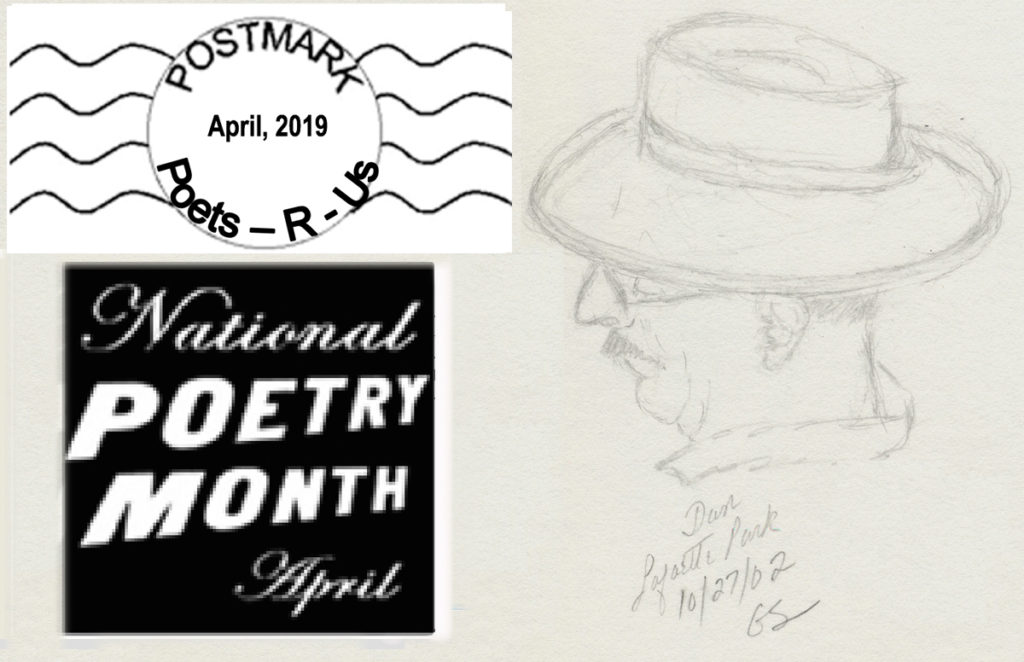
Below are my own meager offerings to celebrate National Poetry Month. I say “meager” because I’m not a poet. In my writing, I specialize in O.S. (that is, Other Stuff). But, to honor the occasion, I offer five poems I wrote and one that was given to me. I wrote the first three in the Ahwahnee “Great Room” in Yosemite this month. They are “hybrid” versions of the sonnet form‚ non-rhyming poems with 14 lines and sonnet-like rhythms. I hope Shakespeare will forgive me. The last one is “mine” only because it was given to me.
Click below to download a PDF of this post:
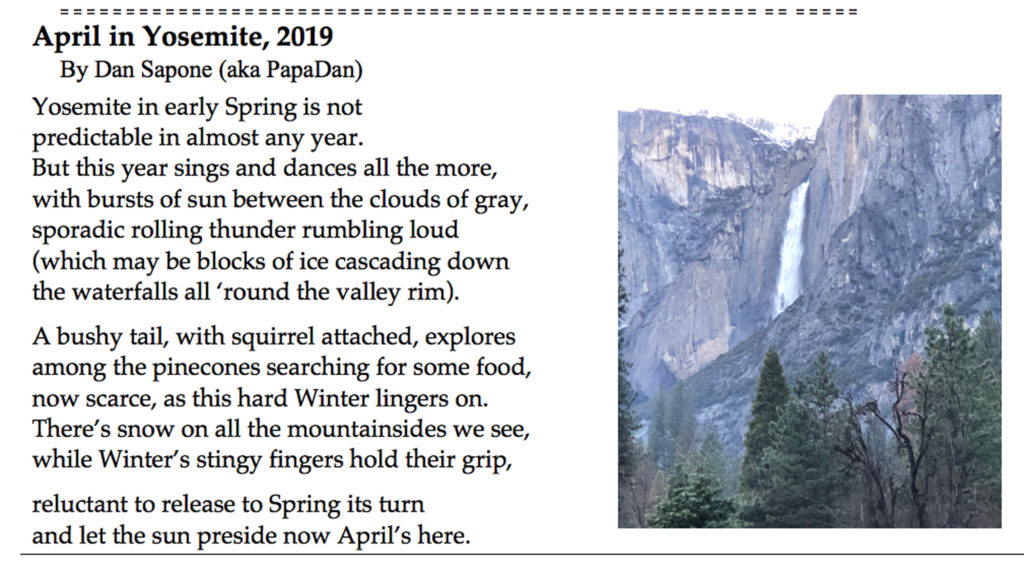


An Older One
I wrote this next free-verse poem in 2013. It was inspired by a painting Gretta and I found in a hotel lobby in Philadelphia on our way to the patio at the back of the hotel beside the river. So, what were we doing wandering the streets of Philadelphia? Let’s start with the back story —
We were on a three-week trip to view the Fall colors in the Northeast. Started in Vermont, crossed New Hampshire, up to Kennebunkport Maine, down to Connecticut, and then — we planned to visit Philadelphia, Washington D.C., and then back up to New York City. The fall colors were spectacular indeed, especially in Vermont and New Hampshire — perhaps a story for another time. –> BUT the United States government, in its infinite wisdom, was shut down at the end of September because the Congress and the White House couldn’t agree on a budget. We weren’t too concerned until we read in the news that, since the city of Washington D.C. is not part of a state, its city budget is governed by the Congress as [art of the Federal budget. SO, city services were stopped and that meant that the garbage was not going to be picked up while we would be there. THAT was the last straw; so, we decided to skip Washington entirely and spend a few extra days in Philadelphia. That led to an afternoon of free time, which we spent walking downtown looking for a place to have a drink and an afternoon snack. So, back to the painting …
Walking through the hotel lobby for the first time, a painting called Figures In a Boat by a local artist, caught my attention and made me ask, “What’s the story?” My first impression is recorded in the first part of the poem (“First Look”). At the end of the afternoon, walking back through the lobby past the painting again, it made a different impression. “Second Look” described that second impression. So, here is my poem, “First Look, Second Look,” in its two parts:
First Look, Second Look
By Dan Sapone (aka PapaDan)


Another Old One
For those interested in the esoterica of poetic rhythm (OK, sure there must be at least ONE of you), here is a completely absurd little … uh … poem about the relative virtues of iambic vs trochaic pentameter. Once again, it violates most of the rules of sonnets — 14 lines and no rhyme but it has some fun with the rhythm.
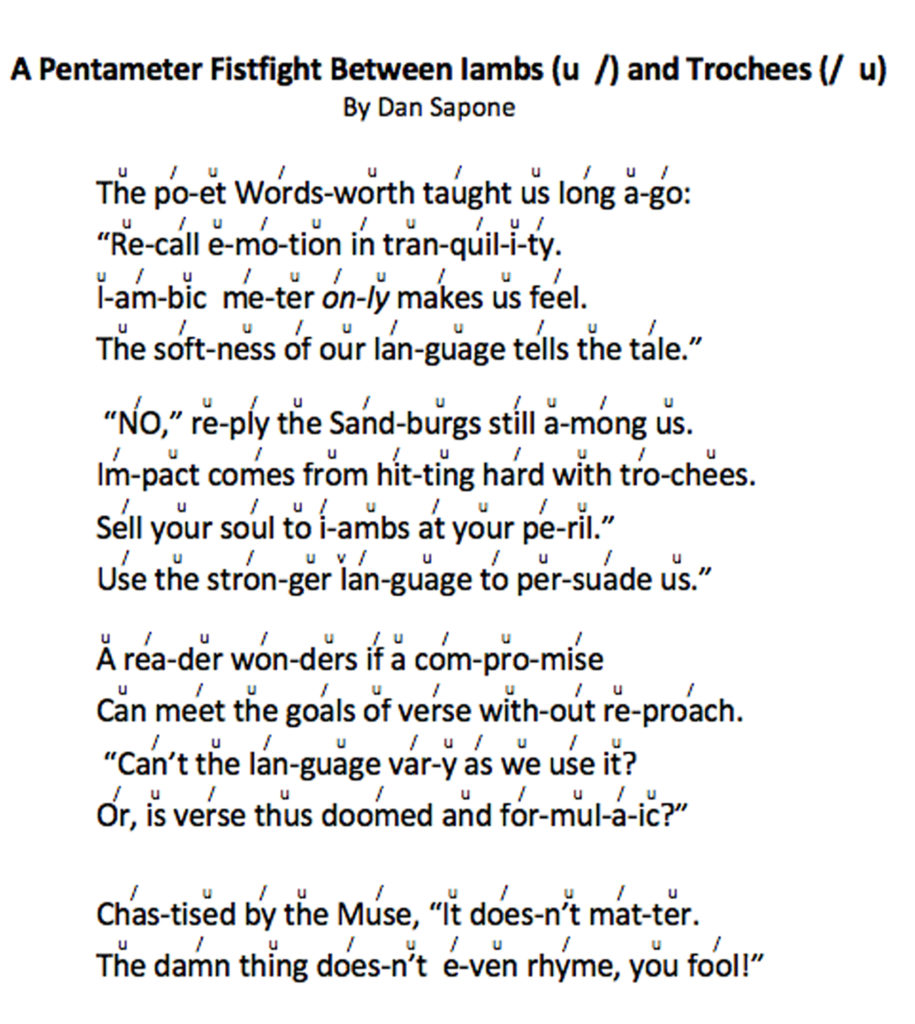
Finally (Honest) A Poem That Was Given To Me (I didn’t write it)
I will call him a humanist. One afternoon fifty-some years ago, my Dad told me to join him in the living room. “Sit down here, Dan, I have something to give you.” He told me that he had a poem to give me and he wanted me to learn it. While he was an avid reader he wasn’t what you’d call a “literary” type; nor was he noticeably a “religious” man. I will call him a humanist. I was not aware of an interest in poetry. He held a book in his hand and I figured he was going to read something to me. But he didn’t open the book but proceeded to “give” the poem to me from memory.
Here it is:
The Touch of the Master’s Hand
By Myra Brooks Welch
It was battered and
scarred, and the auctioneer
Thought it scarcely worth his while
To waste much time on the old violin,
But he held it up with a smile.
“What am I bidden, good folks,” he cried,
“Who’ll start the bidding for me?”
“A dollar, a dollar. Then two! Only two?
Two dollars, and who’ll make it three?”
“Three dollars, once;
three dollars, twice;
Going for three…” But no,
From the room, far back, a grey-haired man
Came forward and picked up the bow;
Then wiping the dust from the old violin,
And tightening its loosened strings,
He played a melody pure and sweet,
As a caroling angel sings.
And when he was done, the
auctioneer,
With a voice that was quiet and low,
Said: “What am I bid for the old violin?”
And he held it up with the bow.
“A thousand dollars, and who’ll make it two?
Two thousand! And who’ll make it three?
Three thousand, once; three thousand, twice,
And going and gone,” said he.
And the people cheered,
but some of them cried,
“We do not quite understand.
What changed its worth?” Swift came the reply:
‘Twas the touch of the Master’s hand.”
And many a man with life out of tune,
And battered and scarred by sin,
Is auctioned cheap to the thoughtless crowd
Much like the old violin.
A
“mess of pottage,” a glass of wine,
A game — and he travels on.
He is “going” once, and “going” twice,
He’s “going” and almost “gone.”
When the Master comes, and the foolish crowd
Never does quite understand
The worth of a soul and the change that’s wrought
By the touch of the Master’s hand.
I hope you have enjoyed National Poetry Month.
Several of you contributed to National Poetry Month.
In case you missed them, here are links to their contributions:
From Dorty: https://convivio-online.net/national-poetry-month-is-here-april-2019/
From Lauren: https://convivio-online.net/lauren-celebrates-national-poetry-month/
From Gretta: https://convivio-online.net/peek-a-boo-where-are-you/
From Steven Peterson: https://convivio-online.net/steve-peterson-celebrates-national-poetry-month/
From Janet: https://convivio-online.net/national-poetry-month-janets-favorites/
From Stephen Faletti: https://convivio-online.net/a-faletti-poetic-contribution/
A Faletti Poetic Contribution
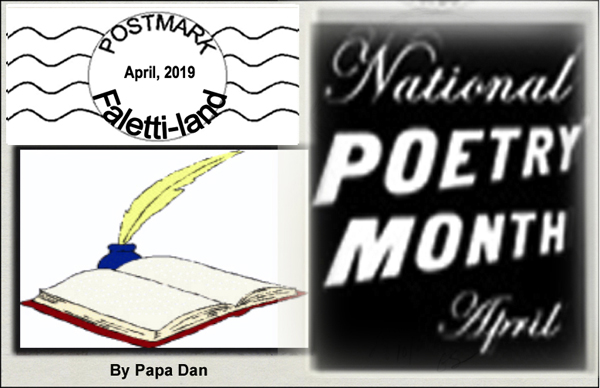
Today, my nephew Andrew Faletti, serves as the Literary Agent for his brother Stephen. In honor of National Poetry Month, Andy offers a poem Steve wrote one January afternoon in 1973, when Steve was a Freshman at Santa Clara University and Andy was in the 9th grade in Antioch, California. Take a look.
Andy writes: “The author (my brother Stephen Faletti) … decades ago submitted to me, as his “official” “agent,” some of his writings to be potentially published. I offered pieces to various poetry magazines and journals — surely hoping that my 15% of any awards would cover the postage and envelopes. ALAS: The poem is no less excellent for my failure to find a publisher.”
= = = = = = = = = = = = = = = = = = = = = = = = = = = = = = = =
Happiness Is Spring — By Stephen Faletti, written one afternoon in January
I strolled along the lively lane
the sun low in the sky;
Somehow I felt a hint of spring,
I’m sure I don’t know why.
It may have been the cool crisp air
Which carried to my ear
the ringing laughter of the kids
Who leapt from houses near;
Or maybe all the birds that chirped
And soared from tree to tree,
Or just the buzzing hum and sound
Of life’s activity.
Then suddenly I chanced to see,
A bit off to the right,
A bushy-tailed small gray squirrel;
It’s fur was shining bright.
I watched it as it skipped around;
It seemed to dance with glee.
And all its wondrous happiness
Became a part of me!
I finally decided to
Continue on my way;
As soon as I began to move
It scampered far away.
That little squirrel of fur so bright
Had made me glad to be;
It may have been the month of snow
But it was spring for me!
= = = = = = = = = = = = = = = = = = = = = = = = = = = = = = = = = = = = = = = = = = =
Several of you contributed to National Poetry Month.
In case you missed them, here are links to five that have been posted before this one:
From Dorty: https://convivio-online.net/national-poetry-month-is-here-april-2019/
From Lauren: https://convivio-online.net/lauren-celebrates-national-poetry-month/
From Gretta: https://convivio-online.net/peek-a-boo-where-are-you/
From Steven: https://convivio-online.net/steve-peterson-celebrates-national-poetry-month/
From Janet: https://convivio-online.net/national-poetry-month-janets-favorites/
National Poetry Month: Janet’s Favorites
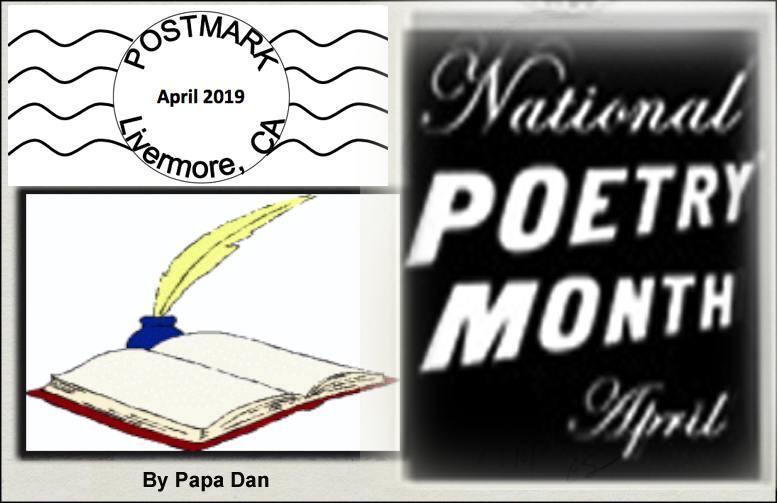
Today,
Janet Pipes offers four of her favorite poems
in honor of National Poetry Month. Take
a look.
I hope you are enjoying National Poetry Month. I expect at least
one more NPM contribution before the month is over. Stay tuned.
Click here to download a PDF of this post:
Several of you contributed to National Poetry Month.
In case you missed them, here are links to four that have been posted so far:
From Dorty: https://convivio-online.net/national-poetry-month-is-here-april-2019/
From Lauren: https://convivio-online.net/lauren-celebrates-national-poetry-month/
From Gretta: https://convivio-online.net/peek-a-boo-where-are-you/
From Steven: https://convivio-online.net/steve-peterson-celebrates-national-poetry-month/

Dreams
By Langston Hughes
Hold fast to dreams
For if dreams die
Life is a broken-winged bird
That cannot fly.
Hold fast to dreams
For when dreams go
Life is a barren field
Frozen with snow.
Desiderata
By Max Ehrmann
GO PLACIDLY amid the noise and the haste, and remember what peace there may be in silence. As far as possible, without surrender, be on good terms with all persons.
Speak your truth quietly and clearly; and listen to others, even to the dull and the ignorant; they too have their story.
Avoid loud and aggressive persons; they are vexatious to the spirit. If you compare yourself with others, you may become vain or bitter, for always there will be greater and lesser persons than yourself.
Enjoy your achievements as well as your plans. Keep interested in your own career, however humble; it is a real possession in the changing fortunes of time.
Exercise caution in your business affairs, for the world is full of trickery. But let this not blind you to what virtue there is; many persons strive for high ideals, and everywhere life is full of heroism.
Be yourself. Especially do not feign affection. Neither be cynical about love; for in the face of all aridity and disenchantment, it is as perennial as the grass.
Take kindly the counsel of the years, gracefully surrendering the things of youth.
Nurture strength of spirit to shield you in sudden misfortune. But do not distress yourself with dark imaginings. Many fears are born of fatigue and loneliness.
Beyond a wholesome discipline, be gentle with yourself. You are a child of the universe no less than the trees and the stars; you have a right to be here.
And whether or not it is clear to you, no doubt the universe is unfolding as it should. Therefore be at peace with God, whatever you conceive Him to be. And whatever your labors and aspirations, in the noisy confusion of life, keep peace in your soul. With all its sham, drudgery and broken dreams, it is still a beautiful world. Be cheerful. Strive to be happy.
The New Colossus by Emma Lazarus
By Emma Lazarus
Not like the brazen giant of Greek fame,
With conquering limbs astride from land to land;
Here at our sea-washed, sunset gates
shall stand
A mighty woman with a torch, whose
flame
Is the imprisoned lightning, and her
name
Mother of Exiles. From her beacon-hand
Glows world-wide welcome; her mild eyes
command
The air-bridged harbor that twin cities
frame.
“Keep, ancient lands, your storied
pomp!” cries she
With silent lips. “Give me your
tired, your poor,
Your huddled masses yearning to breathe
free,
The wretched refuse of your teeming
shore.
Send these, the homeless, tempest-tost
to me,
I lift my lamp beside the golden
door!”
Steve Peterson Celebrates National Poetry Month
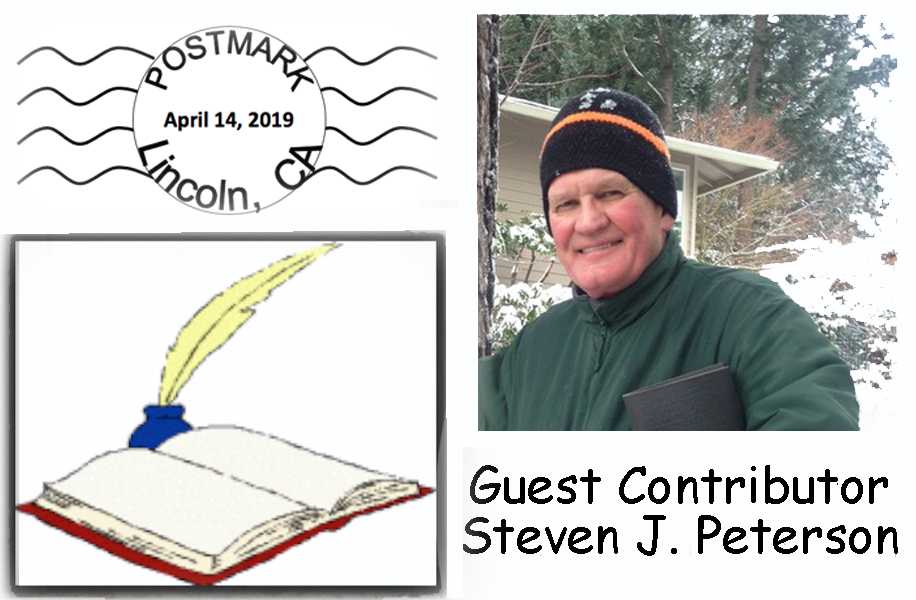
In response to our celebration of National Poetry Month and old friend, and former ConVivio contributor Steven J. Peterson, offers two of his favorite poems.
Steve has appeared on ConVivio before as a
Guest Storyteller. His previous appearance
on ConVivio can be found at:
https://convivio-online.net/gratitude/
Click here to download a PDF of this post:
Steven writes:
Since I read your ConVivio post requesting poems, I have
been thinking about poems that I like.
I recalled that in the 1980s I read a lot of poetry, but have not read poetry
with any consistency in the past twenty years. Makes me wonder how decades slip by so
quickly.
I recalled that when I was in high school I was charmed by Dylan Thomas’s “Fern Hill,” especially the opening line: “Now as I was young and easy under the apple boughs,” which made me think of the first “serious” play I attended at Moorhead (Minnesota) State College, these days called Minnesota State University at Moorhead (MSUM). The play was “Dylan” by Sidney Michaels, written in 1964. I saw it performed in April of 1966 near the end of my junior year of high school, about six weeks before my family moved from Minnesota to California. I thought it was a “great” play, but what did I know? I was two months away from my seventeenth birthday. I would like to see that play again. But never mind about that.
Below are two poems I like, “The Red Wheelbarrow” and “Where They Were and What They Were Doing.”
Steve
============================
The Red Wheelbarrow
by William Carlos Williams, Published in 1923
so much depends
upon
a red wheel
barrow
glazed with rain
water
beside the white
chickens.
Where They Were and What They Were Doing
by Matt Cook
I was looking through Milwaukee newspapers
From the day after John F. Kennedy was shot-
There was this auto body worker
Who brought his BB gun to work that day;
He was arrested for shooting his BB gun
Out the windows of the body plant
At passing automobiles-
That’s where he was and what he was doing
On the day President Kennedy was assassinated.
There was this biochemist.
He was giving this speech at some university in town-
He was inviting the audience to imagine
A strain of pneumonia bacteria
That was wearing a heavy armor suit that was actually made of protein–
That was his public speaking metaphor.
His point was that the protein would act like
A shield against white blood cells.
That’s what that guy was up to that day.
And just outside of town somewhere,
A car slammed into a truck on a rainy highway.
The car guy died of head injuries;
The truck guy was in satisfactory condition with neck pain.
In satisfactory condition with neck pain-
That’s where that guy was, and what he was doing.
The day President Kennedy was shot,
These kids broke into a junior high school.
They stole twenty dollars worth of stamps,
And smashed up an aquarium.
That was their story;
That’s where they were and what they were doing.
“Where They Were and What They Were Doing” by Matt Cook, from In the Small of My Backyard. © Manic D Press, 2002.
Peek-a-Boo, Where Are You?
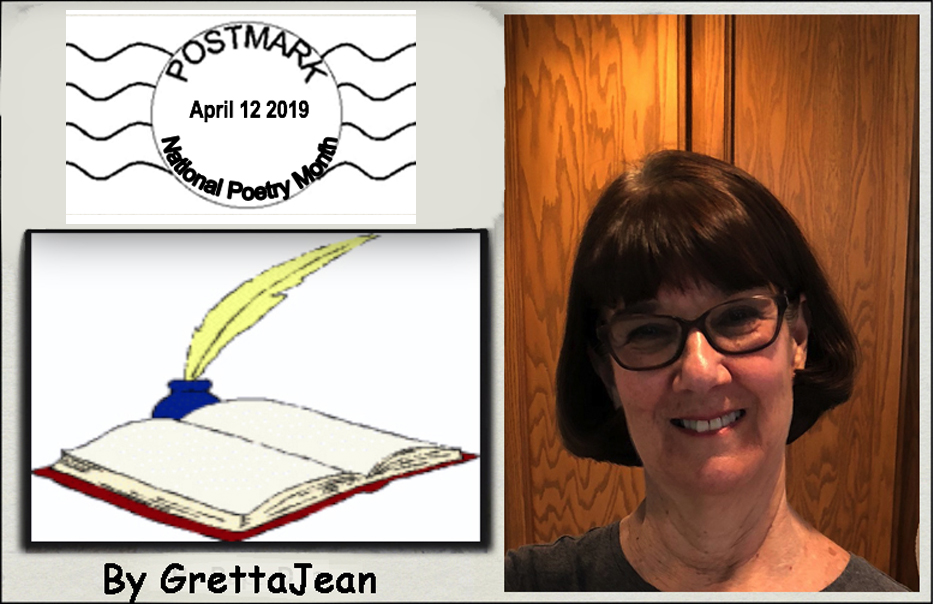
Take a Peek on the lighter side of poetry.
Gretta makes a contribution to
National Poetry Month with this poem.
Gretta has appeared on ConVivio before
with her poetry. Her previous appearance
on ConVivio can be found at:
https://convivio-online.net/poetry-and-plein-air/
Click here to download a PDF of this post:
= = = = = = = = = = = = = = = = = = = =
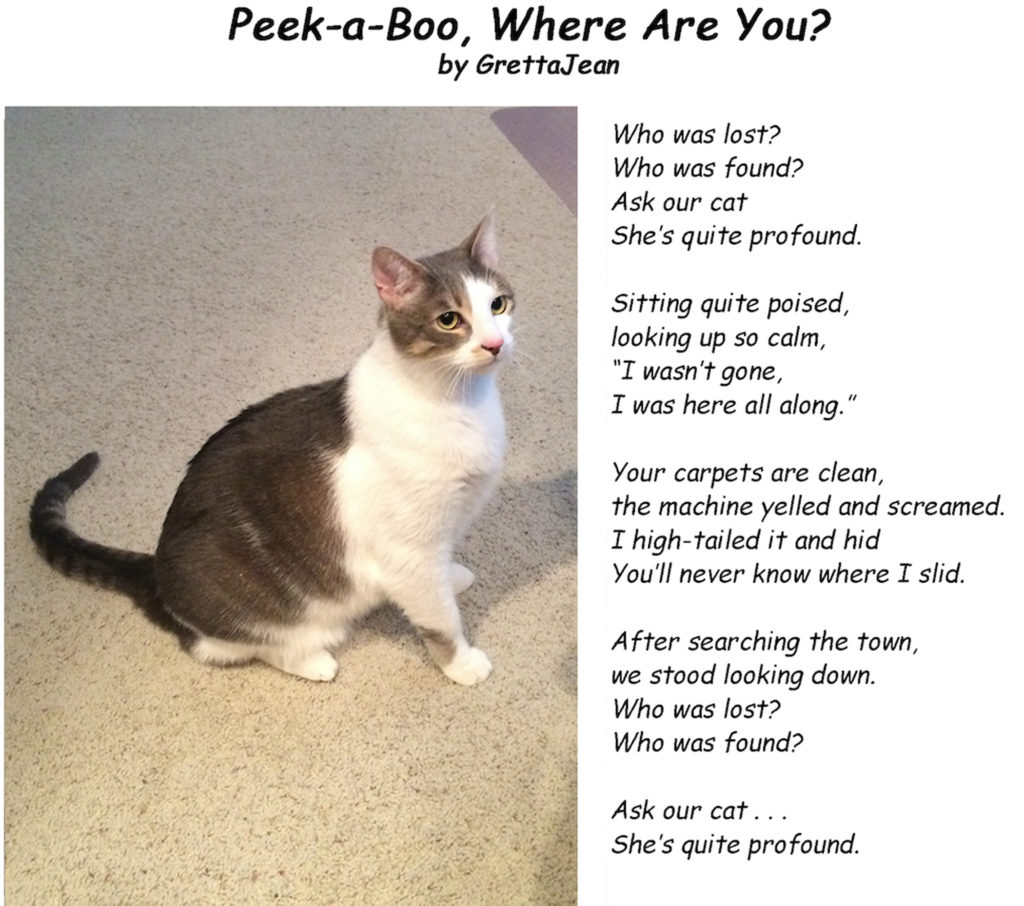
Lauren Celebrates National Poetry Month
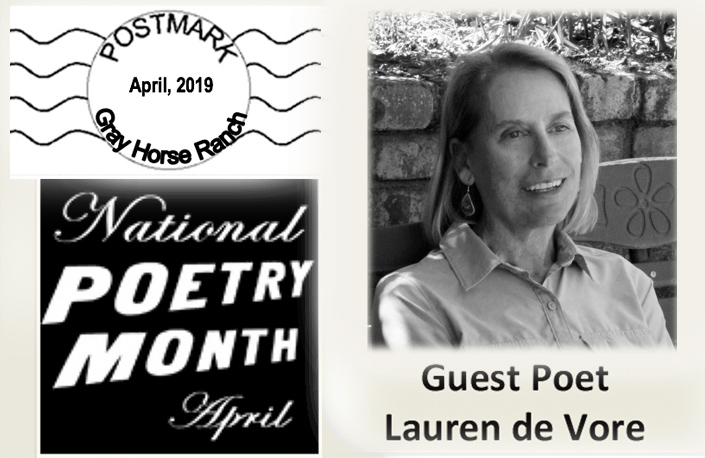
Once again, ConVivio celebrates National Poetry Month with a series of ‘poetic’ posts. Today we are privileged to feature some recent poems by Lauren de Vore, a published Bay Area poet who has appeared on ConVivio a few times before as a Guest Poet.
Enjoy!
.
Click below to download a PDF of this post:
.
Reflections on Events, Current and Otherwise
As much as I try not to dwell on unpleasant things, they have a nasty habit of intruding, kind of like the whine of unseen mosquitos that drives one indoors on an otherwise lovely summer night, into my thoughts and poems. Thus the following…
A short soapbox rant:
Shout it from the Rooftops
Shout it from the rooftops
Shout it from the pulpits and the streets
Shout it at the gas-n-stops
Shout it in your texts, your posts and tweets
The emperor is naked
His crown is but a fake orange lacquered mop
His palace is a house of cards
His courtiers a bunch of spineless fops
Look behind the backdrops
Look past all the bombast and the pomp
Look beyond the photo ops
He’s in bed with those who own the swamp
See the cheating and the lies
See the malice and the venal spite
See how freedom bleeds and dies
Each time hate and chaos trump what’s right?
Blind are those who will not see
Ignorant the ones who will not think
Fight, resist, unwaveringly
Else into that stinking swamp we sink
= = = = = = = = = = = = = = = = = = = = = = = =
Some questions asked and answered:
Because
The paleo man hefted his club,
Brought it down hard on the paleo deer.
Eyes stared back from the blood-soaked ground
Asking why, why do you do this to me?
Because I have the club and you do not.
The lord of the manor lifted his crop
And slashed it across the peasant’s face.
Sullen eyes glared up from the mud
Asking why do you do this to me?
Because I’m of the purple and you are not.
The whaler launched his harpoon,
The big game hunter sighted his prey
And sapient eyes gazed back through the lens
Asking why, what harm have I ever done you?
Because I hold the weapon and you do not.
The slave owner cracked his whip, the officer swings his baton,
A mother, a father raises hand or fist,
And innocent eyes, the eyes of the beaten ask why.
They’re stronger, they’re meaner, they’re in command,
And you, poor soul, are not.
The faith-fueled fanatic waves his torch,
The zealot of left, right or center his flag,
With nary a care for another’s pain, nary a thought
As to why each hates the other one so,
For they are righteous and everyone else be damned.
A god in his heaven rallies his wrath,
His thunder and lightning and hurricanes,
And hurls them down hard onto man below.
And man in his clueless disbelief
Asks why, why do you do this to me?
= = = = = = = = = = = = = = = = = = = = = = = =
Observation on the dubious value of barriers:
Walls
Barricades, fences, and walls
Partitions nature abhors
In the end, every one falls
Over all, time’s army pours
Palisades, ramparts, and dikes
Constructs of hubris and fear
Mindset of rulers and reiches
History’s lesson is clear
For every wall, build a door
For every fence, build a stile
Never forget what they’re for
Else to the despots, seig heil!
= = = = = = = = = = = = = = = = = = = = = = = =
Commentary on apparent American values with regard to immigration:
Immigrants
Two caravans head north,
Driven forces beyond their control.
The miles are long,
Grueling and perilous,
Fraught with predators of every ilk.
Death and despair
Thin their numbers,
But the caravans push on,
Sinuous entities seeking
A land of peace and plenty,
For there is no going back;
Going back is certain death.
Far better to venture into the unknown,
To hope against hope,
And trust whatever powers there be
To guide them to safety.
And when at last they arrive?
Jubilation greets the one,
Reverence and joy, festivals and delight.
And the other? The other is met
With guns and walls, with scorn
And denigration and detention.
Two caravans of immigrants
Seeking sanctuary.
Who knew one had to be decked
In orange and black butterfly wings
To be welcome.
= = = = = = = = = = = = = = = = = = = = = = = =
In memory of Sandra Parks, Steve Slaughter, and the countless other victims of senseless violence:
= = = = = = = = = = = = = = = = = = = = = = = =
Cogitations of a sleepless night:
Past Midnight
It was one of those nights
When her brain wouldn’t turn off
As she lay in bed, a lone soul keeping vigil
While the rest of the world slept.
The grandfather clock in the front room
Te-tick-tocked the seconds away,
A-lone-all a-lone-all a-lone it repeated.
Yet she did not need a clock to tell the time,
For the radio was quietly playing,
And on the radio, it’s always past midnight.
The measured cadences of NPR
Or the late-night DJ talking, talking, talking
To himself, to her, to the brother-slash-sisterhood
Of night owls and insomniacs,
Unknown to each other yet connected
By invisible airwaves. Soon the night
Will turn to dawn and she will rise
To face the day, but it’s always
Past midnight on the radio.
= = = = = = = = = = = = = = = = = = = = = = = =
And in the night, remembering…
Empty House
She wanders through the house, its lone occupant.
A faint trace of her youngest lingers in one room
And if she looked she’d likely find an old shirt
Or shoe, but she closes the door and wanders on.
It used to be so full of noise and bustle,
Husband and children and critters, everyone
Rushing this way and that at the top of their lungs.
But the hamsters and fish and dogs grew old and died,
The kids grew up and away, and the husband
Took up with a new and improved model of wife.
The house is silent now, dust-free and orderly
After all the years of nagging and fussing
Over messy rooms and muddy floors. Everything
Is just the way she likes it. Only it’s not.
For the house is empty, and she’s becoming
A ghost. Maybe, she thinks, she should get a cat.
= = = = = = = = = = = = = = = = = = = = = = = =
Visioned while standing with my horse as he grazed in the morning sun:
Ah, To Be Grass
Supine I lie
Face to the sun
Earth bed beneath
Taste the rain, the fine champagne
The dark aged chocolate loam
Root finger toes reach out and grasp
Holdfasts to the world below
Chlorophylled, wind-waved
My hair covers the rough
And smooth like a velvet shroud
Trodden, trampled
Grazed, parched, fired, frozen
I am dis-tressed
Beaten down, but not beaten
For come rain, come spring
All is green again
Ah, to be grass
= = = = = = = = = = = = = = = = = = = = = = = =
Reaction to being addressed by a server too young to know better:
Ma’am’d be Damned!
When did I turn from a miss to a ma’am,
From mademoiselle to madam?
The face in the mirror looks mostly the same,
To all of my teeth I lay claim,
I’m slim in the hip, my pulse doesn’t skip,
On mem’ry I’ve got a firm grip.
With gadgets and tech I’m fairly adept,
Up with Kimmel, Colbert I have kept;
Though hip hop and rap leave me quite cold,
Lin Man Miranda is gold.
I love anime and practice feng shui,
So what is it gives me away?
Have I some aura, some faint pheromone,
Does my voice quave some telltale tone?
For I’m forced to admit, I’m tempted to spit
Or at least indulge in a snit
Whenever I’m hailed with madam or ma’am,
That unwanted age-implied slam.
Can you not see I’m just ent’ring my prime
With many a hill yet to climb,
And per adage most sage, years are no gauge
Of actual sine qua non age.
So till I start flaunting sensible shoes,
Start dying my gold-y locks blue,
Until I appear in bright purple clothes,
In red hats with feathers and bows,
Humor please, if you’d be so polite,
For someday you’ll be in my plight;
Say ms if you must or miss if you will,
And all will be cool, will be chill.
I may be old mutton dressed up as spring lamb,
But madam’d or ma’am’d I’ll be damned!
National Poetry Month Is Here — April 2019
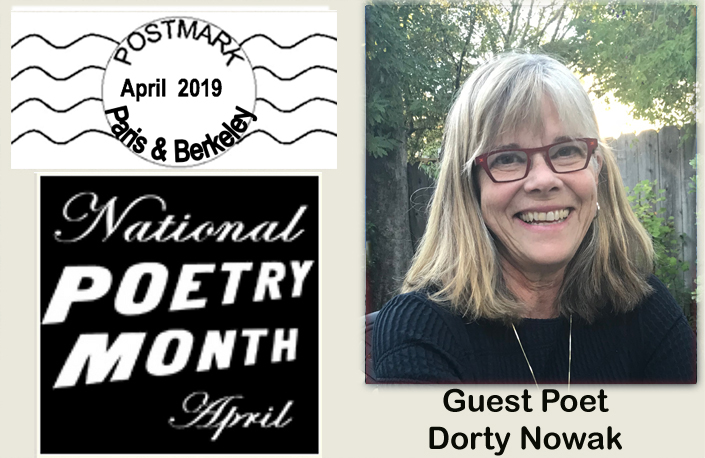
Dorty Nowak is a writer and artist living in Paris and Berkeley who writes frequently about the challenges and delights of multi-cultural living. Among life-long achievements, she helped found the Oakland School for the Arts and contributes to artistic projects on two continents. Dorty was ConVivio’s first ‘Guest Poet’ (has it really been) nine years ago.
We welcome her back as today’s ‘Guest Poet.’
— Click below to download a PDF of this post:
◊◊◊◊◊◊◊◊◊◊◊◊◊◊◊◊◊◊◊◊◊◊◊◊◊◊◊◊◊◊◊◊◊◊◊◊◊◊◊◊◊◊◊◊◊◊◊◊◊◊◊◊◊◊
ConVivio Again Presents “Guest Poets” for National Poetry Month
In celebration of National Poetry Month, Dorty Nowak returns to ConVivio and offers the following poems by “two of the greatest in the English language.” She observes that “old age and death have long been fertile subjects for poets, among them T.S. Eliot and Dylan Thomas.” In that category, she offers Eliot’s “The Love Song of J. Alfred Prufrock” and “Do Not Go Gentle Into That Good Night” by Dylan Thomas. And, as she has said before, “because I’ll never pass up a chance for extra credit” she gives us one of her own creations.
From Dorty Nowak
Dorty introduces Eliot’s “The Love Song of J. Alfred Prufrock” with a story: “Recently I listened to a recorded talk Eliot gave in 1950 in which he said “The Love Song of J. Alfred Prufrock” embarrassed him. Since that remarkable monologue helped catapult him, at age twenty-six, to fame, I was surprised. Eliot didn’t elaborate on his embarrassment, leaving me to assume it was because he considered himself not yet a master of his craft. However, poetics aside, Eliot created in ‘Prufrock’ a narrator poignantly and perceptively meditating on the limitations of age. For a young poet to have accomplished that is nothing to be embarrassed about.”
The
Love Song of J. Alfred Prufrock
by T.S. Eliot
S’io credesse che mia risposta fosse
A persona che mai tornasse al mondo,
Questa fiamma staria senza piu scosse.
Ma percioche giammai di questo fondo
Non torno vivo alcun, s’i’odo il vero,
Senza tema d’infamia ti rispondo.
Let us go then, you and I,
When the evening is spread out against the sky
Like a patient etherized upon a table;
Let us go, through certain half-deserted streets,
The muttering retreats
Of restless nights in one-night cheap hotels
And sawdust restaurants with oyster-shells:
Streets that follow like a tedious argument
Of insidious intent
To lead you to an overwhelming question …
Oh, do not ask, “What is it?”
Let us go and make our visit.
In the room the women come and go
Talking of Michelangelo.
The yellow fog that rubs its back upon the window-panes,
The yellow smoke that rubs its muzzle on the window-panes,
Licked its tongue into the corners of the evening,
Lingered upon the pools that stand in drains,
Let fall upon its back the soot that falls from chimneys,
Slipped by the terrace, made a sudden leap,
And seeing that it was a soft October night,
Curled once about the house, and fell asleep.
And indeed there will be time
For the yellow smoke that slides along the street,
Rubbing its back upon the window-panes;
There will be time, there will be time
To prepare a face to meet the faces that you meet;
There will be time to murder and create,
And time for all the works and days of hands
That lift and drop a question on your plate;
Time for you and time for me,
And time yet for a hundred indecisions,
And for a hundred visions and revisions,
Before the taking of a toast and tea.
In the room the women come and go
Talking of Michelangelo.
And indeed there will be time
To wonder, “Do I dare?” and, “Do I dare?”
Time to turn back and descend the stair,
With a bald spot in the middle of my hair —
(They will say: “How his hair is growing thin!”)
My morning coat, my collar mounting firmly to the chin,
My necktie rich and modest, but asserted by a simple pin —
(They will say: “But how his arms and legs are thin!”)
Do I dare
Disturb the universe?
In a minute there is time
For decisions and revisions which a minute will reverse.
For I have known them all already, known them all:
Have known the evenings, mornings, afternoons,
I have measured out my life with coffee spoons;
I know the voices dying with a dying fall
Beneath the music from a farther room.
So how should I presume?
And I have known the eyes already, known them all—
The eyes that fix you in a formulated phrase,
And when I am formulated, sprawling on a pin,
When I am pinned and wriggling on the wall,
Then how should I begin
To spit out all the butt-ends of my days and ways?
And how should I presume?
And I have known the arms already, known them all—
Arms that are braceleted and white and bare
(But in the lamplight, downed with light brown hair!)
Is it perfume from a dress
That makes me so digress?
Arms that lie along a table, or wrap about a shawl.
And should I then presume?
And how should I begin?
Shall I say, I have gone at dusk through narrow streets
And watched the smoke that rises from the pipes
Of lonely men in shirt-sleeves, leaning out of windows? …
I should have been a pair of ragged claws
Scuttling across the floors of silent seas.
And the afternoon, the evening, sleeps so peacefully!
Smoothed by long fingers,
Asleep … tired … or it malingers,
Stretched on the floor, here beside you and me.
Should I, after tea and cakes and ices,
Have the strength to force the moment to its crisis?
But though I have wept and fasted, wept and prayed,
Though I have seen my head (grown slightly bald) brought in upon a platter,
I am no prophet — and here’s no great matter;
I have seen the moment of my greatness flicker,
And I have seen the eternal Footman hold my coat, and snicker,
And in short, I was afraid.
And would it have been worth it, after all,
After the cups, the marmalade, the tea,
Among the porcelain, among some talk of you and me,
Would it have been worth while,
To have bitten off the matter with a smile,
To have squeezed the universe into a ball
To roll it towards some overwhelming question,
To say: “I am Lazarus, come from the dead,
Come back to tell you all, I shall tell you all”—
If one, settling a pillow by her head
Should say: “That is not what I meant at all;
That is not it at all.”
And would it have been worth it, after all,
Would it have been worth while,
After the sunsets and the dooryards and the sprinkled streets,
After the novels, after the teacups, after the skirts that trail along the floor—
And this, and so much more?—
It is impossible to say just what I mean!
But as if a magic lantern threw the nerves in patterns on a screen:
Would it have been worth while
If one, settling a pillow or throwing off a shawl,
And turning toward the window, should say:
“That is not it at all.”
That is not what I meant, at all.”
No! I am not Prince Hamlet, nor was meant to be;
Am an attendant lord, one that will do
To swell a progress, start a scene or two,
Advise the prince; no doubt, an easy tool,
Deferential, glad to be of use,
Politic, cautious, and meticulous;
Full of high sentence, but a bit obtuse;
At times, indeed, almost ridiculous—
Almost, at times, the Fool.
I grow old … I grow old …
I shall wear the bottoms of my trousers rolled.
Shall I part my hair behind? Do I dare to eat a peach?
I shall wear white flannel trousers, and walk upon the beach.
I have heard the mermaids singing, each to each.
I do not think that they will sing to me.
I have seen them riding seaward on the waves
Combing the white hair of the waves blown back
When the wind blows the water white and black.
We have lingered in the chambers of the sea
By sea-girls wreathed with seaweed red and brown
Till human voices wake us, and we drown.
— T.S. Eliot, 1915
————————————————————————–
Dorty notes that “Dylan Thomas’ celebrated poem “Do Not Go Gentle Into That Good Night” is very different in tone. Written a few years before his death at age thirty-nine, the poem is an exhortation specifically to his father, but generally to mankind, not to give in to the accumulated disappointments and frailties of age. Unlike “Prufrock” Thomas’ poem doesn’t dwell on specifics to make its case but rather relies on the raw power of emotion magnified by phrase repetition.”
Do
Not Go Gentle Into That Good Night
by Dylan Thomas, published 1951
Do not go gentle into that good night,
Old age should burn and rave at close of day;
Rage, rage against the dying of the light.
Though wise men at their end know dark is right,
Because their words had forked no lightning they
Do not go gentle into that good night.
Good men, the last wave by, crying how bright
Their frail deeds might have danced in a green bay,
Rage, rage against the dying of the light.
Wild men who caught and sang the sun in flight,
And learn, too late, they grieved it on its way,
Do not go gentle into that good night.
Grave men, near death, who see with blinding sight
Blind eyes could blaze like meteors and be gay,
Rage, rage against the dying of the light.
And you, my father, there on the sad height,
Curse, bless, me now with your fierce tears, I pray.
Do not go gentle into that good night.
Rage, rage against the dying of the light.
——————————————————————–
Again, from Dorty — “A few years ago, I wrote ‘Coda’ as a tribute to my grandmother. It’s a poem I couldn’t have written as a young person. Now a grandmother myself, I understand what my grandmother taught me, by example, about courage and resilience.”
Coda
By Dorty Nowak, (published by Drunk Monkeys in 2017)
Too big for your body, the whale of a bed will go on sale; also the dresser, its
three-linked mirrors tall as sails.
I empty drawers of froth-edged linens sent from Sligo, clippings from concerts that spoke of early promise, a few hairpins. Find, beneath a crush of scarves, a silk sack, striped silver and gold. Inside,
a prosthetic breast.
Flayed by a country doctor when I was thirty-three.
I cradle its weight in my hand. You ask to keep it, a bit of ballast.
In the last drawer, two boxes of dime store jewels, gifts from music students. I run beads smooth as seaweed through my fingers, dangle jeweled earrings. Their cast-off colors dance on the surface of the pale green spread. You know the name of each child. The boxes, and their names, go with you.
Only the piano is left, shipped from Austria, a gift from your father when you were six. Grand vessel you commanded through two wars, both a brother and husband disabled young. Sorrows you never spoke flowed from your fingers.
Nana, what shall I do with the piano?
Play it.
National Poetry Month Continues
Many thanks to Dorty Nowak for accepting my invitation to serve as ‘Guest Poet’ on ConVivio, once again. You can see Dorty’s previous appearance as a ‘Guest Poet’ on ConVivio at:
——-> Since ‘National Poetry Month’ is . . . well . . . a month long, next week we will be privileged to have an offering from another of our previous ‘Guest Poets’ — Lauren de Vore. Look for that. Others are in the works — we’ll have to wait and see what appears! Dorty and Lauren and I hope that others (YES, YOU!) will take advantage of the opportunity to contribute some of your favorites— either poems written by others or their own creations.
Go For It! There’s a whole month left of National Poetry Month! What are you waiting for?
Baseball Rules — 2019
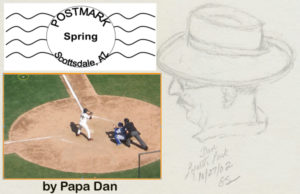
To those who think baseball is dull
and want to speed up the game:
“Tell them two things:
First, explain the planning, strategizing,
calculating, and deception
that takes place before every pitch.
Then, quote Hall-of-Fame announcer Red Barber
— ‘Baseball is dull only to dull minds.’ ”
Click here to download a PDF of this post:ConVivio_baseball_rules_Mar2019
= = = = = = = = = = = = = = = = = = = = = = = = = = = = = = = = = = = = =
Baseball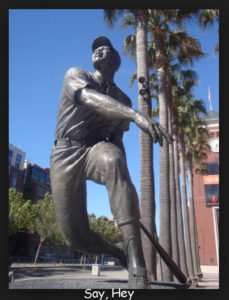 It’s the middle of March, and right now I am deeply embroiled in Golden State Warriors’ basketball. The NBA playoffs are fast approaching and there is much at stake. Heck, there’s an important game tonight (aren’t they all?). BUT the sun is shining this week and baseball is in the air. So, there are some things we must discuss.
It’s the middle of March, and right now I am deeply embroiled in Golden State Warriors’ basketball. The NBA playoffs are fast approaching and there is much at stake. Heck, there’s an important game tonight (aren’t they all?). BUT the sun is shining this week and baseball is in the air. So, there are some things we must discuss.
Disclaimer: As I’ve written before, I was a basketball player, not much of a baseball player. Basketball was the only sport I was any good at, but I grew up loving baseball — I watched it ever since 1961 when my brother-in-law Joe Faletti took me and my nephews to my first Giants’ game at Candlestick Park. I listened to Russ Hodges and Lon Simmons on the radio and I lived and died by the fortunes of My Giants. Baseball mattered to a kid growing up in the 1950s/60s in Antioch, CA. [Click here for my personal, brief playground baseball history.].
While I was not a baseball player in the 1960s, I read everything I could get my hands on about baseball heroes ancient and current and came to understand that much about baseball had not changed in a very long time and that was the way it was s‘posed to be. THAT meant that the achievements of ancient players I read about — Babe Ruth, Bobby Thompson — were just as important as, and comparable to, those of the heroes of my youth— Willie Mays, Willie McCovey, Juan Marichal, and the rest of My Giants — and those of today’s 21st-century Giants — Buster Posey, Madison Bumgardner. It also meant that the strategies of baseball managers — from Leo Durocher to Alvin Dark to Bruce Bochy — didn’t change either.
Of course, I learned early that in baseball, as with any sport, the rules mattered. I needed to know the rules inside and out if I hoped to have intelligent conversations about baseball with other kids and adults — or if I was going to follow what I was hearing on the radio.
Last year at this time, I wrote about My Giants and it was mostly paying homage to baseball memories (click here to take a look at that one: Baseball 2018).
So, what is this Giants fan thinking about, here in March of 2019?
Baseball Rules
Baseball has two kinds of rules: unwritten rules and written rules.
The Unwritten Rules of Baseball
The unwritten rules of baseball must NEVER be violated. There are 29 of them. I will offer these six to serve as examples:
Unwritten baseball rule #2: Thou shall not say the words “No hitter” in the midst of a no hitter. The penalty for violating this rule is that a no hitter will not happen.
Unwritten baseball rule #5. Do not make the first or third out in an inning at third base. You’re already in scoring position at second; don’t be greedy.
Unwritten baseball rule #11. Do not “show up” the other team or a player. This means don’t admire a home run you have hit or gesture happily after striking someone out. Act like you’ve done it before and you expected it. Otherwise, bad things will happen.
Unwritten baseball rule #18. Stealing signs is allowed, if you don’t get caught. BUT, do not peek at the catcher’s signs while you are hitting. If you do, the next pitch will be aimed at your head.
Unwritten baseball rule #23. A pitcher that is getting pulled from the game must always HAND the ball to the manager while he waits for him ON the mound. This rule has been violated occasionally by players who had short careers in the major leagues.
Unwritten baseball rule #27. Do not step on the chalk lines as you walk on or off the field. Bad things will happen if you do.
These “rules” have been in force for the better part of 150 years and do not change. Period.
The Written Rules of Baseball
OK, now we get to the REAL issues that loom over major league baseball today. As reported recently in the NYT and the SF Chron, a number of dramatic rule changes have been swirling around Major League Baseball (I tried to avoid adding the phrase ‘like a plague of locusts’). To most of us who grew up with baseball as an everlasting, never-changing presence in our lives, these suggestions have been dismissed as meaningless meanderings of deranged minds. BUT, these are starting to get serious — SO SERIOUS in fact, that the independent minor league Atlantic League will be testing some of the proposed rules this coming season. This ‘very minor’ league has eight teams spread across the country from New York to Texas. Below is a quick summary of some of the new rules they will be trying out and a humble assessment of them.
Three-batter minimum: Once a relief pitcher enters a game, he must face at least three batters, unless the half-inning comes to an end. If you’re the manager under this rule, you won’t be allowed to bring in a particular pitcher to pitch to one particular hitter and then pull him out.
— According to Bruce Jenkins, MLB is considering implementing this rule in 2020, even if the players union protests.
— In My Humble Opinion (IMHO): this is crazy.
Extra-inning “tiebreaker”: To prevent really long extra-inning games, each extra half-inning would begin with a runner on second base. According to Bruce Jenkins: “… no chance.”
— IMHO: This is pure evil. I still remember listening to my transistor radio lying in bed late into the night of July 2, 1963. Warren Spahn of the Milwaukee Braves and Juan Marichal of the SF Giants BOTH pitched 16 shutout innings tied 0-0 until Willie Mays came up in the bottom of the 16th and hit one into the left field stands to win 1-0. Historic games like this should not be made unlikely with silly rules like this one.
Banning the shift: This rule would require that two infielders be stationed on each side of the second-base bag when the pitch is released — otherwise, a ball is called.
— Once again, it takes a strategic option away from a manager and it deprives us all of the possibility of seeing a powerful pull hitter try to lay down a surprise bunt (in my memory McCovey tried this at least once). MLB plans to consider this one for the 2020 season.
— IMHO: NO! Managers should be able to position their defense anywhere they think would be to their advantage. If they try something unusual and get burned — that will be entertaining.
Mound visits eliminated: That’s right, no visits by a catcher, infielder or manager unless a pitching change happens.
— MLB reduced the number of visits and may drop it to four for 2020. Some want visits ended.
— IMHO: There are good tactical reasons for having strategic discussions in key situations, even to stall for time while a pitcher warms up in the bullpen. I say don’t limit visits any further. Adding some thought and discussion to the game is a good thing — and what’s your hurry?
“No Pitch” intentional walks: What about the idea of intentionally walking a batter by simply waving him to first base? Over the years there have been times when a runner advanced because an intentional ball got away from the catcher — in some cases a runner has scored from third.
— IMHO: I don’t think it is an improvement to remove an opportunity for players to make a mistake with consequences. That’s a key part of the game. I say make them throw the pitches.
Pitch clocks: For years, the Official Baseball Rules requires that the pitcher shall deliver the ball to the batter within 12 seconds after he receives it, if the batter is in the box. MLB could simply enforce the existing rule, but the players hate it.
— IMHO: as my Italian ancestors used to say “Fuhgeddabowdit.”
Reduced time between innings: The Atlantic League will be cutting commercial time from 2:05 to 1:45. MLB is reducing the time from 2:20 to 2:00 in national telecasts.
— IMHO: I don’t care about this one, since there are easy technical work-rounds for television.
The mound moved back: The mound has been 60 feet, six inches from home plate since 1893
— the Atlantic League is going to move it back two feet to 62 feet, six inches. The idea is to cut down on the increasing number of strikeouts — a good thing — which it is likely to do.
— IMHO: this is outrageous and the second-worst rule-change idea I have heard. This would change everything and make all of our historic standards and records meaningless. Fortunately, MLB doesn’t seem to be interested in it — but it’s early. You should worry.
Robot umpires: This one is the single worst rule-change idea I have heard. While proposals for implementation of this plan are not as horrific as the name suggests, in this plan, balls and strikes will be called digitally and relayed to a human umpire; but fortunately, MLB does not appear to be seriously interested.
— IMHO: Absolutely NOT! If there’s one idea that has always — rightfully — dominated the game of baseball it is that it is a human endeavor built entirely on the reality that outcomes on the field will be determined by the imperfection of the participants at a particular moment. Routine plays will happen as they should; great plays will be noted as grand surprises; and mistakes will be something we must live with. I believe this ”rule” must always also apply to the performance of umpires. If the decision made on the field is an error, we should be stuck with it, just as we are stuck with it when an outfielder throws to the wrong base or a base runner misses a bag.
So, What’s The Hurry?
So, in summary, I will continue to be skeptical of any proposed rule change that is intended to “speed up the game.” All my life, baseball has been called “Our National Pastime.” That name implies that it should be a pleasant way to PASS the time, not to rush through it or shorten it. Sitting in the stands at the ballpark on an afternoon or evening was always intended to be a leisurely time, a time to allow the mind to wander a bit.
And so, IMHO, that is the way it must remain.
![]()
Beautiful Words — A Challenge
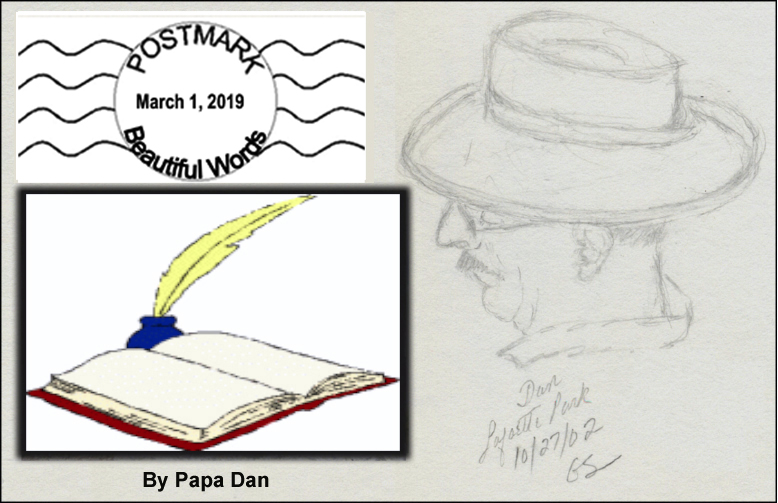
“To a first approximation,
words mean what they say.
…
AND how they make you feel.”
Click here to download a PDF of this story:
= = = = = = = = = = = = = = = = = = = = = = = = = = = = = = = = = = = = = = = = = =
Recently,
a ‘by-line’ in the San Francisco Chronicle got my attention. What caught my eye was not the title, but the
author’s name — Nick Hoppe. Frankly, I
had not heard of “Nick” Hoppe, but his last name, “Hoppe,” is a name that had
been important to me for half a century.
Art Hoppe, who turns out to be
Nick’s dad, was a columnist at the Chronicle from 1960 until his death in
2000. The column was called “Our Man
Hoppe” and later “The Innocent Bystander,” at its peak syndicated by over 100
newspapers nationwide. His satirical
column covered local and national politics and included essays, feature columns,
and one-act scenes with an ongoing cast of characters like Private Oliver Drab,
Joe Sikspak, Homer T. Pettibone, and others.
Art Hoppe was my hero. I read his five-day-a-week column starting in the 7th grade and, when I determined that I wanted to be a writer, he was my inspiration. Much of what I have done on convivio-online.net is inspired by him. One in particular is a one-act play I posted on ConVivio in 2011 in which I recreated two characters he featured often over the years — Gabriel and The Landlord — my version is called “Some Explaining To Do” (click here if you’d like to read it).
–> –> –>–> But I digress … all of that explains what attracted me to Nick Hoppe’s column earlier this month called, “Words That Just Feel Good On the Tongue.” His goals were to identify ten words that, according to him, were the ten most beautiful words in the English language and explain why they were beautiful TO HIM. I thought that was an intriguing idea. When I read his column (and his list), I decided that many of his choices were NOT among those I would choose (e.g., his #1 choice was “knucklehead”). BUT, I quickly realized that was his point: that I should identify words that I thought were beautiful and defend what made them important TO ME.
So, I Made a List
I
tried to create a list and a brief defense of each word’s presence on my
list. I decided a word earned the right
to be included with a combination of the sound of the word and its meaning —
the composite of how that word makes me feel.
It was sorta fun, but as with most lists of “favorites,” the challenge
is to decide what must be excluded. Turns
out, I just plain failed to limit my list to ten, as Nick Hoppe had done (so,
sue me). Below is the result:
A. My list of the top-ten most beautiful words in American English (according
to me)
B. My list of the second-ten most beautiful words in American English
C. A list of beautiful words I’ve stumbled across in other languages that SHOULD
be in American English, but we don’t seem to have an equivalent word.
Observation: few one-syllable words made the list. Following the Italian pattern, d’yathink words with multiple pronounced vowels sound more melodious, and generate stronger feelings?
A CHALLENGE —> Since you will inevitably disagree with some of my choices, (I can hear you now: “How could you possibly include THAT word?”), I INVITE YOU to make our own list(s) and defend your choices. If you send me a list (or even just suggest a word or two), I will publish them here, if you like (with or without your name, as you choose).
My Top Ten Most Beautiful Words in American English, and why they are beautiful (listed here alphabetically)
1. Becoming — this word (the title of Michelle Obama’s wonderful book) sets aside the notion that we must end up somewhere “final” in this life. It suggests that we can always be more.
2. Grace — I admire this word with its three meanings: for many, a spiritual condition (“a state of grace”) received as an unearned divine gift; it is also a description of the physical elegance of artistic movement (as in a graceful dancer); but also, as a verb, to confer dignity or honor to a place or event. (“I do not understand the mystery of grace only that it meets us where we are but does not leave us where it found us.” — Anne Lamott )
3. Love — the starting point and sustenance of everything good; either with a specific target or a broad, generalized intent toward all of life. It comes to us free and is re-distributed free.
4. Kindness — the quality of being friendly, generous, considerate, without expecting a reward.
5. Serendipity — occurrence of happy or beneficial events apparently by chance (“Hitting the center of a target you didn’t know you were aiming at.” — Bujold
6. Simplicity — uncomplicated, easy to understand effortlessly, uncluttered.
“Everything should he made as simple as possible, but not simpler.” — Einstein
“Simplicity, simplicity, simplicity.” — H.D Thoreau (essential ingredient of a good life)
7. Storytelling –>–> One of my favorite words.
“Storytelling reveals meaning without committing the error of defining it.” — Hannah Arendt
“Stories are the common currency of humanity” — Tahir Shah (Arabian Nights)
“The human species thinks in metaphors and learns through stories.” — Mary Bateson
“Reality can be beaten with enough imagination.” — Mark Twain
8. Welcome — an invitation bestowed on another person that says: “You belong here. Come in.”
9. Wonderful — inspiring delight, worthy of admiration, stimulating imagination (i.e., wonder)
10. Yosemite (Yohhe’meti) — name of the tribe that occupied what is now the Yosemite Valley, named by the surrounding, more peaceful Miwok tribes (literal translation: “Those who kill”).
That tribe called themselves the Ahwahneechee and named “their” valley “Ahwahnee.” The Miwok translation for “Ahwahnee” meant simply “people. Archaeological evidence of the Ahwahnechee and the name date back about 800 years. Early recorded contact with European settlers was about 1850 during the Gold Rush. The name “Yosemite” stuck after being named that by 18th-century European settlers. –> –>My love of this word does not stem from its troubled linguistic history but from our own experience with this beautiful, inspiring valley over our lifetime AND the inspiring sound of the word.
My Second Ten Most Beautiful Words in American English
11. Eloquence — fluent or persuasive speaking or writing. à And I enjoy the sound of this word.
“You must speak straight so that your words may go as sunlight straight into our hearts.” — Cochise
“Eloquence is painted thought.” — Blaise Pascal
12. Ephemeral — lasting for a short time, fleeting. “She liked the way the word sounded in her head. ‘I am ephemeral.’ It made her feel like something passing and precious.” — Pamela Todd
13. Exhilaration — synonyms: elation, euphoria, joy, ecstasy, exultation, rhapsody.
“Exhilaration is that feeling you get just after a great idea hits you and just before you realize what’s wrong with it.“ — Rex Harrison. “We can take some gratification at having come so far in just a few thousand years as language users but it should be a deeper exhilaration to recognize that we have such a distance to go.” – Lewis Thomas
14. Felicity — joy, delight, cheerfulness, ability to express one’s thoughts effectively.
“To strive with difficulties and to conquer them is the highest human felicity.” Samuel Johnson
“There is more felicity on the far side of baldness than young men can possible imagine.” — LP Smith
15. Forbearance — patient self-control, restraint, tolerance.
“Common man’s patience will bring him more happiness than common man’s power.” Amit Kalantri
“Leadership was not an act of bravery but rather forbearance and the strength to move forward with humility in the belief of what is right.” Sortoosh Shahrivar
16. Mellifluous — voice or words sweet or musical, pleasant to hear. “In my dreams, I heard your mellifluous voice. It slowly woke me up from a deep sleep so that I could enjoy the magnificence of life.” — Debasish Mridha
17. Propinquity — proximity à I just like the sound of it better than mere “proximity.”
“Keep characters in propinquity long enough and a story will always develop a plot.” — Keith Miller
18. Quintessential — classic, representing the most perfect example of a quality.
“A quintessential experience is to hike up the John Muir Trail behind the Mist Trail to the top of Vernal Falls and trudge through the snow to the rock from which you can look down at Vernal and up at Nevada Falls — and, if you are not eaten by bears in the dark on the way down, to have a glass of Rombauer Chardonnay in the Ahwahnee dining room with a plate of scallops.” — PapDan
19. Resplendent — attractive and impressive through being richly colorful or sumptuous.
20. Succulent — OK so I just like the Hemingway quote à“As I ate the oysters with their strong taste of the sea and their faint metallic taste that the cold white wine washed away leaving only the sea taste and the succulent texture, and as I drank their cold liquid from each shell and washed it down with the crisp taste of the wine, I lost the empty feeling and began to be happy and to make plans.” — Ernest Hemingway
Ten Words with no English Equivalents, that the English Language Needs
–> –> Some emphasis here on the sound of these words, as well as their meaning.
1. Flaneur (French) — a person at leisure, deliberately aimless, wandering streets, soaking in a city, a neighborhood, or, heck, a forest.
2. Magari (Italian) — “If only”; use this for beautiful experiences that you wish for, longingly.
3. Metanoia (Greek) — the journey of changing one’s mind, heart, self, or way of life.
4. Mudita (Sanskrit) — taking delight in the happiness of others.
5. Namaste (Sanskrit) — traditional Hindi greeting or gesture of respect, (“I bow to the divine in you”) by holding the palms together before the face or chest and bowing. The gesture is called a “Namaskar”; the word used is “Namaste.” àà Gretta contributed this one to the list.
6. Passeggiata (Italian) — a slow, late afternoon or evening stroll, (perhaps associated with gelato). This is a close relative of the French word “Flaneurie,” which is what a Flaneur does.
7. Rocambolesco (Italian) — a person who is daring, adventurous, and incredible — or an experience that can be described with one of those adjectives.
8. Sprezzatura (Italian) — to do something flawlessly, effortlessly, splendidly.
9. Tickety-boo (British) — Something satisfactory and in good order (but not extraordinary); sometimes shortened to “twee.” Some believe it derives from Hindi “ṭhīk hai, bābū,” meaning “it’s alright, sir” — and is therefore a linguistic theft.
10. Tsundoku (Japanese) — the act of buying books, keeping them, and not reading them
Afterthoughts — A few of you sent in your own lists of carefully-selected words as comments on ConVivio. I have taken three of those lists from “Comments” and added them below — they are from
1. Our own famous “Hat Lady”
2. Our guest poet Lauren de Vore
3. Overall wise-word-man Stephen Faletti.
I think you will enjoy their contributions.
Nick Hoppe’s recent column (with his top-ten list) can be found here: https://www.sfchronicle.com/entertainment/article/Words-that-just-feel-good-on-the-tongue-13607480.php?cmpid=gsa-sfgate-result
If you’re interested in knowing more about my earliest writing hero, Art Hoppe, his obituary in the Chronicle from February 3, 2000, paints a good picture. It can be found here: https://www.sfgate.com/news/article/Chronicle-Columnist-Art-Hoppe-Dies-Eloquent-3240505.php
“The Hat Lady‘s” Lists of Favorite Words
Our famous “Hat Lady” offered two lists and a bit of a “defense” for including each word — in some cases identifying a word that needs to be used more often in our public discourse and placing that word within her own personal philosophy. Shortly after her 90th birthday, she says: “I just have one defense of my lists. The words are good. They lend variety to expression, a precision, or shading. These are all things that the English language does well.”
My First List
- Story — Narrative, true or fictitious, designed to interest or muse the hearer of the reader. Everyone has a story to tell, if only one would stop to listen or read.
- Equanimity — Easiness of mind or temper; calmness, composure. Disturbing one’s equanimity these days is easily done. One must reach for it again and again.
- Façade — Face or front of a structure; an outward appearance maintained to conceal a less pleasant disposition. It’s always rewarding to present a sunny demeanor.
- Embrace — to take on or receive an idea gladly; to avail oneself of opportunity; to include. To embrace the concept of respect for all does not appear to be publicly appealing at this time.
- Consequential — the nature of consequence following an effort or result. Consequential implications of one’s actions are mostly ignored these days. What a shame!
- Accommodate — to do a kindness of a favor for friends, family, or even a stranger. How could one not accommodate someone in need, whatever the need might be.
- Meander — to proceed by a winding course; to wander aimlessly. It does one good to meander through fields in Spring. It is also good to let thoughts meander once in a while.
- Curmudgeon — irascible; churlish; sometimes lovable. A little patience with this recently elder person can be fun.
- Thanksgiving (Day) — The act of giving thanks on a special day. There is much joy in assembling loved ones and making preparations for a festive day of thanks.
- Affirm — to state positively as true; assuring that one’s belief and/or loyalty can be accepted without doubt.
My Second List
- Ingenious — showing cleverness; inventiveness; free from reserve; frankly candid.
- Conundrum — Anything which puzzles; not easily resolved. The world itself is a puzzle. Its origin is not known.
- Sublime — Inspiring the mind with some sense of grandness; awe-inspiring.
- Limpid — transparent; crystal clear.
- Insight — a penetrating mental view; sudden grappling with a solution.
- Probity — integrity; up-rightness; honesty.
- Optimist — a person given to looking on the bright side; a belief in goodness.
- Gingerly — with caution or extreme care; mincingly; daintily.
- Imbroglio — a perplexing situation; complicated or difficult to resolve; a laughable mix-up (it’s Italian).
- Fragrance — having a pleasant odor, as in the fragrance of Spring; ripening fruit; homemade bread.
Lauren de Vore’s Words that “roll off the tongue and into the ear most pleasantly.”
On February 28, 2019, Lauren wrote: “These are not necessarily my “favorite” words; those words have all sorts of connotations and associations, making it difficult to judge them solely on the basis of their sound. The ten words offered below (in no particular order) are those that, to my mind, roll off the tongue and into the ear most pleasantly.”
- Amble: slow and easy, it moseys through the mouth and out into the world.
- Cherish: there’s something precious and precise about “cherish”; doesn’t hurt that there’s a rather nice song with this title.
- Bell: the initial “b” is the clapper that strikes the lips and opens up the mouth for a big, round, resonant “ell.”
- Eiderdown: just sigh into the word and feel it settle softly over you.
- Nosh: voiced directly behind the nose, nosh is a silly word but so much more satisfying than snack.
- Tourmaline: sparkles like crystalline but with more color and depth, just like the gem.
- Dreamy: flows with great mouthfeel, just like soft-serve ice cream but without the calories.
- Palisade: never mind the meaning, I just like the way it glides (glissades?) off the tongue.
- Velvet: I love the way the word sounds the way velvet feels, especially when you savor the “ell.”
- Golden: so rich and warm, if a sound could glow …
Stephen Faletti’s Words
On March 6, 2019, Stephen offered this list:
- AAUGH! — an exclamation used when characters in the Peanuts comic strip scream. When yelled, the characters are typically facing up with their mouths almost as big as their faces.
- AAARRRGGGHHH!!! — a longer exclamation related to AAUGH!
- Asymptote — a straight line such that the distance between some curve and the line approaches zero as the x or y coordinate tends to infinity (in analytic geometry). So the curve continually approaches but never quite touches the line (meets without touching). From the Greek root asymptotos meaning “not falling together.” See the classic curve y=1/x. For extra credit, see the hyperbola x^2-y^2=1.
- Spectacular — beautiful in a dramatic and eye-catching way. Use with the special intonation made famous by Huell Howser in the PBS television series “California’s Gold,” as in spec-TAC-ular. Try it out loud.
- Disgruntled — angry, dissatisfied, or discontented. You can hear the grumbling when you say the word. From an old verb gruntle meaning “to utter little grunts,” with the prefix “dis” used as an amplifier not an opposite (no one is ever gruntled).
- Homoscedasticity — same variance (in statistics). The situation in linear regression analysis where the variance (random noise) around the regression line is the same for all values of the variable x. So the data points in the scatter diagram are all roughly the same distance from the regression line. But who cares? Just enjoy pronouncing this 7-syllable word.
- Heteroscedasticity — different variance (complement to homoscedasticity). An 8-syllable word that has a delightful sing-song intonation.
- Old-School — characteristic or evocative of an earlier or original style, manner, or form. Use with appreciation or reverence, not as a pejorative.
- Emphatic — expressing something forcibly and clearly; showing or giving emphasis. This word sounds like its definition.
- Tort Litigation — I’m breaking the rules of the exercise here by using a phrase instead of a word. But you might enjoy the effect of saying these two words emphatically, out loud, and together as if they comprised a single word. Try it.
My 10 Words – Lewis Bell
Understanding – This is a big one, because it seems that when people reach a point of great authority they lose the ability to understand anything other than their own ego driven desires. The world is full of misunderstanding now. I don’t know if it is more or less than usual, but I only live in what is now. All of it is hard to understand but every day I try to understand and do the right thing.
Satisfaction – My father once told me that, “A satisfied man is a happy man.” He didn’t tell me much because he died when I was 13, but those words have always stuck with me. I agree with him. All you need is all you need. You don’t have to have it all, just what it takes.
Delight – Those perfectly timed moments that bring glee, relish, excitement, thrill, happiness. Babies, puppies and kittens are especially good at it. It keeps you young❣️
Compassion – Caring for your fellow man and setting the good example for those that follow you to do the right thing. Success does not always mean getting. Giving can bring greater wealth. When it is your turn, do not look the other way
Devotion – Belonging to and having someone belong to you builds amazing foundations and creates a steadfastness that can and will last for an eternity.
Laughter – This one tops the list – “Love, Live Laugh” is plastered all over my being. “If you can’t laugh about it, it is not worth doing.” Don’t know who said that, but Milton Berle said, “Laughter is an instant vacation.”
Faith – Not so much in a deity or an organized religion, but more so faith in myself – knowing that I can get the job done, knowing that I have what it takes, an inner strength, a positive sense of being.
Creativity – I thrive on creativity. Most recently I have discovered hidden talent is graphic arts and in music. Making something from nothing but yourself is so powerfully rewarding.
Awareness – Always being acutely aware of where I am and what is going on around me – not because of being afraid, but of being fearful that I will miss out on something in this amazing world in which we live. I can’t tell you how many times I have asked someone, “Did you see that?” And they answer, “No.” And I think, “Your loss!” It doesn’t cost anything to pay attention.
Individualism – I’ve always strived to be self-motivated, self-supporting, and not afraid of being different. I am my own person. I have those that I love and those that I follow, but I am not into group pressures. I like to make up my own mind.

Show likes.
Is America Ready for the Twenties?
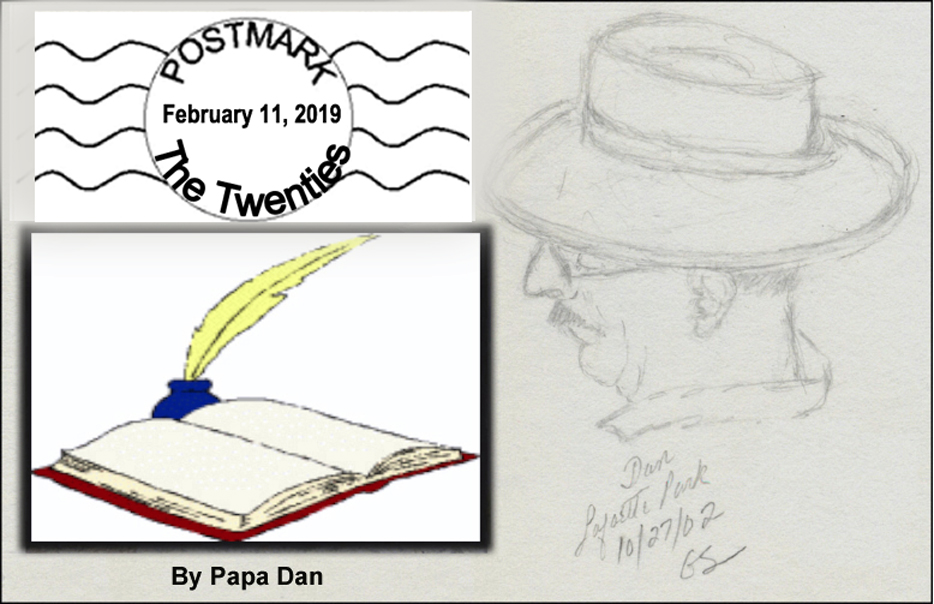
“The definition of insanity is doing the same
things over and over again,
but expecting different results.”
— Albert Einstein (100 years ago)
============================================================
Now that we have turned the calendar into January, America stands on the threshold of a new decade: “The Twenties” — that is, the 2020s. Over my lifetime, we Americans have a habit of naming decades, mostly in retrospect, for the attributes that were remembered by the generations that follow. Let’s quickly review the decades of the previous century:
• 1900 to 1910 – often called by American writers “The Good Years” — This was a time of peace, optimism, strength, and increased productive immigration
— my unskilled, impoverished, and illiterate grandparents came to America during this decade.
• 1910 to 1920 — Often called “The Teens”: featured War throughout Europe, widespread suffering, less immigration to America.
• The Nineteen Twenties — called “The Jazz Age” or “The Roaring Twenties”): featuring the odd partnership of Prohibition, alcohol, Jazz, and, well, “roaring.” We’ll comeback to this one.
• The Nineteen Thirties — called “The Great Depression” started with the Stock Market crash, and led directly to unemployment, hunger, and the rise of Nazis in Europe.
• The Nineteen Forties — the first half is called World War II, featuring isolationism and then war, the second half of the forties has been called “The Seeds of Prosperity”:
— that featured optimism and growing stability.
• The Nineteen Fifties featured “The Cold War,” and “Prosperity for Most of Us”: it was the stability that I grew up with — stability for most of us.
• The Nineteen Sixties — came to be called “The Age of Aquarius”: a combination of dashed optimism, racial/generational tensions, and the Vietnam War. These were my teenage years.
• The Nineteen Seventies — called “The Me Decade” featured Watergate, individualism, a monumental oil crisis, Middle East violence, and withdrawal from Vietnam.
• The Nineteen Eighties — was called the era of “Fact-Free Politics”: featuring Middle East wars and a historic redefining of “conservatism.”
• The Nineteen Nineties — WSJ and NYT famously named it “The Best Decade Ever”:
it featured the rise of Internet, a strong economy, multiculturalism, and then … well, the emergence of the “politics of personal destruction” and lots of small wars.
• 2000 to 2009 ‑ “Rise of Terrorism and Great Recession ”: 9/11, a mis-directed military response to 9/11, attacks on civil liberties, a recession, fiscal stimulus, and financial regulation.
So, last month we just completed the decade of 2010 to 2019 — What-am-a-gonna-call-it?:
This decade has featured near bankruptcies of whole countries — AND lots of disasters (e.g., disastrous earthquakes; disastrous tsunamis, floods, fires, and hurricanes; and disastrous elections). It also turned out to be the hottest decade on record — by far — leaving the largest number of burned square miles in history all around the world. Recently, writers in the New York Times have called this decade just ended “The End of Normal,” “The Decade of Disillusionment,” “and “Trying to Remember What It Was Like to Be Happy.”
It’s early, but I think of this decade just ending as simply the decade between all of that stuff we have just listed; and the inevitably monumental Twenty Twenties that lie ahead of us. So, I will call it “The Tweens”; but we’ll have to wait and see if that sticks. Nevertheless, the question hanging over is today is:
— “Are we ready for the coming Twenty Twenties?” Perhaps we should think about it.
So, let’s take a closer look at the last time we had a “Twenties” and see if there is anything about the 1920s that can hint at we might expect from the “Twenty-Twenties” to come.
The 1920s was named the “Roaring 20s” or “Jazz Age.” This decade began, inauspiciously, on Jan 16, 1920 with the onset of Prohibition. It is hard to fathom that the alcohol-soaked events of “The Jazz Age” could possibly have begun with a national decision to outlaw alcohol; but as Will Rogers famously said, “Prohibition is better than no alcohol at all.” An aside: my grandfather was a sharecropper in the Santa Clara Valley. He grew grapes and citrus during prohibition and, I was told, people came from miles round to buy his expensive oranges and he gave his homemade wine away for free.
The 1920s was considered “Roaring” because the younger generation rebelled against traditional taboos while their elders engaged in (what turned out to be) reckless stock-market speculation. The 1920s was also a decade of bitter cultural conflicts: religious fundamentalism, an anti-science movement swept the nation, and nativists battled against immigrants.
Does any of that sound familiar?
The 1920s also turned out to be a dramatic upsurge in technology (the emergence of flight, increased automobile use, dramatic spread of electricity). Sexual mores, gender roles, hair styles, and fashion all changed profoundly in the 1920s. The result was bitter clashes over such issues as foreign immigration, evolution, the Ku Klux Klan, alcohol abuse, women’s roles, and race.
Does any of that sound familiar?
Is there anything in those descriptions of the 1920s that one might suspect is waiting for us in the coming Twenties?
Let’s remember that the “Roaring Twenties” Didn’t End Well. The stock market crash of October 1929 brought a dramatic end to the prosperity of the 1920s — unemployment soared, Industrial production was cut in half, international trade fell off a cliff, and investment fell 98%.
The causes of the Great Depression included: the stock market’s dependence on borrowed money; weak purchasing power among the working class, and high tariffs that reduced international trade and contracted the money supply.
Does any of THAT sound familiar?
So, if the forces that led to the 1920s and the 1930s seem to be brewing in similar ways today, what outcomes might we expect to see in the Twenty-Twenties to come?
A Few Observations
— Worldwide population: is expected to explode to more than 8.5 billion people in the mid-2020s.
— Technology is expected to provide dramatic expansions of things like: Autonomous & electric vehicles, artificial intelligence, drones, 3d printing, renewable energy.
— The 2020s carry some predictions in society and politics:
- Remember that dictators in the 1920s targeted newspapers and journalists. Do you see any indications that “dictators” are attacking the news media today as we begin the coming Twenties? Media issues like Internet privacy, net neutrality, and the power of social media, seem to threaten to the survival of “Old Media?”
- Are we seeing the start of “First World” struggles like widening economic disparity, decreasing employment opportunities, decline in the numbers of well-paying jobs — The Amazon Effect?
- Are there violent international conflicts looming in the coming Twenties?
- Some predict changes in music (more streaming, more undefined styles, can Country Music endure? What about Hip Hop? Will anyone remember “Rock and Roll?”)
- What about predictions in Fashion (OK, right, how should I know?)
What’s the answer to our question – Are We Ready for the Twenties?
Those of us who live here in the 21st century think of ourselves as VERY DIFFERENT from those who lived a century before, in the 1920s. Yet, we can see that many of the conditions and behaviors taking shape today mirror the forces that led to the 1920s and 1930s. Will those forces inevitably lead to the repeat of those outcomes in the coming “Twenties? Or can we who claim to be “VERY DIFFERENT” people cause a different outcome?
Two questions emerge: Was there anything people could have done in 1919 to create a different outcome in the “Roaring” Twenties that were ahead of them? And for us, you and me — Is there something WE could do today to have an effect on the coming “Twenties?”
Some have joined groups marching in the streets carrying signs protesting a variety of things. Will that help?
Or should we take the opposite approach, as some are recommending, and avoid the news altogether and focus our attention on our own immediate local life, right here and right now?
— Of course, if we did hide from the news, we wouldn’t hear about the good things — people like 16-year-old Greta Thunberg, Cookie Monster’s appearance at Wrigley Field after 48 years, Michele Obama’s best-selling book “Becoming” (58 weeks on the NYT Top Ten list), UCLA gymnast Katelyn Ohashi scoring a perfect “10” on her floor routine, the increasing use and declining cost of solar and wind power, the European Union (and some states) banning single-use plastic bags, forks, and straws; the generous work of Chef Jose Andres’ World Central Kitchen, and lots of others doing big good things that we might become part of.
So, perhaps we shouldn’t hide our heads in the sand — we might miss the good stuff.
Is there a way to “become the change we seek,” as an old friend has recommended?
As Einstein suggested, shouldn’t we start doing something different if we expect a different outcome this time? I bet we can do it. If so, I suspect we better get started.
==================================================

Meditations On Walls

“Those who fail to learn from history;
are condemned to repeat it.”
— Winston Churchill (and others)
=============================================================
There have been many instances in human history when those in authority attempted to build large-scale walls, either to keep “dangerous” people out or to keep oppressed people in. A quick look at the history of such walls might serve as a guide to those considering the merits of walls in the today’s world. First, a general comment from Robert Frost — one of America’s foremost poets and observers of human behaviors and outcomes.

Next, let’s take a look at some famous “Walls We Have Known,” and see if there’s anything we might learn from them.
Walls We Have Known — History teaches that things generally haven’t gone well for wall builders
There are some common outcomes in the history of relying on large-scale walls for survival. Here are some famous examples:
• The Great Wall of China took centuries to build, kept a few nomadic invaders out at several locations, but didn’t prevent the large-scale invasions that actually changed the history of the region. It was 13,000 miles long, counting actual walls, trenches, hills, and rivers, and served as good lookout points. In the end, it was a moderate deterrent but not an impenetrable fortress that was intended. The famous large-sale Manchu invasion was successful because a Ming General decided to switch sides and let an army in.
• According to the story in the Old Testament, the Israelites defeated The Wall of Jericho by assembling an army of blowhards (they blew their trumpets and shouted). Prior to that failure, the natural hills surrounding Jericho were more effective. If the story is accurate, it doesn’t speak well for the effectiveness of walls. If the story is an allegory, perhaps that was the intended message.
• The Sumerians’ built their “Amorite Wall” during the 21st-century BCE to keep out the Amorites. It stretched over 100 miles between the Tigris and Euphrates Rivers in what is now Iraq. It succeeded for a few years, but after a single generation, the Amorites and Elamites defeated the wall by breaking through it in places or simply walking around it. As a result, while relying on the wall for survival, the city of Ur was destroyed around 2000 BCE and the Sumerian culture vanished from history
• Athens, one of the most powerful cities in ancient Greece, built a series of 100-mile-long barriers, known as “The Long Walls of Athens,” to create a siege-proof supply-line to the harbors of Piraeus and Phalerum around 461 BCE. It worked for a while during the Peloponesian War with Sparta, until their Navy was defeated and the Spartans dismantled it. In hindsight, it was the Athenian navy that protected the wall, rather than the other way ‘round. The wall was rebuilt and the Romans destroyed it again in 86 BCE. Turns out that the attackers of these walls thrived much better than either of the civilizations that built them.
• Around 122 A.D., Emperor Hadrian ordered a stone wall to protect Roman Britain from the “barbarians” of northern England and Scotland. Hadrian’s Wall was 10 feet wide, 15 feet tall, and featured a series of ditches and gates a mile apart. It enabled the flow of personnel and the collection of taxes, but ended up being mostly a symbol of Roman power, until Rome left the scene. After the departure of Rome, the “barbarians” from the north successfully overcame and dominated Britain anyway. The Wall, then, became more of a symbol of failure. Turns out that symbols can be dangerous.
• The Byzantine city of Constantinople (modern Istanbul) flourished for over a millennium thanks in part to its 14 miles of walls. The most famous, the Theodosian Walls, included a moat, a 27-foot outer wall, and a 40-foot-tall inner wall that was 15 feet thick. Troops on the ramparts rained arrows and a type of napalm called “Greek fire” on any enemy. The walls turned back attackers from the Arabs to Attila the Hun, but they were finally defeated in 1453, when the Ottoman Empire besieged the city with a new weapon—the cannon. After blasting holes in the walls, the smarter Turks poured through and captured the city, toppling the Byzantine Empire.
• The Berlin Wall, modern history’s most infamous wall, was erected to separate East and West Berlin in 1961. Communist leaders claimed the barriers were designed to keep out fascists and other enemies, but their real function was to prevent East Germans from defecting to the West. More than 100 people were killed while trying to escape through the maze of 12-foot walls, guard towers, and electrified fences. Thousands more defeated the wall, tunneling underneath it, and flying over it in ultra-light aircraft and hot air balloons. The “Wall of Shame” stood for 28 years before it was opened on November 9, 1989. Berliners celebrated, and demolished the wall with jackhammers and chisels. East and West Germany were finally reunified less than a year later in October 1990. The Wall became an international motivator for those who wanted to restore freedom. As a result, both East Germany and The Soviet Union have ceased to exist.
As you can see, in the long run, things typically don’t go well for wall builders and their people.
Humans have been persistent and clever in finding ways to overcome walls:
• Using common sense — that is by walking around them, digging beneath them, flying over them, or finding like-minded people on the other side to help them.
• Using technology — inventing canons, finding clever ways to pass under or through walls, crafting homemade devices to pass over walls, or using the wall-builders’ own devices and plans to defeat the intent of walls.
A Popular Definition Applies
Albert Einstein is generally credited for saying
this, but many wise people (i.e., non-wall-builders) have figured it out:
• “The definition of insanity is doing
the same things over and over again, but expecting different results.”
What Can Be Learned?
Winston Churchill (1948), quoted George Santayana (1905) when he said, “Those who fail to learn from history are condemned to repeat it.” So, those who might consider building a wall to preserve something that is important to them — either to keep something out or keep something in — might consider that building walls has a very poor track record in those efforts. History doesn’t look favorably on leaders who convince their people that walls were a good idea. Most didn’t survive to tell their story.
Perhaps there is another way …

Fragments in Search of Wholeness

Click here to download a PDF of this story: =90-ConVivio_Fragments_Dec31_2018
= = = = = = = = = = = = = = = = = = = = = = = = = = = = = = = = = = = = = = = = = =
On Trying to Write Something During All of This Holiday Excitement:
Let’s Call It “Fragments in Search of Wholeness”
I read somewhere that this season spanning the time of Thanksgiving, The Winter Solstice, and the New Year is a time for reflection. Here in America., the season has a long and varied legacy, wrapped up in ancient and modern traditions, both religious and secular — traditions like Christmas, Hanukkah, Kwanzaa, Boxing Day, “Festivus for the Rest of Us,” and the coming of the New Year. All are wrapped up in that ‘reflective’ notion for the diverse population that inhabits this (and other) continent(s).
Here in my backyard, it certainly is. The breeze blowing through my birch trees finds very few leaves remaining to drop on my lawn. The sun is shining today but the air is cold-ish (by California standards). I have the privilege of sitting in the middle of all this, in a season when we Americans traditionally congratulate ourselves with wine, food, music, and … wine. The season is long — we give thanks, we celebrate important arrivals, we repeat traditional stories rooted in our immigrant heritage from around the world, and we celebrate the turning of calendar pages.
Here I am in my backyard with my notebook, drifting, reflecting – on the events of the season . . . oh and yes, I had hoped to write something. But what? Like other writers, I tend to look for wholeness — trying to assemble related pieces, identify patterns, and wrap them up in a single package: a theme that may answer my “So what?” question. This day, my mind is filled with fragments. I wonder if they will add up to something useful. Let’s find out.
Fragment #1: Remembering Turkeys
A couple of mornings before a Thanksgiving gone by, shortly before I had retired from a three-decade career at The Lab, I walked out of my parking lot at work, as I did every morning, toward the portal where I ‘badge in’ to cross the courtyard into my building. As I approached, my attention was diverted by scattered gobbling sounds that greeted me from inside the fence. This not being a usual sound for my walk into work, I stopped to stare awhile at seven large wild turkeys — turkeys — foraging in the groundcover along the fence. As I stopped to watch, six of the turkeys waddled away toward the middle of the courtyard and initiated a preparatory chorus of gobbling and squawking until one of them, apparently the leader, turned back toward me, began flapping his wings and running toward the inside of the fence. The others followed his lead, as if running for their lives, flapping their wings ferociously. As they lifted off and passed over the fence and scattered over my head in six different directions, I noticed that the seventh turkey had not moved. He was still foraging head down in the groundcover by the fence. As his colleagues passed overhead, he looked up with a loud squawk and began pacing back and forth along the fence, clearly agitated. I imagined, of course, that he was angry at being left behind.
Fast forward now to the Monday morning after Thanksgiving. During my usual walk into the courtyard, to my disappointment I neither heard nor saw any turkeys. None. My imagination reviewed the possibilities and considered a question: the week before, were the six turkeys who had spread their wings and cleared the fence the winners? Were they the smarter, more adventurous turkeys who figured out how to find a better life outside the fence and fly out into a great unknown to become something greater than they had been, like my immigrant grandparents? OR did these six who flew believe they had escaped the Thanksgiving dinner table, leaving behind a patsy to take the fall for the rest of them? Or were they the cowards, attempting to escape danger but inadvertently flying off into danger leaving a lucky one behind to strut another day? If HE was the winner, where was he today? Had he earned the privilege of staying inside the fence, where turkeys are not threatened, EVEN during Thanksgiving week? But, where was he? Such were the thoughts to which I turned on a dismal Monday morning after the Thanksgiving weekend.
I’m still sitting in my back yard — reflecting — as we are expected to do here in the “dead” of winter. In trying to assemble a broader theme to write about, I ask myself the question: who is wiser, one who follows a hopeful crowd to escape into a life of freedom and adventure? Or the one who thinks he knows better, the one who thinks he can make a life for himself in a place others have abandoned? I suppose that question can be applied to other migrants, perhaps those gathering at the Tijuana border we read about in the news today.
Again, still drifting here in my back yard, the turkey story leads me to a second fragment.
Fragment #2: The Greater Fool
The “Greater Fool Theory,” in economics, describes a circumstance where the value of something is not driven by intrinsic qualities, but driven by a person’s willingness to take a risk, and buy something expensive, speculating that subsequent buyers will be willing to pay a higher price for it. Such a buyer attempts to justify the price he pays with the belief that a “greater fool” will be willing to pay an even higher price. Real estate operates on this theory, as does the stock market. The greater fool is someone with the perfect blend of self-delusion and ego to think that he can succeed where others have failed. This country was created by such … uh … “fools.”
Two competing examples illustrate that such a risk-taker may or may not be the beneficiary of his own strategy. Some time ago, hedge fund manager Steven Cohen offered artworks at an auction that he had acquired through private transactions. Art experts reported in The New York Times that he foolishly “paid way too much for them, thousands more than they were worth.” ‘Thousands,’ they said. The Times reported a week later that he sold the collection for $80 million. $80 million. Not bad for a purchase described by experts as “foolish.”
In a counter example, many of the founders of our country chose to take a giant risk in hopes of creating a better life for themselves, their families, and their descendants. Fifty-six men, men of property with lots to lose, signed Jefferson’s Declaration of Independence, pledging on paper “our lives our fortunes and our sacred honor.” Historians have written that, of the 56 signers, five were captured by the British and tortured as traitors before they died. Twelve saw their homes ransacked and burned. Some had sons killed in the war or captured. Nine of the 56 signers died from wounds or hardships of the war. These ‘greater fools’ chose that role for themselves. Those who profited from their sacrifice came later on — you know, you and me.
So, I’m still sitting here in my backyard looking for a way to assemble these fragments into a piece of writing, asking my usual “So what? question. Well, nothing yet. Still thinking.
So, more fragments appear.
Fragment #3: America in fragments
Like most writers, I tend to read a lot — spending a lot my time reading and writing. While these two habits historically go hand in hand, they also seem to interfere with each other. And, what I have been reading has been a study in contrasts — not necessarily likely to contribute to an effort to assemble unifying themes here in my back yard. I have been reading two books.
Michelle Obama’s memoir “Becoming” is a wonderful study of the triumphant path of a young African-American girl who grew up on the South Side of Chicago in the 1960s, graduated from Harvard Law School in the 1980s, and lived in the White House for eight years as America’s First Lady. Today, still in the progress of becoming, she is one of the most admired women in America here in the 21st century (click here for the story). Her book is uplifting and conducive to optimism. A nation and a culture in which this story is possible seems like a good place to be.
Alongside that, I have also been reading Major Garrett’s new book “Mr. Trump’s Wild Ride.” This engaging book is one of those “first drafts of history” that high-quality reporters can provide from their vantage point deep inside the news — if they’re any good, and Mr. Garrett is that good. With close attention to detail, and access to the inner workings of the stories he tells, he allows the first-person accounts of the players in this drama to reveal the contradictions, the absence of good intentions, and the truly alarming and counterproductive directions in which the executive branch of our government is being steered. This is careful reporting — not opinion.
So, for me, the sharp contrast has been to read about the success of good people with good intentions who work hard — in Michelle’s book — against the backdrop of the chaos and cognitive dissonance that truly corrupt leaders and their valueless colleagues can create when we let them — in Garrett’s book. Both books are educational. Both illustrate what is possible in America, given the broad spectrum of humanity that exists here. Both teach powerful lessons.
When we look at these conflicting fragments of American society, it may be hard to explain how the Obama story and the Trump story can exist in the same society and operate at the highest levels of American power and influence at this remarkable period in our history. Perhaps the simultaneous existence of these two fragments tells us more about who we are than anything else I have seen. To understand America today, it seems that we have to look closely at both of these fragments. We cannot ignore either of them and claim to have examined a complete picture of America here in this early part of the 21st century.
I warned you my reflections might just be fragments, here in my backyard among the bare branches and chill wind. And, it seems that the fragments that emerged did not converge as I had hoped. In fact, they seem to diverge, much as the six turkeys did after clearing the fence back at The Lab. Just fragments.
And so I ask my annoying “So what?” question. In the writerly world of ‘unifying themes,’ maybe today isn’t my day. As Vince Lombardi used to say, “Some days you eat the bear; and some days the bear eats you.” So finally, trying to reflect on the values of this season, I find myself … feeling grateful.
Reflecting On Giving Thanks
In some years, the privilege of being “The Grandpa” at holiday events — whether it is November, December, or (barely) January — is that I get to raise my glass as soon as the plates are full and say a few words. The obvious first task is to decide which of our many benefits and blessings to highlight – for there are so many. And, a small detail, perhaps — whom to thank? So, left with fragments, I will once again do the obvious thing and steal some words from another Italian.
Five hundred years ago, Galileo Galilei, expressed his thanks this way:
“The sun, with all of its planets revolving around it, and depending upon it,
still can find the time to ripen a bunch of grapes
as if it had nothing else in the universe to do.”
I give my thanks to THAT source of goodness, which has given us everything we are and everything we have – fragments and all – including each other, since so many are not so fortunate as we, and it seems, we have so much.
Maybe in 2019 we will move past the fragments and, with the help of the family and friends we gather around us, maybe we can bring together some wholeness that we can all be proud of.
Happy Holidays to us all. ![]()
A Small Giving of Thanks

“Thanks to all of our favorite turkeys.”
— PapaTurkey”
Click here to download a PDF of this story:
ConVivio_Thanksgiving_2018
= = = = = = = = = = = = = = = = = = = = = = = = = = = = = = = = = = = = = = = = = =
Today, I want to sweep aside all of the news of the day and offer my Thanks for what we have — the most important of which is ‘each other.’
To start with, I want to take a moment to appreciate the privilege of sitting at a Thanksgiving table as part of three generations of family who live in the world today. As with most American families, those of us who sit at today’s table are the products of a legacy that endures after many generations who have gone before us, and converge in those of us who are here, right now. We don’t often get to sit at such a table with all of the members of those generations at once, but we can certainly be together in spirit.
I congratulate all of you who are assembling with your own collection of people who are important to you — friends and relatives alike. May you enjoy the privilege of being together, wherever you gather, with your favorite food and drink.
I also want to thank the many of you who read ConVivio and offer your thoughts and ideas about the topics you find there. You have been very kind to spend time reading my words and responding one way or another. I appreciate it!
Enjoy it all, for, when we gather with those good people, we have much to appreciate.
With much affection,
Dan & Gretta
![]()
![]()
A Guy Walks Into the Flying Pig

“Yes, I’ll ‘wait until next year’
and, then,
My Giants will be winners
until they aren’t.”
Click here to download a PDF of this story:
Guy_walks_into_The_Pig_Nov2_2018
= = = = = = = = = = = = = = = = = = = = = = = = = = = = = = = = = = = = = = = =

I ride the BART train to 16th & Mission. Often there’s
a guy playing music at the bottom of the escalator and
I try to drop a small token of appreciation into his
guitar case (sometimes it’s a violin case, sometimes it’s
a trumpet). Emerging from the BART station, I walk
to the intersection past some “regulars” who sit in
their usual spots, some with borrowed shopping carts, others with baby carriages filled with a variety of necessities. The opposite corner is occasionally populated by a lively “preacher” with a small appreciative audience. The block past this corner
features a grocery store with some outdoor produce
and usually one or two homeless men sleeping in
tents on the sidewalk just past the vegetables. Two
more blocks, a left turn on Van Ness, and I approach
a red awning that says “Flying Pig Bistro.”
.
.

“The Pig” makes a good impression right away
— deep and narrow, alcoves at big windows on either
side of the entrance, tables all the way down the right
side, the register and a long bar on the left with three big TV screens hanging over an excellent collection of local craft beers and California wines. The kitchen is straight out the back. The two proprietors, sons of mine, run a good shop
— extremely popular with aficionados of all sorts
of sports, excellent food and drink and comradery. Ben
and Will greet me with hugs and offer a barstool in front
of the screen where one of our favorite teams will play
in a while. It’s a sweet place to spend an afternoon and
evening. AND there are some friendly, interesting
people among the regulars.
So, on this particular afternoon, I’m sitting on my usual barstool, sipping a Sonoma County Zinfandel with my BLT (delicious on fresh Focaccia), when a guy walks into The Pig, looks around, and says to nobody in particular, “OK, this awful World Series is over and “Who Cares” anyway?! So, is there something worthwhile to watch on these big screens today?”
Like the others on the bar stools, I turned to look — at first annoyed that someone had so loudly interrupted our conversation, but then … I suddenly appreciated this guy. Yes, he was right. The World Series WAS awful. What was awful about it? Well, to start with, My Giants weren’t in it. I suppose I could express some patience and quote the title of Doris Kearns Goodwin’s wonderful memoir of growing up with baseball: “Wait Until Next Year” — BUT, she grew up a Dodger fan in Brooklyn and, well, … that’s not typically on a Giants’ fan’s reading list. On top of all that, this Series featured two teams that I would have wanted to see lose; but, in a one-on-one series, one of them has to win, right? After many years of establishing my baseball loyalty, these teams comprise my list of those that I like to see lose.
So, what’s wrong with these two teams?
The Boston Red Sox
First, the Boston Red Sox were from The American League. When I was a kid, I heard over and over that the American League was “The Junior Circuit” — never measuring up to the quality of baseball played in the National League. (You may ask: Did the fact that “My Giants” were in the National League influence that judgement? Well … uh … maybe …) In the particular case of the Red Sox, I was also taught that they were doomed to operate under “The Curse of the Bambino.” Ever since January 5, 1920, the day they sold the greatest power hitter in the history of baseball to the New York Yankees, the Boston Red Sox were destined to lose whenever it mattered. What a historic embarrassment! They sold Babe Ruth for $125,000. I mean, Ruth had led them to three World Series victories in the six years he played in Boston. On top of that, The Babe had pitched 29 2/3 scoreless World Series innings, setting a new league record that would stand for 43 years and — AND — he had broken the major league home run record in 1919 with 29 homeruns (a remarkable feat since it was still the “Dead Ball” era when the baseball was manufactured like today’s softball). He played more than 100 games in left field in addition to earning a 9-5 record as a pitcher. As of the 1919 season, he had easily surpassed Ty Cobb as baseball’s biggest attraction. BUT, that season, the Sox had stumbled in spite of him, finishing in sixth place with a 66-71 record. New ownership took over, sold the star (for money the owner used to finance a Broadway production), and proceeded to take 84 years to win another World Series. (BTW, after acquiring Babe Ruth, the Yankees ended up winning 39 AL pennants and 26 World Series titles in what became known as “The House That Ruth Built.”) “The Curse of the Bambino” that plagued the Red Sox was well deserved, and, as far as I was concerned, the fact that they finally won the World Series in 2004 hadn’t absolved them of their historic crime.
The Los Angeles Dodgers
So, why couldn’t I root for the National League’s champion? It was my own league from my own state; should be an easy choice, right?
Nope.
Since the Giants and Dodgers moved to California when I was a kid, it didn’t take long for me to decide that I had a strong loyalty to my TWO favorite teams:
1) My San Francisco Giants
and
2) Any team that happened to be playing against the Dodgers on any particular day.
So, my distaste for the Dodgers took precedence over my National League loyalty. However, here in 2018, there was no apparent way for both of teams to lose this World Series — hence my dilemma. But the World Series did end yesterday with The Red Sox dumping the Dodgers four games to one. SO, I guess I got the best half of what I wanted.
So, back to this guy who has just walked into The Flying Pig.
At The Pig
I greeted him warmly, as did Karl and James on adjacent bar stools. He introduced himself as Russel. “Welcome. Around here they call me PapaDan, This is Karl. This is James. Thanks for reminding us about the series. Don’t worry, Dodger fans won’t show up ‘til next year, if then.”
My son Ben, one of the proprietors, suggested quietly that we don’t want to piss off any customers who happen to be Dodger fans. “They are good customers; they buy plenty of beer — even if it’s just to drown their sorrows. OK?” I nodded my head in agreement. His brother Will, the other proprietor, chimed in, “Besides, the Warriors game starts in a few minutes, so you’re just in time to watch something good.” And he always seems to know the right thing to say: “Can I pour you another one of those?”
We agreed to keep our voices down on sensitive subjects. I accepted another glass of Zin; Karl and James each had another Fieldwork IPA. The “new guy” turned out to be a fervent basketball fan — an admirable quality — who appreciated the high-quality and exuberant style that the Warriors offered. He also had a refined taste in local craft beers — when he ordered an Altamont Maui Waui IPA — a number of heads turned in admiration and nodded approval.
So, the new guy settled onto a bar stool, raised his glass, and declared: “Now that all of that foolishness is over, it’s now officially basketball season.” I liked this guy. With Steph Curry and his buddies on the screen in front of us, we found we had a number of things in common:
1. That Warrior basketball was fun.
— When Steph Curry hit one of his “downtown” three-pointers, he would dance across mid-court waving his arms, not so much to call attention to himself, but to say “Look at US, all of us. We know how to have a good time out here!” Warrior fans took his jubilation to be inclusive — “We’re all having fun, aren’t we?” He was right; and those of us sitting at these bar stools were part of his “We”; especially in the comfortable atmosphere of The Flying Pig. The Warriors were proud of their unselfish approach to the game. When Steph gets in his ‘zone” and can’t miss, other players get him the ball and get out of his way. When Klay Thompson threatens to break an all-time NBA record for three-pointers in a single game, they make sure he is at the end of their typical passing barrage beyond the three-point stripe. And when the rest of team gets into a cold snap, they cheer Kevin Durant when he takes the ball the length of the court and dominates the game at both ends. They’re here for each other and that attitude rubs off on the fans in the arena and at the other end of the TV screen. Warrior basketball is about “us.”
2. And then there’s baseball. We agreed that changes in major-league baseball rules and the way the game is played have threatened to ruin the game.
— When I was a kid, and more recently, it was a major achievement for any major league pitching staff when one of their starting pitchers would “go the distance” and pitch a complete game. At the bar at The Pig, we exchanged some stories I retold a vivid memory of a night in the summer of 1963, going to bed with my transistor radio in my ear because one of the great ‘young guys,’ Juan Marichal of My Giants, was pitching against one of the great ‘old guys,’ Warren Spahn of the Milwaukee Braves. Ben and Will nodded to each other — they had heard it before. I told (RE-told) the story of the night I listened through 16 innings of shutout baseball until Mays came up in the bottom of the 16th inning and hit one out into the night for a 1-0 victory. Both Juan Marichal and Warren Spahn had pitched all 16 innings of shutout baseball until Mays sent them all home. The next morning in the Chronicle, the full story emerged. Since Marichal was scheduled to bat third in the 13th inning, Manager Alvin Dark had asked the 25-year-old if he had had enough. Marichal replied, “That 42-year-old is still pitching. I can’t come out.” So it was. Spahn, deeply depressed, was interviewed after the game, “I threw him a screwball and it just hung there. It didn’t do a damn thing!” This is a story that is no longer possible now that managers employ the “strategy” of pulling starting pitchers out after 100 pitches — even if they’re in the midst of a shutout or a no-hitter (yes, it happened this season) — intentionally depriving a whole generation of baseball fans of the kind of complete-game stories that I grew up with. (OK, so Game Three of this World Series turns out to be the exception that proves the rule, eh?) Here at the Flying Pig bar, we raised our glasses in agreement, lamenting the loss of such legends. Somebody said, “Say it ain’t so, Joe.” (Some younger guys from further down the bar, eaves-dropping on the conversation, said to each other, “Who’s Joe?”)
— And then there are the latest insulting MLB rule changes: time limits between innings, limitations on batters stepping out of the box, limits on visits to the mound by managers and even catchers … “Baseball team owners have run amuck with their rule changes., They think the game belongs to them. It doesn’t.” Glasses were raised again, “The game belongs to US!”
Somebody brought up, “And what about all the new baseball Stats? What kind of idiot wants to measure ‘Wins Above Replacement?’ Huh?” We agreed we didn’t want to talk about it — “Please bring me another one of these, will ya Will?”
OK, so I made a feeble attempt at summing up the conversation: “So, the net effect is that baseball has diminished; and given a choice between watching baseball and basketball
— a choice we have in October and again April through June — I choose basketball.”
I raised my glass and drained the last of my Zinfandel. Russel looked at me and said, “Really?” As if in response to his “Really?”, baseball stories spilled out of each one of those at the bar — some bittersweet stories about ‘what might have been’ — a small crowd gathered to listen. My last one was Willie McCovey’s final at bat in the 1962 World Series. On two consecutive pitches, Willie Mac ALMOST won it all. It’s a painful story for those of us who remember.
After the Warriors were done clobbering whoever they were playing, Russel looked at his watch, “Time to go. Gotta catch BART to Warm Springs.”
“Yeah, me too, I’m off to Pleasanton. I’ll walk you to the station.” I dropped a few bills on the bar, exchanged hugs with the guys. And we were out the door.
On the way past the tents and the sidewalk produce, just as the corner preacher was getting warmed up, Russel stopped and looked at me with both eyes. “So, you’ve been a Giants fan since you were a kid and — I’ve heard some of your stories — you watched attentively through all of their history here in San Francisco, right?
“That’s certainly true.”
“So, I understand what you said about the rule changes and the new strategies — none of it is what it used to be — but tell me straight — if Your Giants were in the World Series, how would you feel about it?”
Without hesitation, I owned up to the contradiction: “You got me. The fact that My Giants just had two really bad seasons is not the end of the world. Heck, it’s happened before and it’ll happen again. With my guys in the Series, it would be just as big a thrill as it was when I was twelve and My Giants were in the 1962 Series against the Yankees. Yes, I’ll ‘wait until next year’ and, then, My Giants will be winners until they aren’t. I guess I’m stuck with that.”
“I get it,” he said. He got on his train and I got in mine. Meanwhile, the Warriors had won, Curry had set another record, and basketball season had officially begun. And, yes, once again, baseball survived more or less undiminished.
• Willie McCovey passed away October 31, 2018 at the age of 80 •
“A ‘Hall-of-Fame Human Being” — SF Chronicle, November 1, 2018
Click here: Remembering Willie Mac: https://www.mlb.com/video/giants-honor-willie-mccovey/c-2518534883
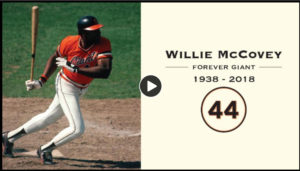
![]()
Poetry and Plein Air
By GrettaJean

Click here to download a PDF of this page: Poetry_Plein Air_YosTrail_Bobcat_FINAL_lite
= = = = = = = = = = = = = = = = = = = = = = = = = = = = = = = = = = = = = = = = = =
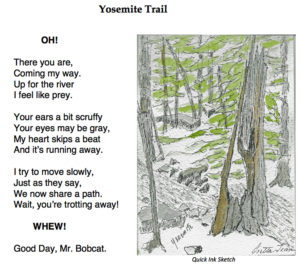
Two Writers We Know Win Awards

Last month, two writers whose work has appeared on ConVivio were awarded “Honorable Mention” in the 2018 Writer’s Digest Annual writing Contest. They were selected from among 5,300 submissions.
Click here to print a PDF of this post:
85-Two Award_winners_Sep21_2018
In this year’s annual competition:
• One poem by Lauren de Vore was selected in the “Rhyming Poetry” category.
• One short story by Dan Sapone was selected in the “Literary Short Story” category.
These two winning pieces are reproduced below.
I Wish That It Had Snowed Last Night
I wish that it had snowed last night,
That I had waked to endless white,
Perhaps a soft and muted quilt
Or shimmering like diamonds spilt,
That hides the daily muck and mess,
The faults and flaws and ugliness,
And for a fleeting hour or two
The world is virginal and new.
And if there’s like to be no snow,
I’ll wish to live where trade winds blow,
Close by the shore and crescent beach
O’erwhich the tides twice daily reach.
I’ll leave my footprints in the sand
‘Midst flotsam cast upon the strand,
Knowing the sea will wash all clean
And leave behind a beach pristine.
I wish there were somehow a way
To live again a certain day,
An hour, an instant, and undo
Those wrongs of mine, those deeds I rue.
As winter snow hides last year’s sin
And spring makes all brand new again,
I wish there were such grace for me,
Some way to set my conscience free.
But lives are more than fields and hills
O’er which fate blows where’er it wills,
And conscience can’t of its debris
Be swept clean by a foaming sea.
So sins and secrets I must bear
Till all that’s left of me is air,
And snow falls soft and white upon
An unspoiled beach at just past dawn.
—— Lauren de Vore (Janury 22, 2018)
All rights reserved
Lauren’s previous contributions on ConVivio can be found at:
https://convivio-online.net/kristof-poetry-contest/
https://convivio-online.net/guest-poet-lauren-de-vore/
https://convivio-online.net/celebrating-national-poetry-month/
= = = = = = = = = = = =
Below is “A Different Kind of September” by PapaDan
A Different Kind of September
September 15, 2015, Savelli, Calabria, Italia
The end of summer was hard to take for Giovanni. Something was missing and he knew what it was. Since he was six years old, September had always meant the summer was over and school was about to start. For years, he and his friends could conduct their September ritual of moaning about how short the vacation had been and the unfairness of being forced to return to school when it still felt like summer. In spite of that unpleasantness, at least they were returning to familiar surroundings and the same collection of friends. In those days, at least they knew what to expect from September.
Of course, by the time they all graduated from high school in 2010 and went their separate ways, everything changed. For Giovanni —everyone called him Gio — the next five Septembers had meant packing up the contents of his room in his parents’ home in Savelli and heading north for the Fall semester at the University of Salerno, about two hundred miles from home. Once he became comfortable with his life as a college student, September became familiar once again. But today, after graduating in June from Salerno’s class of 2015, all of the familiarity and certainty of September had evaporated. This was unfamiliar territory for him and he wasn’t sure how to feel about it.
Looking back, his college career had started well enough. His father had been pleased that Gio would be the first member of the Zappia family to be educated beyond high school. The general pattern for boys who grew up in this part of Calabria, near the bottom of the ‘boot’ of Italy, was to follow their fathers into one of the local factories — ironwork, stonework, heating, metal fabrication – and work their way as far up in the company as their diligence and skill would take them. But his father often reminded his son of his different vision: that Gio would come back to Savelli with a degree from the Business Studies Department at the university and rise to the upper echelon of his company’s management. It was a fairly large company and, with a degree in business, there was money to be made.
However, once Gio showed up at the university, his eyes were opened to a broader vision. It turned out that right next to the low, brick building that housed the Dipartimento di Scienze Aziendali e Ricerca (Department of Business Studies and Research) was another building that seemed more interesting on the outside and, much later, turned out to be much more interesting on the inside as well. This venerable red-tiled marble structure had a blue sign that said:
Dipartimento di Scienze Umane: Department of Humanities:
Filologia, Letteratura, Lingue, Storia Philosophy, Literature, Languages, History
Showing up for his first appointment with Professor Tommasetti, the Dean of the Business Studies Department, he paused to admire the renaissance-era structure next door, looked at his watch, and hurried into the brick building to do his duty.
Professor Tommasetti was pleasant enough; his impeccable Italian had the flowing and precise lilt of a Milanése dialect, as distinct from the more casual Calabrése sounds that Gio had grown up with. “Benvenuto, Señoré Zappia. Non ti chiamano Giovanni?”
“Mi chiamano Gio, mon Professoré,” he answered, trying to match his formality.
“Così, Giovanni, perché pensa di studiare Aziendali?”
Gio was immediately surprised by two things — he didn’t expect to be asked WHY he intended to study business and he noticed that the professor called him Giovanni even though he had just told him he was called Gio. He answered Professor Tommasetti’s question honestly: “Mio padre si auspetta che io diventi un managiatoia nella fabrica del ferro, in Savelli.” [My father expects me to become a manager in the iron factory in Savelli.”]
After looking at him awhile, the professor corrected him that he hadn’t asked why HIS FATHER wanted him to study business; he wanted to know why HE planned to do that. Gio quickly decided that the interview wasn’t going well and hoped some enthusiasm would salvage it. “Io sono il primo della mia famiglia ad andare all università.” He was proud to be the first in his family to go to the university. He thought that might help.
Professor Tommassetti changed the subject and told Gio that he would begin with introductory courses in accounting and business theory, both of which were taught in “his” building. He would also fulfill a general-education requirement in world literature — with an indifferent wave of his hand — in the building next door. He stood up and dismissed him with a gesture toward the door. “Buona giornata, Giovanni.”
“Molte grazie, professoré.” And he was, indeed, thankful to be out the door. And so, it began.
By the end of his second year at Salerno, Gio had a decision to make. During his first two years he had taken the required lower-division business courses and had filled the general education and elective slots in his schedule with courses in World Literature, Philosophy, and English as a Second Language. He enjoyed these courses and had become quite proficient in English.
Preparing for the required Spring interview with the Business Studies Department Head, Gio made three observations. First, he realized that he actually dreaded his required business courses and, whether it was the cause or the effect, he did not do well in those courses.
Second, it had not taken long for him to realize that he derived the greatest enjoyment from his English language, composition, and literature courses. He admired writers, especially the playwrights and novelists, who could make characters come to life on the page. He especially loved the characters of Shakespeare who sometimes spoke directly to the audience. Works of fiction, he was learning, were vehicles for shining light on the truth of what was going on between — and within — human beings. He hoped to write such stories and wanted to learn the techniques writers used to connect with audiences.
His third realization had come after a meeting with his English literature professor. He had gone to Professor Martelli’s office to discuss a paper he was writing about two of the plays of William Shakespeare. He knocked on the office door and found it open.
“Buon Giorno, professoré, posso entrare?” “Good day, professor. May I come in?”
“Yes, come in, but remember my rule — in my class we are studying English literature, so we must speak in English. Let us follow my rule here in my office as well. Capicé?”
“Yes, sir, Thank you. My name is Gio Zappia. I am in your Shakespeare class.”
“Yes, I remember your work. Please sit down.”
Gio began, “I noticed in ‘Romeo and Juliet’ and ‘Two Gentlemen of Verona’ that the writer seemed to know a lot about that Italian city and the history of the two famous, feuding Veronése families — the Montecchi and Cappeletti. In your lecture you mentioned that Shakespeare was born in Stratford and lived in London and there was no evidence that he ever traveled outside of his own country. I am wondering how this man who never left England in the early 16th century could know so much about a small town in northern Italy.”
Professor Martelli looked at him for a long moment and said, “Gio, you have stumbled on a controversy that scholars have debated for a long time. Some have suggested that the William Shakespeare we know from Stratford could not have written these plays. A Sicilian professor, Martino Iuvara, has written that this playwright was in fact not English at all, but Italian. He claimed to have evidence that the plays were written by a man from Messina named Crollalanza. According to Iuvara, Crollalanza fell in love with a 16-year-old named Giulietta, her parents opposed their marriage, she committed suicide, he fled to England, changed his name to its English equivalent (crolla = shaken; lancia = spear), and wrote a play about her. Professor Iuvara’s evidence includes a play Crollalanza left behind in Sicily called Tanto Traffico Per Niente.”
“Much traffic for nothing?”
“Crollalanza’s father was said to have owned a home built by a stonemason named Otelo who murdered his wife in a jealous rage. It’s all in Iuvara’s published work.”
“Then it’s true?”
Professor Martelli’s smile was kind. “It’s the most ridiculous story I have ever heard. Nobody takes it seriously. Apparently, they allowed just anybody to publish in Sicilian literary journals back in the 1950s.”
“Professor, is there a better answer?”
“I’m sorry that I can’t explain Shakespeare’s knowledge of Italy; but Senoré Zappia, you are the first student I have known here at Salerno, who has attempted to do any serious study of Shakespeare. Most of your fellow Calabrési find Shakespeare to be a challenge, so they do their best to avoid him. Your paper last month about his use of language in the history plays was remarkable. So, I have a serious question for you. Why are you pursuing your degree in the Business Department?”
After a moment Gio replied, “Professor Tommasetti asked me the same question at the beginning of my freshman year. I didn’t have a good answer for him then and I don’t have a better one for you now.”
“So, cosa pensa di fare, Giovanni?”
“I’m not sure what to do about it, professoré. My father expects me to return to Savelli with a degree in business. I suppose I have some thinking to do.”
“Yes, think about it — right after you write your paper. It is due on Monday.”
“Yes, right after. Thank you for your time. Molte grazie, professoré.”
This time, he meant it.
A month later, when the Spring term ended, the train ride home to Savelli seemed longer than it had after previous semesters. It was the usual three hours with a stopover at Lamezia; the same yellow colza blossoms typical of late spring in Calabria punctuated the broad expanse of green grass along the tracks; but none of it held his attention. All he could think about was his father’s likely reaction when he told him that a degree in Business would be a waste of time for him. Staring out the window, he rehearsed how he would introduce his idea to change his degree program to the Department of Humanities. He considered starting with his interest in English literature. Or maybe he should admit to his distaste for business. Either way, he assumed his father would be angry and disappointed. Or maybe he should try a more practical approach – he could become a teacher, and maybe, someday he could be a writer … maybe travel.
All of the conversations he imagined during the long train ride went badly. Then, on top of it all, he reminded himself that his father had arranged for a summer job at the metalworks plant; he would start on Monday. This was going to be a bad day.
His father was waiting in the car at the Catanzaro train station when Gio climbed down the steps from the platform. He put his bags in the back and settled into the front seat for the thirty-minute ride home to Savelli. Gio had finally decided that his father had never been thoughtless or harsh. He had spoken often of the life as a factory manager that he wanted for his son; but he was not stupid. Gio figured he’d just tell him the blunt truth and hope for the best. So, he set aside his fear and began, “Papa … ”; but his father interrupted by handing him a letter. It was addressed to him, Senoré Giovanni Zappia, but the envelope had been opened. His father said it was from “Profesoré Martelli,” and gestured for him to read it. Gio studied his father’s expression as Giuseppe turned the steering wheel away from the curb, trying to read his mood; but there were no visible hints. Finally, he unfolded the two separate pages. The first was a scholarship application from Il Dipartimento di Scienze Umane — the Humanities Department, the second was an offer of a part-time job working in the Department Office as a writing tutor for first-year students.
“Scienze Umane, Gio?”
“Si, Papa ‘Humanities’ en Inglese.” The professor had violated his own “rule” and both pages were written in Italian. Gio was pretty sure that he knew what Professor Martelli had intended. The letters were addressed to Gio but they were sent home three weeks ago, virtually ensuring that his father would open them. The letter suggested that Gio could have a bright future if he began preparing now for a career as a teacher, that his writing skills were exceptional. It also explained that, between the job and the scholarship, his college expenses would be fully covered. It was apparently intended to persuade Giuseppe that this was a good idea. Gio read the pages slowly, afraid to look up at his father, not sure how much trouble he was in.
Finally, he father said only, “Non è necessario decidere ancora. Dobbiamo pensare.” “No need to decide now. We will think about it.”
Gio’s reply was quick, “Si, Papa. Dobbiamo pensare.” Yes, Papa, we will think about it.
September, Once Again
The summer passed well enough; his job at the factory was all physical labor, not much thinking. It confirmed for him how much he preferred books and ideas to machines and metal; and there was free time after work for walking in the park near the Museo dell’Arte Contadina. It was a small museum with a library that focused on ancestry research and the history of the surrounding region of Calabria. The lawns and benches in the park were comfortable places to read and think about the coming school year. With the coming of September, his summer job ended and it was time to prepare to travel north to begin his third year at Salerno.
On the appointed day, in the car on the way to the train station, his father asked the question Gio had been bracing himself for: “Avete deciso?” Have you decided? He had prepared his reasons and counter arguments, if they were necessary. He began “Si, Papa … ” but again he was interrupted. Giuseppe had been thinking about it as well. He told his son that it didn’t make sense that the first member of the family to get a university education should end up working in the same factory where his father and grandfather had worked. He told Gio that he was named after his great grandfather Giovanni Ernesto Zappia. “Era analfabeta.” “He was illiterate.” He couldn’t write his own name. Giuseppe told him that if his great grandfather were alive today he would be PROUD to know that MY son might become a teacher or a writer. “FIERA!” PROUD! “Così, è deciso.” “So, it is decided.”
Gio tried not to look stunned and promised that he would do well, knowing that he was accepting a big challenge. And with the optimism of youth, he was grateful for it.
The next three years at Salerno were hard work. Changing his major to English Literature and Composition after two years put him behind in his degree requirements; so, it would take him longer to graduate. The association of other students with similar interests was worth it, and he finally felt like he was getting somewhere. He joined a group of students like himself who had an interest in writing family stories and genealogy. At the Christmas break, he came home to Savelli with his new project.
With the help of his father, his aunt Isabella, and the Museo dell’ Arte library, he was able to begin to piece together a partial family tree going back six generations of Zappias back to a Giovanna Zappia who was born in 1850. He learned that Giovanna had two children — a son, Mario, born in 1871 and a daughter named Giovanna Maria, born in 1874. Records showed that Giovanna Maria, called Maria, had two sons in Savelli before moving to Reggio, Giuseppe born in 1900 and Giovanni in 1906; but strangely, Gio found no record of them anywhere after that, and no death certificates and no record of them living in Calabria after 1910.
The Zappia lineage continued through Maria’s brother, Ernesto, and is sons — Gio’s great-grandfather Giovanni born in 1922 and Salvatore Zappia born in 1931. Gio’s own father, Giuseppe, born in 1960, was Salvatore’s youngest son.
In trying to draw the family tree, Gio was struck by two things. First, the family was a textbook case of the longstanding Italian practice of re-using first names roughly alternating through the generations. Going back the 165 years he was able to trace, he found several males named Giovanni, Giuseppe, and Mario and females named Giovanna, Isabella, Maria, and Caterina. Second, Gio’s eye kept returning to the branch of the family tree where Maria and Antonio Sapone married, had two sons, and then seemed to disappear. As Giovanni boarded the train to return to Savelli after his graduation, he was determined — there was a story to write and he was going to write it.
Back to the Present: September 2015
By the beginning of September, the summer was showing the clear signs of running out of steam. The grass in the park was dry; leaves on the trees were turning yellow; and most of his goals had been met — he had been the first to graduate from the university, he had moved beyond the family pattern of factory life in Savelli, and he found himself applying for two kinds of jobs: at the local schools and at the regional newspapers. He had been told that most job openings were expected in September. Since the summer job ended in mid-August, Gio filled his days in the park and in the ancestry section of the library with his notebook, pursuing his family-history project. Sitting at a desk in the library, Gio thought about how fortunate he was that his father was not pressuring him about his job search; but now, the pressure came from inside. He did his best to push aside his own doubts.
On one of these afternoons, he pulled out the family tree he had been working on and stared at the incomplete branches. He went to the ancestry reference desk and asked the assistant to help him look up some of his great grandmother’s “lost” relatives — Giovanna Maria Zappia and her husband Antonio Sapone. He asked her to search census and property records, death records, ship passenger lists, whatever she could find. Once she began the search, she asked an odd question. She noticed that the query he had asked for had been bookmarked. “Have we done this search for you before . . . about Sapones and Zappias?” Then her face widened as she remembered – “oh yes. It was an older gentleman, an American. Right! There is a note here that he left something behind – let me look.” She disappeared into the back office and returned with a notebook in her hand and a puzzled look on her face. “An American was here some time ago doing research on his family. His grandparents were born in Calabria and emigrated to American a little more than a hundred years ago. He was asking about Sapones and Zappias. He apparently didn’t find what he was looking for and went back to California. Unfortunately, that last day he left this notebook on the desk. We have kept it in the office in case he returned for it. It seems to contain a lot of work.” She handed him the notebook. “Do you know him?” Gio turned some of the pages and was shocked to find some familiar names. “I think we might be related.”
“If you think you might be in touch with him, perhaps you should take the notebook and return it to him. It is not doing him any good here.”
Gio placed it in his backpack and headed for home. His uncle was bringing over some clams, mussels, and calamari and his mother had promised penne alla fruita di mare. There was no way he was going to be late for that.
After dinner, when his father and uncle started arguing about politics, Gio escaped to his room and opened his backpack for a closer inspection of the notebook. It had a brown leather cover embossed with an image of some dramatic mountains and the word “Yosemite.” What he found inside was much more than he expected.
Whose Story?
The pages of Gio’s ‘lost-and-found’ notebook were nearly full — and all in English — but resembled a puzzle with some pieces missing. The first page had a name, “D. Sapone,” and “Yosemite, April 4, 2000.” The scribbling was in English and charts appeared to be pieces of a family tree with some names Gio recognized. Skimming the titles at the top of some of the pages, most of it appeared to consist of short stand-alone chapters. Three described visits to “Yosemite”; another told a story about a hike to a spectacular waterfall. Two chapters were about a restaurant in San Francisco California called The Flying Pig, owned by two brothers named Sapone. Some chapters focused on the writer’s search for details about his family going back several generations. Gio decided to read these chapters first.
Reading through the pages, he learned that the writer grew up in California — a place Gio had learned about in his American Literature courses — a region quite like southern Italy. The second thing that caught Gio’s attention was that this Californian had come to Italy in an attempt to “fill in the blanks” of his family history. And then there was a stunner: this Californian’s grandmother sailed from the port of Naples to Ellis Island in New York on August 18, 1910. She was from right here in Savelli, and her name was Maria Zappia! The owner of this notebook had come from the San Francisco Bay Area to “fill in the blanks” of unanswered questions about Maria’s family and the family of her husband Antonio Sapone, also from Savelli.
A family tree was sketched on one of the pages, showing the gaps that the writer wanted to fill, annotated with questions he wanted to answer:
— Why did they leave Italy in 1910?
— Who was on the family tree before Maria and Antonio?
He finally came to realize that the story this visitor from California was trying to write was the story of Gio’s own relatives going back more than 100 years. With some research, and by asking questions of some older family members right here in Savelli, Gio was convinced that he could complete the story this Sapone had failed to write. And what about this mystery of Antonio?
Gio turned the page from this family tree to a hand-written story that appeared to be a summary of what he had learned. This visitor from California had learned a lot; but had run into some roadblocks. And, it seems, at the end of his visit to Savelli, he had lost his notebook. As he stared at that notebook, in his imagination he could see himself retracing his ancestor’s voyage to America, meeting the American branch of his family, returning the notebook, and filling in the blanks of the story that belonged in it. He thought of the Sapone brothers who owned the Flying Pig Bistro in San Francisco. He imagined a day when he would walk into the Flying Pig, introduce himself to his relatives – HIS relatives – and say to them:
“I have a story. It started out as someone else’s story; but it turns out to be my story. I think it is your story, too. So, would you like to hear it?”
He closed the notebook, placed it in his backpack, and stared awhile at nothing in particular. What would his father say about this? He had work to do. He had a purpose. This story had been a long time coming and he was the only one who could finish it. It was time to begin.
—— Dan Sapone (2018)
All rights reserved
This story is intended as a chapter in a longer work.
The next chapter: to be continued …
Two Guys Speak To Us About Optimism (and other stuff)
<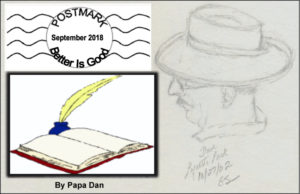
“What can I do to make things better,
not only for myself, but other people?”
— Herbie Hancock
September 3, 2018
“Better is good.”
— Barack Obama
September 7, 2018
84-ConVivio_Hancock_Obama_speak
Herbie Hancock & Barack Obama
Let’s start with Herbie. Jazz enthusiasts of a certain age got to know about Herbie Hancock as a member of the Miles Davis Quintet in the 1960s. Since that time, he has played his piano with a distinguished list of collaborators with energy, enthusiasm, and inspiration. After winning twenty-some Grammy Awards, he is now at an age (78) when performers of “his time” have announced their retirement. BUT, it appears that “his time” still includes the present and the future — he just announced a new album and set of tour dates through 2019 (including one here in the Bay Area). OK, that’s the musical story. But in an interview with Aidin Vaziri of the San Francisco Chronicle on September 3, 2018 (read the complete interview), he had other stuff to say that extended beyond the music. With President Obama’s inspiring speech at the University of Illinois Urbana-Champaign still ringing in my ears from last week (September 7), Mr. Hancock’s answer to one of Mr. Vaziri’s questions got my attention. The question was about “optimism.”
Aidin Vaziri’s Question:
“Given the current climate of the country, are you able to remain optimistic for the future?”
Herbie Hancock’s Answer:
“Yes, because I can see past that part of it. What is happening now and showing its ugly head is not about just one person — namely the president — but with a lot of people that have fears. Fears breed anger. How that expresses itself in many cases is what we haven’t built into our human society, which is the ability to avoid looking for a scapegoat for our sufferings. There’s a tendency for human beings to always point at something outside of themselves. In many cases, there are things outside of yourself that are part of that equation. But it’s more important to take a broader view and realize that if something is happening to me and not other people, what can I do to make things better?”
“In Buddhism, we call that living a life of cause, not a life of effect. It’s easy to point fingers. It’s not easy to see how one is contributing to our own suffering. I think so much of that has been hidden under the rugs anyway. If you really want to clean house, you have to pull the rug back to see it.”
“Well, we’ve had the rug pulled back and now we can see it. What we have to do is not let it become a virus that spreads. We have to pour our compassion and understanding into that and use the best of our humanity to show there’s a better way to find a better life. It’s not the immigrants’ fault. It’s not the Jews’ fault. Or black people’s fault. Or Muslims’ fault. Or the Mexicans’ fault. Or whoever you may be blaming at the time.”
“You have to look first within yourself and think, ‘What can I do to make things better not only for myself, but other people?’ ”
Barack Obama & Herbie Hancock
From PapaDan:
On September 7, Former President Obama gave a formal address at the University of Illinois Urbana-Champaign (Read the complete transcript here.). The occasion was his acceptance of an Ethics in Government award. The audience included students and their families, faculty, and a national television audience. It was a preview of the messages he plans to deliver to the nation during the coming election campaign. He began: “Some of you think I am exaggerating when I say that this election is more important than any in our lifetime. Just a glance at the recent headlines should tell you that this moment is really different … the consequences of any of us sitting on the sidelines are dire.”
Observers described his speech as a “call to arms” to Democrats, especially of the younger generation, to do something they haven’t done in sufficient numbers: –> VOTE. But, I suggest that it was more than that. Still, the most widely reported themes from his speech focused on the dangers to our Democracy —trends in politics and government that threaten the values America has promoted around the world, the behavior of Republicans that have deviated from long-standing Republican values — like their historic opposition to communist tyrants, anti-deficit fiscal conservatism, and preservation of American institutions. “What changed?” he asked. To answer that question, he reminded the audience that only one in five members of the younger generation voted in 2016, and asked, “if you don’t vote, is it any wonder this Congress doesn’t reflect your values and your priorities?” Does it matter? He answered this question by reminding us that, when he was elected, he won some precincts by 5, 10, 20 votes — not percent, votes! Also widely reported was a host of specific criticisms of the Trump Administration and those who support it — on immigration, budget deficits, voting rights, gun violence, women’s rights, corruption ….
–> –> BUT, these are not the features of the speech that are ringing in my ears. The message in the speech that I hope everyone will take to heart, and the message that Herbie Hancock used to justify his optimism for the future of this country, is this — in Obama’s own words:
A key paragraph from Obama’s speech:
“Better is good. I used to have to tell my young staff this all the time in the white house. Better is good. That’s the history of progress in this country. Not perfect — better. The civil rights act didn’t end racism, but it made things better. Social security didn’t eliminate all poverty for seniors, but it made things better for millions of people. Do not let people tell you the fight’s not worth it because you won’t get everything that you want. The idea that, well, you know, there’s racism in America, so I’m not going to bother voting, no point, that makes no sense. You can make it better. Better is always worth fighting for. That’s how our founders expected this system of self-government to work. Through the testing of ideas and the application of reason and evidence and proof, we could sort through our differences, and nobody would get exactly what they wanted, but it would be possible to find a basis for common ground. And that common ground exists.”
“Better is good.”
The Path to “Better” — Observations from PapaDan
Even the important things we consider “better” are usually achieved in multiple steps, not in large, dramatic policy initiatives intended to change the world in one stroke. Changes in the behavior of our government, for example, would require multiple steps to address deficiencies in all three branches of government. That, in practical terms, would require multiple election cycles at all levels of society — starting with local governance upward to the national. It would also suggest significant educational efforts to restore attitudes and values across the generations — values regarding topics like immigration, race, public education, economic security, healthcare, and individual rights. History tells us that these values have been evolving in a fairly singular directional, albeit with alternating periods of back-sliding and recovery, within our social fabric over the past seven decades.
This past week, both the former president and the award-winning musician affirmed three essential messages (there are always three). 1) Progress comes as a result of building on “Better,” not giving up when we are likely to fall short of “Perfect.” 2) They also reaffirmed that a path to “better” must begin with the way we treat each other right now and right here, in our own neighborhoods and in our own families. Finally, 3) Both Herbie Hancock and Barack Obama carried one message underlying their words: Make a Difference. They both described ways we can do that and powerful reasons why it matters. In the final analysis, many of us are not sure that WE can make a difference. If we listen to the wisdom of these two guys, we can come to a conclusion we’ve heard before: Can we make it better? “Yes, we can.”
Optimism isn’t easy.
It isn’t sufficient (neither optimism nor jazz).
But both are required.
Oh, yes, and … well … by the way … vote.
–> And listen to some Herbie. <–
![]()
La Belle Epoque: Just a Moment in Time

A time of optimism, regional peace, economic prosperity, the apex of social order, and technological, scientific, and cultural innovation.
I wonder what it felt like to be there, then? La_Belle_Epoque_ConVivio_Aug30_2018
On a slow-moving Tuesday afternoon in Carmel, California, Liam found himself wandering along Ocean Avenue staring into the front windows of the dozens of art galleries that brightened this otherwise foggy neighborhood. What was he doing there? The factual answer was that the company he worked for had sent its senior staff for a week-long conference by the sea to re-think some of its marketing strategies. Apparently, a secondary plan was to force the group together in an unfamiliar setting to promote some personal team building. The boss wasn’t satisfied with the way the group was functioning together and he figured that a week by the ocean in a relaxed setting with some good food and wine might loosen them up a bit. The schedule called for an agenda that sat them down in a conference room over breakfast and lunch to go through a list of issues. They had the rest of the day off. The hope was that they might spend the afternoons getting to know each other.
It didn’t sound like a bad plan, but the underlying reason the group didn’t function well together was that, at every opportunity, their conversations descended into their strong and differing opinions about the national news and politics of the day. For this little company, like so many others with an international clientele, these factors had a negative effect on their business. As a result, they had developed an unhealthy dislike for one another. So, Liam found a way to escape and wander downtown to get away from the … uh … “heat.”
Turning the corner onto Dolores Avenue, Liam found himself staring at a group of paintings in the window of one of the many neighborhood galleries. Two particular paintings had captured his attention the day before; so he returned to take a closer look. Each one was a street scene in the rain. People carrying umbrellas wound their way among horse-drawn carriages under street lamps lit early in the afternoon because of the drizzly darkness. Another painting featured a similar rain-soaked street, only the traffic consisted of turn-of-the-century automobiles. He was struck by how well the impressionist had rendered the effect of the rain on everything in the scene using oil on canvas. He found himself trying to imagine what it would have been like to walk that street at the turn of the twentieth century. A few moments later he found himself inside looking at a room full of similar images by the same artist. As a man approached him from a room in the back, Liam caught his eye and asked, “I’d love to know how he does that?”
“Sir?”
“The rain. How does he do it? I feel like I’m walking on that street and the rain is all around me. I can hear it sloshing in the street. I can almost feel the water.”
“You are very kind. I have been trying to master ‘water’ for years. I think I’ve finally gotten the hang of it. Paris around the turn of the twentieth century is my favorite time and place and she seems to look her best in the rain, don’t you think?”
“Oh, MY. YOU are the artist? An honor to meet you.” He offers his hand. “My name is Liam.”
“The pleasure is mine. My name is Edouard Cortes. [Shakes his hand.] And, yes, these are my work. If I’m not mistaken, you were in here yesterday. I appreciate your comments. And your question about the water — it turns out you can’t really paint water. Either you try to imitate how it distorts things you see through it or you try to capture things reflected in it. Otherwise, water is pretty much invisible.”
“Oh, now that you mention it, I can see that. I hadn’t really appreciated that before. I guess I hadn’t noticed. I promise not to tell anyone your secret.”
“Oh, it’s not much of a secret; but I appreciate a person willing to keep some things to themselves. You’d be amazed the kinds of things people babble about when they come in here.”
“Well, I am in a business that tries to keep some of its ideas private, ideas of a proprietary nature, if you will, so it’s not new for me.”
With a grin, “And your business is …?”
A similar grin, “Uh … private.”
And a wider grin, “Of course.”
“Mr. Cortes, I don’t want to intrude on your time; but I’d love to know what has attracted you to Paris at the dawn of the twentieth century. What is special about that time and place?”
“I don’t mind at all. It is one of my favorite topics.”
La Belle Epoque
“La Belle Epoque, in English, “The Beautiful Era,” is recognized in Western history as the period from the end of the Franco-Prussian War in 1871 to the outbreak of World War I in 1914. It was a period identified by its optimism, regional peace, economic prosperity, the apex of social order, and technological, scientific, and cultural innovation throughout Europe and America. At its peak during the first decade of the Twentieth Century, the arts flourished, especially in Paris, where many masterpieces of literature, music, theater, and visual art gained recognition. I am quick to point out, however, that “La Belle Epoque” was named in retrospect, when held in sharp contrast to the forces that led to the horrors of World War I. Nobody thought of it that way during that golden age. For a pair of generations, it was merely ‘the way we are’ and it was unconsciously expected to continue indefinitely.”
Edouard pointed at two of his paintings, Café de la Paix and le Théatre — “I hope you can see those features in the faces of the people in my paintings and feel it as the rain washes the face and streets of Paris.”
[Click to view paintings by Edouard Cortes, esp. Café de la Paix, le Teatré, Saint Denis. https://www.google.com/search?q=paintings+by+edouard+cortes&tbm=isch&tbo=u&source=univ&sa=X&ved=2ahUKEwiIssSRlZXdAhVE54MKHXPDC7IQsAR6BAgDEAE&biw=1281&bih=919]
With some effort, Liam resisted the impulse to express his distaste for the current “epoque” here in the twenty-first century and compare it to the artist’s description of La Belle Epoque, not wanting to spoil the mood. Instead, “Sir, here I can see the feelings you have described in the faces of ladies walking across the intersection in their fashionable clothes, in the posture of people going about their business, and the dignified gentlemen walking toward us here. They are clearly living in a time and place that is quite unlike my own. My own visits to Paris did not do her justice, and I believe I am seeing Paris, here, in a way I have not seen her before.”
The artist did not look away from the painting as he went on, “Twilight has always seemed to me to be the best time for Paris to show her ‘Belle Visage’ during this time in her history, whether during the Winter snows of La Madeleine or the Spring rain on Des Champs Elysées.” The orange glow from the cafés and the moving splashes of sheen in the puddles of rain on the street are not fabrications, sir; and I hope you can see them.”
Liam examines them a while. “I cannot help but wonder, Mister Cortes, how an artist like yourself, living here and now, can capture Paris of La Belle Epoque, more than one hundred years ago, with such confidence. I must add it to the list of things I don’t understand. I guess I just have to accept it as a wonder.”
The artist paused a long moment to notice the emotion in the face of his guest and, tilting his head to one side as if to get a clearer view, seemed to make a decision about him. Finally, “Sir, I have been working on another, larger piece in my private studio,” pointing to a door at the back of the gallery. “I wonder if you might be interested in taking a look. Since it has some rather unusual features, of a proprietary nature, as you say, perhaps I could show it to you.”
A Work in Progress — More Than Meets the Eye
Cortes escorted Liam to the back wall of the gallery. With a jangle of keys, he unlocked a door nearly hidden behind some shelves, gestured for him to enter, and closed the door behind them. The dark room came to life when the artist flipped a wall switch that lit a pair of spotlights embedded in the ceiling. The two beams illuminated a single painting that dominated the room. It was about six feet high, half again as wide, supported by a solid wood frame propped against the wall. The artist struck a pose with a grand sweeping gesture presenting a street scene in the rain. “It’s not quite finished, but I think you can get the idea — La Belle Epoque: Paris in 1900 in the rain. I haven’t settled on a name for it, but it depicts Porte Saint Denis.
Liam couldn’t quite see what was ‘unfinished’ about it, and it gave him the distinct feeling that the water on the street in the foreground was likely to splash onto the studio floor.
The imagery reminded him of the impressionism he was so fond of from the early twentieth century, not at all typical of the contemporary works he had seen elsewhere in other galleries on this street from his own decade. The street was littered with papers, and shiny blobs of water reflected the puddles the rain had deposited on the uneven streets. Horses pulled wagons — from tiny one-person carts to larger one-horse coaches to heavy four-horse cargo wagons. Crossing the intersection in front of him was a varied collection of Parisians — wealthy ladies dressed in the latest fashions, a baker carrying a box of baguettes to his customers, and businessmen looking important in the substantial coats and prominent hats of the day. A woman was walking toward us escorting a child across the street passing a man huddling inside a thin cloth coat against a cold, wet day. The sidewalk was quite crowded, nearly everyone wore hats — some briskly hurrying to get out of the rain, others taking their time, perhaps enjoying this important Parisian neighborhood at the height of its prosperity and peace.
Liam felt privileged to be in the company of the artist and wanted very much to say something ‘well-informed’ and appropriately appreciative. “The light! I’d love to know how you are able to show me the light shining off all of these different surfaces.” Before the artist could interject with his artistic technicalities, he continued, “but, to tell the truth, your technique is not really something I can appreciate, and I wouldn’t ask you to reveal your secrets. I am more interested in the feelings I believe I see in the faces of these people. Are they aware that they are living in this great city at such a peaceful, prosperous time? Oh, and the glow from the cafés — I’m thinking of the lives that are happening inside behind those glowing windows.”
The artist seemed pleased with Liam’s assessment. “Well, sir, you’ve hit on an important idea. These people, rich and poor like, are living at a sweet time. The poor had reason to be optimistic about their future and the rich had good reason to feel self-satisfied and secure in their privileges. Most of them had no idea of the turmoil and upheaval that was going to surround them in just a few short years that would change their lives dramatically.”
“Wouldn’t it have been sweet to stand there among them, walk those streets, hear the sound of those horses, join them in those lively cafés? I’d have some questions — how does it feel to be there on the streets of Paris during that time of such calm and stability? Do they have any sense of what is to come in just a short time? Oh, my, the light you provide in this painting makes me feel like I could be there with them.”
A Secret
Once again, the artist paused a long moment to examine the face of his guest and he seemed to confirm a judgement he had made about him. “Well, sir, I would like to invite you to do just that. There are “secrets” of a proprietary nature, as you say, that you must promise to keep to yourself. May I trust you to do that?”
“Well, yes, sir, you have my word — but I don’t know what I could possibly …”
“Here, you will need to carry this,” and the artist handed him an umbrella, picked one up for himself, put his sketchbook in a plastic bag, and gestured toward the painting. “You must step over the wood frame; and be careful, the street may be slippery. You’ll have to trust me on this. Here …” gesturing for Liam to follow him, the artist climbed over the wood frame and stepped onto the wet intersection in the foreground of the painting. Liam followed his lead and found himself standing in the crosswalk of Saint Denis. He could hear the clop of the horses strutting beside him and froze in his amazement. The artist took his arm and coaxed him across the street, over the curb, to the safety of the sidewalk. Before Liam could express his astonishment, Edouard asked him, “Do you speak any French?”
“Well, … uh … a little. I recall some from a year of college French, but …”
“That should be sufficient, we won’t be here long. The most important thing is to observe the faces and body language of the people around you. I think you will see the answers there to some of your questions.”
It was all so much to take in. Liam noticed the flowers on the corner, the woman he remembered from the painting crossing the street, the baker with his box of baguettes, and a waiter staring at the passersby from inside the café on the corner. The sign in the window said “Ouvrir.” Edouard opened the door and they walked into a warm, orange-lit café with tables set for lunch. The waiter who had been watching from the window ushered them to a table looking out on the sidewalk. He greeted them, “Bienvenue, Messieurs,” and handed them menus.
“We should order something.” Liam opened his mouth to answer, but closed it again, not quite knowing what to say. The artist spoke to the waiter, “Soup a l’oignon, un sauvignon de Bourgogne, pour deux, s’il vous plait.” And to Liam, “a little French onion soup and a white burgundy, OK?”
“Sure. Uh … “
“I know, it’s a bit much all at once. Just watch the faces and tell me what you see.”
Trying not to stare, Liam noticed two couples at the table beside them, as the waiter brought the wine and the soup. On the other side, a table with four well-dressed gentlemen who looked to be earnestly discussing business. Hats, scarves, and coats hanging on a rack beside each table. Liam and Edouard spent some time with their soup, before Edouard said, “Take your time. You wanted to know about these people. Study them. When you’ve finished your wine, we can talk about what you see.”
So, they ate their soup, drank the wine. Liam watched, thinking it over — another glass of Bourgogne. The couples came and went, replaced by two elderly ladies who had patisseries and tea. The businessmen lingered over cognac and seemed to have abandoned their business discussion and drifted to lighter topics.
Liam and Edouard spent a long afternoon watching, thinking it over, trying to take it all in. As the afternoon turned to twilight. Edouard took out his sketchbook and drew the lamppost outside the window. The rain had stopped. Finally, he paid the bill — “It’s time for us to go.”— and they walked out into the gathering dusk. “We need to find our way back and step back into our own time. But first, what did you learn?”
What Is There to Learn?
“Well, from what I could make out of their conversations, here was no politics, no economics, no troubled commentary. Faces were serious at times but nothing made them frown. Nobody seemed surprised at what they saw around them. I saw faces of people enjoying each other, not a care in the world.”
“And the ‘proper’ gentlemen?”
“Confident. Sure of themselves. On top of their game.”
“That’s a lot to derive from four hours of eavesdropping.”
“That’s true; but I’m comparing it to what I’ve experienced of four hours of my own time. What I hear consistently is disappointment, shock that things could have drifted so far wrong, surprise at what passes for ‘normal’; violence in the news every day, worry about an uncertain future — and the tense expressions on faces who have grown accustomed to all of that. I didn’t hear that here, didn’t see that.”
“Is it possible that you were looking for that result? Did you simply fulfill an expectation?”
“Sure. That’s possible. What do you think?”
The artist thought about it a while. “Well, it’s certain that most did not expect the hard times that were approaching. What you’ve described is surely a list of the differences between their time and yours. That much is well documented. I had hoped that my paintings would convey those conditions.”
Liam: “Can we bring some of it back with us?”
Edouard: After some thought … “Certainly not by merely stepping back out of my painting. You are the only one in this scene who could make such a difference — when you return.”
Returning to the rainy intersection, they stepped out of the painting, back into the studio. After standing silently for a moment, they exchanged pleasantries and thanks. Liam walked out of the gallery, giving the paintings a last glance and said “I hope to return.” He turned back to the corner of Dolores Avenue and was gone.
Returning on Friday
Friday at 2:00 pm, his week-long conference finally concluded — and with … well … moderate success — Liam hurried back down Ocean Avenue, turned at Dolores, and entered the gallery hoping to see Edouard Cortes once more before returning home. Today, however, as he walked past the paintings of Café de la Paix and Le Théatre just as they were on Wednesday, a younger, taller gentleman greeted Liam warmly. “Welcome. You are our first visitor since our remodeling project. It took longer to reopen than I had hoped; but we’re back now. Thanks for your patience.” He had a nametag reading “Alain Miller, Gallery Manager.”
“Sir, it is pleasure to be back again. I had the pleasure earlier in the week to meet Mr. Cortes,” pointing at his painting. “I have to return home today and I had hoped to say goodbye and wish him well. Is he here?”
“Well, Sir, we are indeed privileged to have two of Edouard Cortes’ originals here in our gallery. There are not many on the West Coast. I think I understand your feelings — spending time with his masterwork must surely give one the feeling of meeting him in person.”
“No, Mister Miler, I spoke to him here in your gallery and back there in his … uh …” Gesturing at the back wall, Liam was shocked to notice that the door in back wall of the room was not there where he remembered it.
The manager, with a grin — “Well, sir, I share your interest, surely; but Mr. Cortes has never been here in the U.S. He passed away in 1969 in Lagny-sur-Marne, in France, where he spent his entire life.”
For Liam, there were no words.
![]()
My Favorite Movies
 “[He’s] one of what we all are, Pelly,
“[He’s] one of what we all are, Pelly,
less than a drop in the great blue motion
of the sunlit sea.
But it seems some of the drops sparkle,
Pelly, some of them do sparkle!”
— King Arthur (Camelot)
“It’s quality work, and there
are simply too many notes, that’s all.
Just cut a few and it will be perfect.”
— Emperor Joseph (Amadeus)
Click for a PDF of this post:
82-ConVivio_My_Favorite_Movies_Aug2_2018
Where did this come from?
Six weeks ago, I published a piece on ConVivio called “Greatest Songs of All Time” (https://convivio-online.net/greatest-songs-of-all-time-2018/). It was inspired by a regular customer at The Flying Pig named Carl. We were talking about songs from “my era” (the 60s and 70s) and he asked me, “What songs are important to you?” So, I mentioned a few off the top of my head and … well, it caused me to rethink a list of The Greatest Songs of All Time that I had posted a few years before. So, when I made a new list and invited others to make their lists, I discovered that there are some talented list-makers among ConVivio readers. Fast-forward to this week and I was talking about those lists of songs with my son Will (one of the proprietors of The Flying Pig), observing how much attention that list-making exercise had attracted. The conversation turned to a favorite movie of mine, which Will’s brother Ben (the other Flying Pig proprietor) recently reminded me of. The movie, “2001 — A Space Odyssey” featured some music that I had accidentally omitted from my “Greatest Songs” list. The movie was a huge favorite during my senior year in high school and is currently getting some attention on its 50th anniversary. Will suggested, “What about a list of ‘Greatest Movies?” I mentioned a particularly dramatic pair of lines from a climactic moment of the movie
— So, this is the result …
PapaDan’s List
Below is my list of my favorite movies. Unlike my “Greatest Songs” list, I did not feel qualified to identify the “Greatest Movies of All Time.” Turns out that “All Time” is beyond the scope of my expertise. SO, my list consists of just the movies I liked best (at least as of today). As a bonus, I include a quote I remember from each one. I invite you to reply, if you like, with:
1. Your own list, as short or as long as you wish, of your favorite movies.
2. You are also invited — though not required — to include a quote that you find memorable from one or more of them (or not).
3. You are welcome to send comments like “How could you possibly leave out ________ from your list?” or “How could you include a dumb movie like _________ ?” All are welcome.
—> A few words of caution — I intended to make a list of ten movies. BUT, that turned out to be impossible. A struggle with painful cutting brought it down from 25 to 17. So, if you decide to make your own list, all of your good intentions to keep it short may be futile. I also could not list them in order of “favoriteness.” Just couldn’t. So, they are in alphabetical order. I also ignored the winners of the most recent Academy Awards, since I wasn’t familiar with many of them anyway. I also did not consider whether “my” movies received any awards in their day.
I hope you, at least, find this exercise interesting.
Here is my list:
My Favorite Movies — August 2, 2018
1. 2001 — A Space Odyssey
• Dave: “Open the pod bay doors, HAL.” HAL 9000: “I’m sorry, Dave. I’m afraid I can’t do that.”
• HAL 9000: “This mission is too important for me to allow you to jeopardize it.”
2. Amadeus
• Emperor Joseph, to Mozart: “My dear young man, don’t take it too hard. Your work is ingenious. It’s quality work. And there are simply too many notes, that’s all. Just cut a few and it will be perfect.”
• Salieri: “This was a music I’d never heard. Filled with such longing, such unfulfillable longing, it had me trembling. It seemed to me that I was hearing the voice of God.”
3. American Graffiti
• “I don’t like that surfin’ shit. Rock and roll’s been going downhill ever since Buddy Holly died.”
4. Butch Cassidy and the Sundance Kid
• Butch: “If he’d just pay me what he’s spending to make me stop robbing him, I’d stop robbing him.”
• Etta: “I’ll do anything you ask of me except one thing. I won’t watch you die.”
5. Camelot
• Arthur (speaking to Pellinore of the newly knighted Tom of Warwick): [He’s] one of what we all are, Pelly, less than a drop in the great blue motion of the sunlit sea. But it seems some of the drops sparkle, Pelly, some of them do sparkle!”
6. Chicago
• Roxie: “I’m a star, and the audience loves me, and I love them, they love me for loving them, and I love them for loving me. And we love each other. And that’s ’cause none of us got enough love in our childhoods. And that’s showbiz, kid.”
7. E.T. the Extra-Terrestrial
• “I’ll be right here.”
8. Field of Dreams
• “If you build it, he will come.”
• John & Ray Kinsella: “Is this heaven?” “It’s Iowa.” “I could’ve sworn it was heaven. Oh yeah, it’s the place where dreams come true. [Looks around and sees his wife playing with their daughter] “Maybe this is heaven.
9. Forrest Gump
• “Life is like a box of chocolates. You never know what you’re going to get.” “Stupid is as stupid does.”
• “I’m not a smart man, but I know what love is.”
10. Funny Girl
• “You think beautiful girls are going to stay in style forever? I should say not! Any minute now they’re going to be out! Finished! Then it’ll be my turn!”
11. The Graduate
• “I want to say just one word to you, just one word.” “Yes, sir.” “Are you listening?” “Yes, I am.” “Plastics.”
12. Moonstruck
• Ronnie Cammareri: “Loretta, I love you. Not like they told you love is … but love don’t make things nice, it ruins everything. It breaks your heart. It makes things a mess. We aren’t here to make things perfect. Snowflakes are perfect. Stars are perfect. Not us.”
13. Planet of the Apes
• “Don’t look for it Taylor, you may not like what you find.”
14. Saving Private Ryan
• “Earn this.” At the very end of the movie, Tom Hanks says it twice — once to Private Ryan and once to all of us in the audience who have benefitted from the sacrifices of soldiers in World War II.
15. The Sound of Music (and let’s not forget My Fair Lady)
• Maria: “When the Lord closes a door, somewhere He opens a window.”
16. Star Wars I – V
• Yoda: “Do. Or do not. There is no try.” Riyo Chuchi: “To die for one’s people is a great sacrifice. To live for one’s people, an even greater sacrifice. I choose to live for my people.”
17. Wizard of Oz
• “True courage is in facing danger when you are afraid.”
18. Midnight In Paris
• Hemingway: “The artist’s job is not to succumb to despair, but to find an antidote for the emptiness of existence.”
19. Same Time Next Year
• Doris: “Doris”; George: “What?”; Doris: “My name is Doris.”; George: “Your name is Doris?”; “Yes.”; George: “But I’ve been calling you Dorothy all night.”; Doris: “Yes, I know.”
20. The Princess Bride (The Greatest Movie Ever Made — according to me)
• Inigo Montoya (to the Six-Fingered Man): “My name is Inigo Montoya. You killed my father. Prepare to die.”
What’s missing from my list?
I omitted a category of “ancient” movies (like Casablanca and those starring Marlon Brando-types), movies by Alfred Hitchcock (although I enjoyed several of them, notably The Birds and Rear Window), and most “war” movies (notably Patton). I also left out The Ten Commandments (I was ten years old when my parents took me to the drive-in to see it), and Ben-Hur (I was nine when my parents took me to its Premier in Oakland), Raiders of the Lost Ark (not sure why), Schindler’s List (because I don’t like remembering it), and Blazing Saddles (because all the memorable quotes are racist and disgusting).
It’s funny about movies. Looking back, some of the choices of “favorites” can feel quite personal and can represent who we were back when we saw them. But, they’re just movies, right?
I look forward to your comments, maybe even a few lists.![]()
Below is Cary Sapone’s list of favorite movies
— In no particular order (another excellent list!).
Shawshank Redemption
Pretty in Pink
Mrs Doubtfire
Pretty Woman
When Harry Met Sally
How the Grinch Stole Christmas
The Pursuit of Happiness
Back to the Future
Sixth Sense
The Polar Express
Trying To Make It Better

Hey, Jude, don’t make it bad.
Take a sad song and make it better.”
— Paul McCartney
Recently I wrote something called “Interruptions,” reflecting on the continuous drumbeat of tragic stories that emerge from the daily news. Every day, it seems, we hear another new piece of bad news piled on top of the unraveling stories of bad news from previous days. I read “Interruptions” in public at The Whistlestop Writers meeting here in the Tri-Valley. From the reaction, it seemed to have resonated with members of the audience. However, on reflection, I think even my central question — “What should I do about it?” — only made us feel worse about the things happening in our world these days. Gretta asked me, and I had to ask myself, “Was it a good thing to inflict such thoughts of harm and futility on my audience? Were they any better for it? Was I? Or did I just contribute to how bad we all feel about the world around us? One day’s bad news may distract us from yesterday’s bad news – or last week’s. More often, I fear, the accumulation of stories has a “multiplier effect.” In short, did I just make it worse?
Yep. Maybe so. I decided not to publish it on ConVivio.

So, the resulting “Writer’s Block” (pictured here) has me looking for something else to think about and something else to write about. So, here is a quick start — just a start. Just little things. It’s brief. We’ll see if this approach leads anywhere.
Some News That’s Not Bad
Caught on “smart doorbell” camera, kids return wallet with $700 inside.
http://abc7news.com/society/caught-on-camera-kids-return-wallet-with-$700-inside/3835550/
Small American town welcomes refugees with Southern Hospitality.
https://www.today.com/news/clarkston-georgia-home-thousands-refugees-t132421
There’s a new Alzheimer’s/dementia drug that’s showing promise in slowing memory loss in early clinical trials.
https://www.nytimes.com/2018/07/25/health/alzheimers-dementia-drug-treatment.html
A generous anonymous donor reveals her identity. She gave millions to artists without taking credit for the gifts.
https://www.nytimes.com/2018/07/20/arts/design/susan-unterberg-artist-grant.html
A British supermarker chain is introducing a “quieter hour” for autistic shoppers.
https://www.nytimes.com/2018/07/19/world/europe/uk-supermarket-autism-morrisons.html
An experiment with a four-day work week is a surprising success.
https://www.nytimes.com/2018/07/19/world/asia/four-day-workweek-new-zealand.html
Tourist accidentally pays 100 times taxi fare— driver tracks him down to return it.
https://www.goodnewsnetwork.org/when-tourist-accidentally-pays-100-times-his-taxi-fare-driver-tracks-him-down-to-return-it/
Riders of dirt bikes and all-terrain vehicles, illegal in most cities, have found a community.
https://www.nytimes.com/2018/07/25/nyregion/dirt-bikes-bike-life-ride.html
Recovering addict anonymously pays for ambulance crew’s breakfast.
https://www.goodnewsnetwork.org/recovering-addict-anonymously-pays-for-ambulance-crew-eating-breakfast/
Surprising solution: saving a country from wildfires with goats.
https://www.goodnewsnetwork.org/goats-the-surprising-solution-to-saving-a-country-from-wildfires/
There’s a lake of liquid water on Mars.
https://www.nytimes.com/2018/07/25/science/mars-liquid-alien-life.html

A mother duck is caring for 76 ducklings on Lake Bemidji in Minnesota.
https://www.nytimes.com/2018/07/24/science/merganser-ducklings-photo.html
Today, right now, across the world, something good is happening — whether or not we hear about it or acknowledge it as something good. And, as Walter Cronkite used to say at the end of The Six O’Clock News back in the 1960s, “And that’s the way it is.”
And, there’s more …
Your comments on this topic are welcome. ![]()
Art & Ideas: Art by GrettaJean
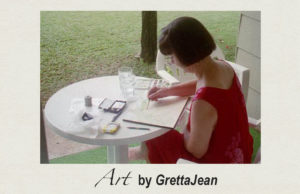
Yosemite in the Fall — 2017
— Pastel drawing by GrettaJean

ConVivio_Yosemite in the Fall_GrettaJean
= = = = = = = = = = = = = = = = = = = = = = = = = = = = = = = = = = = = = = = = = = =

Greatest Songs of All Time—2018
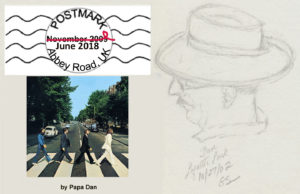
You KNOW something’s happening
but you don’t know what it is,
DO you, Mister Jones.”
— Bob Dylan (né Robert Zimmerman)
(from “Ballad of a Thin Man” 1965)
“I don’t believe in Zimmerman
… I don’t believe in Beatles.
I just believe in me, Yoko and me,
and that’s reality”
— John Lennon (The Plastic Ono Band, 1970)
Click for a PDF of this post:
79-ConVivio_Greatest_Songs_June_2018
= = = = = = = = = = = = = = = = = = = = = = = = = = = = = = = = = = = = = =
Where did this come from? I ran into a guy named Carl at The Flying Pig (a regular customer) and, at closing time after the Warriors game, he was using the sound system at The Pig to play songs from his iPhone. Turned out he was playing some songs from MY ERA (i.e., from the 1960s); so, I went to talk to him about it. He asked me, “What songs are important to you?” So, I mentioned a few off the top of my head and he found them on his iPhone and played them over the sound system — some Bob Dylan, Judy Collins, Simon & Garfunkel, Beatles, Van Morrison, Richie Havens, etc. It got me to thinking about an old ConVivio post. Some of you who have been reading ConVivio for a long time tell me you remember it. It was titled: “Greatest Songs of All Time — A Challenge.” In that post, from November of 2009, I posted my list of the twenty greatest songs of all time (according to me) and challenged readers to offer their own lists.
My list and several responses to that challenge appeared in the comments following that post — it can be found at: https://convivio-online.net/greatest-songs-of-all-time-challenge/
I realized that the list I would make today would be different — not necessarily because of new songs that have come out since, but because different songs have increased or decreased in importance to me. So,
In answer to a suggestion, last week I offered readers the opportunity to follow up that original challenge. I asked you to:
1. List the 20 greatest songs of all time, according to YOU, and answer two questions:
2. What’s wrong with my list?
3. What’s excellent about my list?
So, some of you responded to the challenge. Below are some of those initial responses and, at the end, I made a new list of my own with an explanation of why those songs ended up on my list. First, I learned a few things from your responses.
Things I learned:
• Steve Rubio observed that he preferred early Beatles to later songs for an interesting reason.
• Multiple songs by an artist can be well-represented on a list by a single song.
• Artists I enjoyed back in the 60s/70s are also listed by people half my age. (OK, and you might point out that I listed songs that were released WAY before I was born
• Most of us mix Rock, Jazz, Country, and Classical over many time periods in our favorites.
• For a music lover, twenty is not enough — is there a number that would be “enough?”
In this post, I have included responses from the “First Responders.” There may be others in later posts, but today we have terrific contributions (below) from these people:
Steve Rubio, Seven Peterson, Jessica Wing, Jonathon Wing, Janet Crampton-Pipes, Jim Pipes, Manny Mendes, Lauren de Vore, and finally, PapaDan. My list, at the end, includes answers to the question “Why did THAT song end up on your list?” You will also find some links you can click on that you might find interesting. (Manny’s is found in the comments after the post.)
Enjoy …
From Steve Rubio
“I’m game, as long as we agree from the start that my list would be different if you asked tomorrow.”
In alphabetical order by artist:
The Beatles, “There’s a Place”
Chuck Berry, “Johnny B. Goode”
James Brown, “Lost Someone” (Live at the Apollo 1963 version)
The Clash, “Complete Control”
Bob Dylan, “Like a Rolling Stone”
Aretha Franklin, “Respect”
The Jackson 5, “I Want You Back”
Little Richard, “Tutti Frutti”
Van Morrison, “Madame George”
OutKast, “Hey Ya!”
Elvis Presley, “That’s All Right, Mama”
Prince, “When You Were Mine”
Public Enemy, “Fight the Power”
The Rolling Stones, “Gimme Shelter”
The Ronettes, “Be My Baby”
Sleater-Kinney, “Sympathy”
Patti Smith, “Gloria”
Bruce Springsteen, “Born to Run”
Ike and Tina Turner, “River Deep Mountain High”
The Velvet Underground, “Heroin”
What’s wrong with my list?
Twenty isn’t enough … missing are Hüsker Dü, Sex Pistols, Pink, Sly and the Family Stone, Creedence, Otis Redding, and more.
As you know, it’s impossible to pick just one Beatles song. I choose “There’s a Place” as an example of my taste in Beatles: I tend to prefer early songs to those from the middle or late period, and I love the harmonies they offered before everyone starting hating each other. Other choices would include “I’m Down” and “And Your Bird Can Sing.”
What’s excellent about my list?
All 20 songs that made the cut.
From Steven Peterson
Recently I have been thinking of what I would choose for the 20 or even 100 best songs by Dylan. It felt a little overwhelming.
Twenty best of all time? Uff da! In the past year my brother, sister, and me listed our favorite 20 Beatles’ songs. That was fun, but also a little overwhelming.
Without thinking too much. Here are 20 songs I would definitely consider putting on the list:
Dylan — Like a Rolling Stone
Stones — Sympathy for the Devil
Beatles — A Day in the Life
Beatles — Yesterday
Beatles — Hey Jude
Dylan — Visions of Johanna
Mellencamp — Jack and Diane
Stones — Start Me Up
McLean — American Pie
Guthrie — Alice’s Restaurant
The Band — Up on Cripple Creek
Counting Crows — Mr. Jones
The Wallflowers — One Head Light
CSN — Suite: Judy Blue Eyes
Croce — Workin’ at the Car Wash Blues
Knopfler & Harris — All the Road Running
ABBA – Dancing Queen
Beatles — Penny Lane
Traveling Wilburys — Handle with Care
Van Morrison – Brown-eyed Girl
What’s wrong with my list?
And this list of 20 doesn’t even include Motown. Or singers & groups such as Joni Mitchell, Joan Baez, Bonnie Raitt, The Kinks, The Beach Boys, Neil Young, Bob Seger, Elton John, Simon & Garfunkel, Creedence Clearwater Revival, The Eagles, and many, many others.
What’s excellent about my list?
My list is not excellent; mostly, it is momentary. It’s what I thought of — right about now. Of all time, really? That is trying figure out too much at once.
AND, a day later, Steve sent the following follow-up response: “I have been thinking about what I sent you and would like to modify it to include The Eagles “Hotel California,” The Doors “Light My Fire,” Aretha Franklin “Respect,” and so on. I don’t doubt that I could come up with a new list of 220 that is as good or better than I did the first time. By the way, Dabbie and I have chatted with young people over the years and most of them say the music we grew up with [in the 1960s] is better than the music they grew up with.”
From Jessica Wing:
Here’s my input for your challenge: the 20 greatest songs of all time, according to ME.
Michael Jackson – “Thriller,” “Billie Jean,” “Beat it” … pretty much all of his hits … haha
Bob Marley – “No Woman No Cry,” “Three Little Birds”
Prince – “Purple Rain”
Dolly Parton – “Jolene”
Johnny Cash – “I Walk the Line
Garth Brooks – “Friends In Low Places”
What’s wrong with my list?
I didn’t include any currently released songs. I feel songs earn their “greatness” over time.
What’s excellent about my list?
All of the artists have multiple songs that I consider greatest songs of all time.
😊 Jessica Wing
From Jonathon Brian Wing:
Here’s my contribution to your challenge!! This was fun to do, thank you for this.
My list: In no particular order
DJ QBERT – Razorblade Alcohol Slide
A Tribe Called Quest – Can I kick it?
Nina Simone – Dont Smoke in Bed
D’Angelo – Cruisin’
Bob Marley – Get Up, Stand Up
Rage Against The Machine – Killing In The Name
Lee Fields & The Expressions – Honey Dove
Marvin Gaye – If I Should Die Tonight
Wu-Tang Clan – Triumph
J-Dilla – Its Dope
Mayer Hawthorne – Thin Moon
Teddy Pendergrass – Close The Door
2PAC – 2 of Amerikaz Most Wanted
The Isley Brothers – For The Love Of You Pts. 1 & 2
Fleetwood Mac – The Chain
Dre (feat. Snoop Dogg) – Still D.R.E.
Deep Puddle Dynamics – Rainman
Miles Davis – Freddie Freeloader
The Roots – Mellow My Man
Ike Turner & The Kings of Rhythm – No More Doggin’
What’s wrong with my list?
That it’s not longer? There are SO MANY more songs/artists that can be put down. I’ll just have to wait for the next challenge — haha
What’s excellent about my list?
That it’s a good representation of my music taste.
Here they are, in no particular order.
Strange Fruit – Billie Holiday
Imagine – John Lennon
What a Wonderful World – Louis Armstrong
Con Te Partirò – Andrea Bocelli
September When it Comes – Rosanne Cash
Tears in Heaven – Eric Clapton
Amazing Grace – Sung by Andrea Bocelli, or LeAnn Rimes
Sympathy for the Devil – Rolling Stones
Will You Still Love Me Tomorrow – Amy Winehouse
America the Beautiful – Ray Charles
If I were a Carpenter – Tim Hardin
Ghost in this House – Alison Krauss
The Dock of the Bay – Ottis Redding
I Will Remember You – Sarah Mclachlan
Thrill is Gone – Duet with BB King, Tracy Chapman
Simple Man – Lynyrd Skynyrd 1973 version
Green Grass and High Tides – Outlaws
Stand by Me – Ben E King
Blowin In the Wind – Bob Dylan
Janet
From Jim Pipes:
Here is my song list. I can’t say they are the best songs of all time, just some of my favorites in no particular order.
Can’t you hear me knocking- Rolling Stones
A day in the life- Beatles
Still my guitar gently weeps- Beatles
Great Gig in the sky- Pink Floyd
Beware of darkness- George Harrison
Waiting on a friend- Rolling Stones
All things must Pass- George Harrison
Walk on the wild side- Lou Reed
The old Laughing lady- Neil Young
You were always on my mind- Elvis Presley
Moonlight Mile- Rolling Stones
A change is gonna come- Sam Cooke
When I was seventeen- Frank Sinatra
Halleluiah- Jeff Buckley
Someone to lay down beside me- Linda Ronstadt
O Fortuna- Carmina Burana
Philadelphia- Bruce Springsteen
Trouble man- Marvin Gaye
Rawhide- Frankie Lane
Take five- Dave Brubeck”
Honorable mention:
Fire- Robin Williams singing a Bruce Springsteen song while doing an Elmer Fudd impression. (on YouTube).
What’s wrong with my list?
I should have had music from other genres instead of mostly rock and roll. Probably focuses too much on the music of my youth. I bet most people could guess my age within a few years from reading my list.
What is excellent about my list?
To me these songs just have deep social meaning or remind me of an event or time in my life. Some of them I feel were just so innovative and incredibly well done. I remember hearing “ When I was seventeen” on the rental car radio while driving in Kauai on our honeymoon, and when my older brother let me borrow his Rolling Stones tape when I was in eighth grade. To hear Sam Cooke singing about racial struggle and Bruce Springsteen singing about the early Aids epidemic just stirs something inside of me. The musical complexity of “ A day in the Life” was like nothing I’d ever heard before.
Again, these are just some of my favorites and If I had to write this list a month from now it would probably be very different. But that is probably the point of this exercise, to think about the music you really like. I should stop now before I change my list again!
Jim
From Lauren de Vore:
Ok, here’s my attempt at a list. It’s totally random and I can’t really say why some songs are on the list. I clearly lean toward the classical and away from the current (I just don’t and never did listen to the radio much). I should have at least one or two Beatles songs, but I’d be hard-pressed to name my favorite, kind of depends on my mood. (A caveat in my defense: I am not an auditory learner and so I have a terrible time remembering names of songs and singers. I’ll hear a song and know that I’ve heard it before, but I couldn’t tell you what it is.)
My “Top 20” Favorite Songs
Ave Maria (Shubert), as sung by Barbara Bonney (https://www.youtube.com/watch?v=xDyiYEdTp-U) or Luciano Pavarotti (https://www.youtube.com/watch?v=sGr6B6Rp4PU)
Au Fond du Temple Saint, from The Pearl Fishers, by George Bizet, as sung by Jussi Bjorling and Robert Merrill (https://www.youtube.com/watch?v=5PYt2HlBuyI) or Placido Domingo and Andrea Bocelli (https://www.youtube.com/watch?v=i-v-DZjZ9iY)
Nessun Dorma, from Turandot, by Giacomo Puccini; as experienced in a live performance by Luciano Pavarotti with the San Francisco Opera opposite Montserrat Caballé (conceive of >500 lb of diva on stage between the two of them!): recital version: https://www.youtube.com/watch?v=rTFUM4Uh_6Y)
Jeremiah Was a Bullfrog (Three Dog Night)
Can’t Help Falling in Love (Elvis Presley)
American Pie (Don McLean)
Sittin’ On the Dock of the Bay (Otis Redding)
Morning Has Broken (Cat Stevens)
Tuesday Afternoon, Nights in White Satin (Moody Blues)
Paper Moon (Nat King Cole)
The Sounds of Silence (Simon and Garfunkel)
You’ve Got to Be Carefully Taught, from South Pacific (Rogers and Hammerstein)
Ol’ Man River, from Showboat (Kern and Hammerstein), sung by Paul Robeson
I Got Plenty o’ Nuttin’, Summertime, from Porgy and Bess (George Gershwin, lyrics by DuBose Heyward)
Just about anything by Carole King (So Far Away, Beautiful, I Feel the Earth Move, You’ve Got a Friend, Will You Still Love Me Tomorrow, A Natural Woman, Tapestry)
Zero My Hero, by Bob Dorough (Schoolhouse Rock)
PapaDan’s List
My “Greatest Songs of All Time” — June 2018
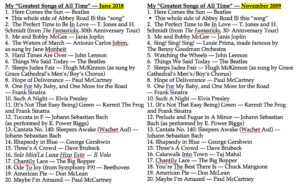
To answer the question I’m asked: “How did THAT song end up on your list?”
#1 Richie Havens’ live version deserves to be recognized at the top of this list, along with the original. Havens’ album “Mixed Bag” (1966) was one of the favorite albums of my youth.
#2 This is the one song representing my longstanding love of Broadway musicals. This song was not in the original, but in its 30th-anniversary tour.
#3 This one is special and represents so many. Her version of “Summertime” is classic.
#4 I had to put “The Waters of March” somewhere, so “Sing! Sing! Sing!” had to go. The story of this song is found at: https://en.wikipedia.org/wiki/Waters_of_March . It was released in 1975 and recorded famously by lots of people. My favorite recording is by Jane Monheit (2001). This recording in English, in addition to Monheit’s fabulous vocals, features (according to me) the best recorded performance by a drummer I have ever heard, especially noticeable in the last minute or so. The song is a list of things that have something in common. What do you think they have in common? This song, written by Antonio Carlos Jobim, was introduced to me by Craig Herold. Thank You, Craig!
#5 John Lennon’s “Hard Times are Over” replaced John’s “Watching the Wheels” from my original list. “Watching the Wheels” appealed to me as John’s decision to let go of the fame and frenzy of being a “Beatle” for a quieter life with Yoko (“I just had to let it go”). Instead, released just before his death in 1980, “Hard Time Are Over,” is bitterly ironic since John and Yoko sang this one looking ahead to the happy future they hoped for. That, of course, was not to be. But, actually, the lyric was “Hard times are over, over for a while.”
#6 One of the 126 greatest Beatles songs of all time — may favorite from the early period.
#7 “Sleeps Judea Fair” by Hugh McKinnon is an important song for Gretta and me. For more details, take a look at: https://convivio-online.net/grace/
#8 I can’t bring myself to replace “Hope of Deliverance” from Paul’s 1993 album “Off the Ground” because of its meaning in today’s world; so, let’s add another song from that LP: “Golden Earth Girl.” I always loved this one: “in another world, someone over there is …”
#9 This is one of two songs (see also #11) of the many Sinatra songs that I loved over the years. Interesting to me is that my sister bought Frank Sinatra records when she as in high school in the mid-1940s and I bought Sinatra records in the 1960s.
#10 Gotta have at least one by Elvis to represent dozens that belong on my list. This one is borderline operatic.
#11 Not everybody knows that this song was a hit as sung by “Kermit The Frog” and by Frank Sinatra. Both versions belong on my list and both are on my iPhone.
#12 “Toccata in F,” by J.S. Bach, is the piece I have come to know as “The Waterfall Toccata,” providing the soundtrack to my many visits to Vernal Falls in Yosemite. Click here for the Waterfall Toccata story: https://convivio-online.net/yosemites-vernal-falls-once-again-and-still/
#13 Bach’s “Prelude and Fugue in A Minor” is one of the monumental pieces of music of all time (here “All Time” goes back to March of 1685). Try this — Dr. Roger Nyquist is the organist who taught me about these pieces at Santa Clara University in 1968: https://www.youtube.com/watch?v=kdG-AmqS2GM
#14 This one represents the modern American spirit as it was before my generation came along.
#15 There has to be at least one Brubeck. This is a good one, but here are so many …
#16 I replaced “Cakewalk Into Town” to make room for a group of songs that have come to mean a lot to me — a live concert album by three Italian teenagers who call themselves Il Volo, in Italian: “The Flight.” Gretta and I saw them live in SF in 2012. Their initial concert album “Il Volo Takes Flight” contains at least two important songs to me: “O Sole Mio” (click here for details) and “La Luna Hizo Esto (click here for details) “O Sole Mio” is world famous as a (mostly) Italian song, the title means “My Own Sunshine,” written by some people we’ve never heard of in 1898, but recorded my every Italian opera-style singer since that time. Elvis Presley borrowed the melody for “It’s Now Or Never” (not a translation). This recording by Il Volo is the best I’ve heard (including the one by Pavarotti). The second, “La Luna Hizo Esto,” from the same album, means “the moon made it so.” Take a look at the story of this concert album at: https://en.wikipedia.org/wiki/Il_Volo_Takes_Flight There is a long story about how this group of singers got our attention, but that will have to wait for another time.
#17 This one is for every teenage boy who remembers first being fascinated with teenage girls. We all grew up and moved on, but the song remains a monument to that time.
#18 Composed in 1823, selected as the “Anthem of Europe” by the Council of Europe on January 19, 1972, and later as the national anthem of the European Union. To me, it represents a belief that people from different cultures can join together and recognize a common humanity and a common destiny. Recent events in Europe and elsewhere have cast some doubt on that belief; but we’ll have to see. Take a look — this is how and where the song should be played: https://www.youtube.com/watch?v=kbJcQYVtZMo
I regret having replaced the Chuck Mangione song (click here), but “Ode To Joy” had to be on the list somewhere.
#19 This one does the same thing that #14 does, but for MY generation. Both songs lament an important loss.
#20 I have to keep this one, “Maybe I’m Amazed,” from Paul’s first solo album after the breakup of The Beatles. I was stunned that The Beatles were broken and began recording solo albums; and one line in Paul’s song made we want to argue with him. The lines were: “Maybe I’m a lonely man who’s in the middle of something, that he doesn’t really understand.” I wanted to call him up and say, “What do you mean ‘you don’t understand?’ You were part of The Beatles and even I understand THAT! How come YOU don’t?” OK, that would be rude.
What’s wrong with my list?
• Only one from Elvis, only two from Sinatra, only one Broadway show tune (!!!!!!!!), how did I forget “Graceland” (both Willie Nelson and Paul Simon) …
• No Moody Blues (but “Voices In the sky” belongs here, along with a dozen others)
• No John Mayor and no Pearl Jam (but it’s early and “All Time” is a very long time)
“Stop This Train” and “Just Breathe” belong on this list.
• No Peter, Paul, and Mary (inexcusable!)
• No Bob Dylan (but how many would it take?) Just for fun, try these two:
https://www.bobdylan.com/songs/ballad-thin-man/
https://www.youtube.com/watch?v=QLmGiFnKbtk
What’s excellent about my list?
• The Beatles are represented at the beginning, middle, and end of my list.
(OK, there could be 126 Beatle songs on my list, but such is life.)
• I finally got Richie Havens on the list
• Bach and Beethoven make an appearance (sorry about Mozart).
• Il Volo
• No disco. You can thank me for that.
Thanks to those who contributed lists. If you would like to add your list to this collection, please post it as a comment below.
![]()
Today’s ‘New Renaissance’

“Eppur si muove” (and yet it moves)
– Galileo Galileo
“There must be some kind of way out of here,
said the joker to the thief.”
— Bob Dylan (“All Along the Watchtower”
sung by Jimi Hendricks)
Is it possible for ‘progress’ to be a good thing
and a bad thing at the same time?
— PapaDan
Click here to download a PDF of this post:
78-ConVivio_New_Rennaissance_May27_2018
= = = = = = = = = = = = = = = = = = = = = = = = = = = = = = = = = = = = = = =
Good News and Bad News
In their book “The Age of Discovery,” published in May, 2016, Ian Goldin and Chris Kutarna defined our current age as a “New Renaissance.” They observed that the forces at work during the period 1450-1550 in Europe (i.e., the “original Renaissance”) were very similar to the forces that are shaping our own time here in the 21st century.
During the “original Renaissance” (the one we learned about in school), Da Vinci, Brunelleschi, Columbus, Copernicus, the Medici, Galileo, Michelangelo, Luther — just to name-drop the top level of superstars of the time — shaped the western world’s understanding of, well, everything.
Newly acquired knowledge and capabilities changed the world through:
• scientific discovery,
• advancements in art and architecture,
• observations and predictions of the behavior of the universe,
• unprecedented global navigation,
• and new views of the relationship of humans to ““the church” (and, therefore, to God).
All these had significant effects on employment, manufacturing and distribution, wealth and poverty, political power, belief and behavior, health and longevity, life and death, and the structure of society.
Oh, yes, and one more thing — arguably the most significant thing — Gutenberg’s printing press. This invention made it possible for people everywhere to KNOW about all of those ‘Renaissance’ effects more quickly and cheaply than ever before and to acquire that knowledge UNFILTERED. Before the use of those small metal letters, oil-based ink, and flat white paper, knowledge was the primary possession of The Church, since it alone had access to The Bible and whatever other knowledge that could be transmitted by written language. Before that time, The Bible and other documents were produced slowly and laboriously in rooms full of monks who copied the text by hand with quill pens, creating the only copies of existing knowledge. Church leaders decided who could see those documents and controlled their contents. Gutenberg’s gizmo changed pretty much everything. The centralized ability to control knowledge and, therefore, to control people, began to diminish dramatically.
Looking back, most people have agreed that these developments — this rebirth and dramatic expansion of knowledge to “the masses” — represent the single greatest combination of human advancement and improvement in the lives of real people in the history of civilization.
Right?
And, of course, as the distribution of paper with little squiggly marks on it increased, it also enabled a dramatic increase in education of all kinds AND an expansion in the ability of people to participate in their governance and political decision-making. Those are good things.
Right?
The Rest of the Story (as Paul Harvey used to say)
Last fall, a column appeared in the Washington Post, written by David Von Drehle. In that piece, he made some simple observations and obvious comparisons that led him to a startling conclusion. He started with our Gutenberg story — how a goldsmith in Germany found a way to reproduce identical copies of important information and distribute that knowledge cheaply and quickly across the world without the control of the “main-stream media” of the time. He observed that nothing was ever the same after that invention.
So, what specific outcomes happened as a result of the use of the printing press? He reminds us:
• Lay people could own and read their own Bibles,
——-> The result was the Protestant Reformation
• Scientists could record their observations to share with other scientists
——-> The result was the Scientific Revolution
• Inventors could share their innovations with other inventors
——-> The result was The Industrial Revolution
• Philosophers could spread their ideas to activists
——-> The many results included one particular document written in a distant European colony that begins, “We the people of the United States, in order to form a more perfect union …”
So, does any of that sound familiar to those of us who are paying attention here in the 21st century? The comparison? Von Drehl asserted, “When Apple unveiled its first smartphone in 2007, the company sparked a communications revolution likely to be as transformative as Gutenberg’s. It’s the nature of such seismic change to shake the institutions of culture and society to the ground.”
So, what happened? The election of 2016 happened. Von Drehl observes that 2016 was the first American election truly dominated by mobile communication and social networking. As a result, information, the ideas that follow from that information, and the conclusions drawn from them were “set free.” This development has made the world a much tougher place for people who have derived their power and influence from an ability to control information, ideas, and opinions, — like the leaders of political parties. So, here comes Von Drehl’s dramatic conclusion:
Steve Jobs Gave Us President Trump
https://www.washingtonpost.com/opinions/steve-jobs-gave-us-president-trump/2017/09/05/f4f487e4-9260-11e7-aace-04b862b2b3f3_story.html?utm_term=.f61b89c59bd2
WHAT??!!!
Did Anybody Warn Us?
Anyone who makes even a cursory study of the process and logic that led up to the writing of the US constitution, finds some awkward words coming from the Founding Fathers. Much of the intent of the constitution derives from ideas found in The Federalist Papers, written by Alexander Hamilton and James Madison, with some help from John Jay, and the discussions that took place during the Constitution Convention of 1789. Much discussion at that convention centered around the need to avoid the pitfalls that had caused previous attempts at democracy to fail by giving too much power to “the people.” Here are a couple of excerpts:
- James Madison wrote in Federalist Paper No. 10: “In a pure democracy, there is nothing to check the [influence of] the obnoxious individual.”
- At the 1787 Constitutional Convention, Edmund Randolph said, “… in tracing the causes of past failures to their origin, every man had found [the causes] in the turbulence and follies of democracy.”
- John Adams said, “Remember, democracy never lasts long. It soon wastes, exhausts, and murders itself. There was never a democracy yet that did not commit suicide.”
- Chief Justice John Marshall observed, “Between a balanced republic and a democracy, the difference is like that between order and chaos.”
In summary — the framers of the constitution were afraid of democracy, the extent to which it gave power to “the people.” As a result, they wrote a number of provisions into the constitution to protect the government from the ignorance and poor judgment of “the people.” The electoral college, for example, was designed as a layer of protection to ensure that the people will not be able to directly elect a president, without the guidance and restraint provided by an elite group of leaders (like themselves). The reasoning — in the words of John Adams, “the people are likely to be easily brought under the influence of a demagogue if given unchecked power.” Wow, did THAT ever backfire! Similarly, the constitution, as originally adopted, provided that members of The Senate would be selected by the State Legislatures for that same reason — that the people are likely to make rash choices in difficult times without “adult supervision.” Similar features are found throughout the document, some of which were later amended.
So today
The mobile communication and social networking made available by the innovations introduced by Steve Jobs (and others) made it possible for “the people” to access unfiltered information — regardless how wise or spurious it may be — to persuade each other in ways that appeared authoritative, and to make decisions that may or may not be in their own best interests or in the long-term interests of the republic. Sounds like that is exactly what the founders feared.
So, here we are.
What do we do? Does this mean that we have overdone this ‘democracy’ thing in America? Is there something we should do to try to reverse some of its effects? If history is a guide— and it usually is — I’d observe that the effects of the “original Renaissance” were more or less permanent. So, perhaps, there’s no going back to a time when information could be owned and controlled? AND I think most of us would agree that we would not want to return to a time when an “establishment” could control information and knowledge — even if WE were part of that establishment. On the other hand, in a world of uncontrolled information, is there a way to give Americans the tools to recognize truth and wisdom when they see it and distinguish that from lies and foolishness? Well, on another “other hand,” is it possible that “the people” stumbled on some wisdom in the Election of 2016 that some of the rest of us are just slow to recognize? Is throwing out conventional wisdom and starting over a good idea? We look back fondly on that achievement when they did that during the “original” Renaissance — back in the 15th century and the times that followed, right? They overturned an oppressive and ignorant time and replaced it with some useful ideas. In the long run, it turned out pretty good for us, here in the future. Of course, it was pretty traumatic at the time for those who had to endure dramatic and disruptive changes, eh? There was a period of pretty serious disorder.
So, was THAT RENAISSANCE a good idea? What about THIS ONE? Is it merely a difficult time we must endure to get to a better time? Can we predict the long-term effects of the changes we are noticing today? What will “the future” think of what we have done? What will our grandchildren say when they are our age? Will they be proud of us?
What do you think?
So, I guess we’re still working on it. We’ll see. ![]()
.
The In Crowd
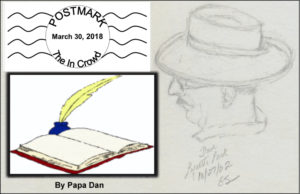
“You ain’t been nowhere
’til you’ve been in
with The In Crowd.”
— Dobie Gray (lyrics by Billy Page
Click here to download a PDF of this post: ConVivio_The_In_Crowd_Mar29_2018
= = = = = = = = = = = = = = = = = = = = = = = = = = = = = = = = = = = = = = = = = =
Last week, a friend of mine lamented the fact that some important content she was interested in was available only on Facebook, Twitter, and other social media. The bad news was that this content happened to be the marketing material from the publisher of her soon-to-be-released book. The problem, in her words, was this: “I don’t do social media and don’t intend to start!”
After some thought, I replied, “It seems to me that everyone assumes these days that we are all is hooked up to these social-media websites; and, if you aren’t, you don’t have a clue what’s going on. It’s like the new ‘In Crowd.’ “
And then a memory popped into my head — “Remember the song from back in the day …”
An Old Song Pops into My Head
Let’s drift back a moment to 1964. Every Saturday morning on radio station KYA, my favorite disc jockey, Emperor Gene Nelson, would count down the “Top 30 Hits” for that week. A lot of new songs were introduced on those Saturdays; and it was absolutely essential for us 14-year-olds to keep up with the latest music. High school was a big change for me. After eight years in the same school, in the same class with pretty much the same faces, the transition from being an 8th grader to being a High School freshman was intimidating.
My freshman class had ten times as many kids as my 8th-grade class had. I knew thirty-some kids and the rest of the 300-some kids in the Freshman class were strangers. But, even as a stranger, like other 9th-graders, I quickly realized that listening to the right music would be required to fit in to my new world. So, I listened carefully — to the Beatles, The Stones, The Supremes, Leslie Gore, The Dixie Cups, The Dave Clark Five, Dusty Springfield — to all the music Emperor Nelson played on KYA.
With all that in mind, one Saturday morning, The Emperor introduced a new song that got my attention. The song was “The In Crowd.” Coming from a school where I had always known everyone, the idea of an “In Crowd” was new to me. The big, bold voice of Doby Gray sounded like a voice of authority.
Here is what the song said:
The In Crowd
By Dobie Gray (recording released December, 1964); lyrics by Billy Page

Not all of the ideas in the song were new. I already knew that some 8th graders were considered more “cool” than others (certainly more “cool” than I was); and “cool” usually meant exhibiting behaviors that other kids admired. I remember a friend of mine, Michael Savage, (who had an older brother who could teach him “cool”) showed up one day in the 8th grade with “a new way of walkin’,” like the song said. When he walked across the courtyard at school, with his slow, purposeful gait and aloof expression, he caught the admiring eye of those of us who were “less cool.”
So, back then, I suppose we 8th-graders had a sense that some of us were especially “in”;
but the following year when the song came out, to my 9th-grade ears, some of these “In Crowd” song lyrics revealed ideas that separated those who were “in” from the rest of us. Two examples:
First: it hadn’t occurred to me that some people “know what the in crowd knows” and presumably, those were things that I didn’t know, and
Second: apparently, the chosen few “go where the in crowd goes” and “if it’s square, we ain’t there.”
I wasn’t completely sure what “square” meant — except that I suspected that “square” included attributes that I probably had and included places that I went. (Uh, maybe places like the library or the store where I supplied my stamp collection? I suppose they were “square.”)
As I became more accustomed to high school, some of the lyrics were actually troubling:
the assertion that “our share is always the biggest amount” didn’t sit well with my teenage sense of fairness and I wondered, as an outsider, ‘what earned you that biggest share’ — other than trivial stuff like “our own way of walkin’ ” and “our own way of talking’.” The song assigned behaviors to those of us who were not in “The In Crowd” that I didn’t like:
They make way day or night
They know the in crowd is ‘out of sight.’
Who said I was going to “make way” for anyone?” On reflection (or what passed for ‘reflection’ in a 14-year-old), “Spendin’ cash, talkin’ trash” did not sound like something worthy of respect.
Evolution
As time went on, and this Freshman became a Sophomore, and so on, other bits of evidence confirmed my suspicion (and hope) that there were other ways to earn respect — things like getting good grades, succeeding at athletics, reading books, joining clubs, being a good friend, etc. The music continued to be important to me (and I learned to keep quiet about my Frank Sinatra and Tony Bennett records), but I came to realize that a narrowly defined “in crowd,” that merely imitated approved “cool” behaviors, was not particularly appealing. I considered that a person, even in high school, could be part of more than one “crowd.” One of my teachers had a sign on the classroom wall that I copied into my notebook. It said:
“They laugh at me because I’m different.
I laugh at them because they are all the same.”
Fast Forward to Today
So, as I mentioned, these “In Crowd” lyrics from 54 years ago did not spring into my memory out of nowhere. The pervasive nature of Facebook, Twitter, and other social media seems to have created a new “in crowd.” While digital media was originally promoted as being inclusive; in fact, the “In” and ”Out” feature of digital social media seems to have grown more exclusive. Has Facebook become a new “In Crowd?” We have learned lately that there are things we have to give up to be a member of that crowd.
Looking at this topic through the lens of today, I think we can hear these lyrics in The News that we hear every day. We seem to be surrounded by people who want us to believe that we must be members of a particular exclusive “in crowd” or we are not properly American. Some promote the idea that the survival of that American “in crowd” requires its members to exclude people who are different. Are we being fed an exclusive “In-Crowd-First” philosophy?
The optimist in me wants believe that the kind of exclusive “In Crowd” behavior we saw as teenagers of 1964 eventually disappears with age and is replaced with something more sensible and grown up. There is evidence, however, that my optimism may be naïve. Is today’s “in crowd” mentality growing rather than receding? Is it dangerous? How divisive can it get?
But, I do notice that some crowds are emerging with more inclusive intentions — crowds like “Enough is Enough” and “Never Again.” Some of the most articulate and welcoming spokespersons of those crowds are not much older than I was in 1964 and they are starting to emerge as the “grown-up” voices of our time. And the crowds, just last weekend, have been quite large. Do these “in crowds” offer just another short-lived “new way of walkin’ ” and ” new way of talkin’ ” as they did in my youth?
Or is something more enduring, more inclusive, perhaps more promising, on the horizon?![]()
Baseball 2018

There are only two seasons:
Winter and Baseball.”
— Bil Veeck
“Baseball is ninety percent mental
and the other half is physical”
— Yogi Berra
Click here to download a PDF of this post: ConVivio_baseball_Feb2018_Final
= = = = = = = = = = = = = = = = = = = = = = = = = = = = = = = = = = = = = =
Baseball
 Here in February, the day Lou Seal shows up at my granddaughter’s school in San Francisco, in full uniform, you KNOW baseball is just around the corner. Why did he appear at Quinn’s school? Was it to introduce young people to the magic of baseball and the optimism that spring training embodies? The timing is clear: Spring Training is about to begin and, once again, it’s magic. All you have to do is say the words “Spring Training” and serious baseball fans can feel the magic.
Here in February, the day Lou Seal shows up at my granddaughter’s school in San Francisco, in full uniform, you KNOW baseball is just around the corner. Why did he appear at Quinn’s school? Was it to introduce young people to the magic of baseball and the optimism that spring training embodies? The timing is clear: Spring Training is about to begin and, once again, it’s magic. All you have to do is say the words “Spring Training” and serious baseball fans can feel the magic.
Disclaimer: I was a basketball player. It was the only sport I was any good at, but I grew up loving baseball — I watched it ever since 1961 when my brother-in-law Joe Faletti took me and my nephews to my first Giants’ game at Candlestick Park; I listened to Russ Hodges and Lon Simmons describe it on the radio; I lived and died by the fortunes of My Giants. Baseball mattered to a kid growing up in the 1950s/60s in Antioch, CA. It became personal. [Click here for my personal, brief baseball history.]
In baseball, the approach of Spring Training is a hopeful time — no scores yet, no losses, no strikeouts or disappointments. Even after My Giants’ dreadful 2017 season (we’re not gonna talk about that) the slate is clean and all things are possible. In 2016, my son Matt and his wife Nou took Gretta and me to our first Spring Training in Arizona. It was a sweet gift. [Click here for that story] Now I grant you, today I am deeply involved in the Warriors’ effort to win another NBA championship. That’s a very big deal. But baseball is something more.
So, what is this Giants fan thinking about here in February, 2018?
To get us ready, let’s listen to some (mostly) REAL baseball people who have gone before us:
- George Will: “Baseball, it is said, is only a game. True. And the Grand Canyon is only a hole in Arizona. Not all holes, or games, are created equal.”
- Terrence Mann (James Earl Jones from “Field of Dreams”): “And they’ll walk out to the bleachers; sit in shirtsleeves on a perfect afternoon. They’ll find they have reserved seats somewhere along one of the baselines, where they sat when they were children and cheered their heroes. And they’ll watch the game and it’ll be as if they dipped themselves in magic waters. The memories will be so thick they’ll have to brush them away from their faces. “
- Dr. Archibald “Moonlight” Graham: “Well, you know I … I never got to bat in the major leagues. I would have liked to have had that chance. Just once. To stare down a big-league pitcher. To stare him down, and just as he goes into his windup, wink. Make him think you know something he doesn’t. That’s what I wish for. Chance to squint at a sky so blue that it hurts your eyes just to look at it. To feel the tingling in your arm as you connect with the ball. To run the bases – stretch a double into a triple, and flop face-first into third, wrap your arms around the bag. That’s my wish.”
- Ted Williams: “Baseball is the only field of endeavor where a man can succeed three times out of ten and be considered a good performer.”
- Gerald R. Ford: “I watch a lot of baseball on the radio.”
- Jim Bouton: “You spend a good piece of your life gripping a baseball and, in the end, it turns out that it was the other way around all the time.”
It’s About Memories
It turns out that a lifetime of baseball is a lifetime of memories. If you’I bet you have plenty of your own. As a kid standing in the right field bleachers at Candlestick Park during batting practice, I remember when Willie Stargel of the visiting Pittsburg Pirates hit a ball over the right field fence into a gaggle of kids hoping to snatch the ball. After the ball bounced off the concrete, I remember seeing a hand reach up out of the bunch and grab the ball. What a surprise to learn that hand belonged to my nephew Steve Faletti, who walked away with the baseball. For me that same day, what kind of thrill was it to stand behind the centerfield fence about twenty feet from the greatest player of all time: Willie Mays?
So many memories followed that one.

On the evening of July 2nd, 1963, I finished my homework listening to a pitching duel between Warren Spahn of the Milwaukee Braves and Juan Marichal of My Giants on the “leather radio” my dad had given me. By the time I needed to go to bed the score was 0-0 starting the ninth inning.

I couldn’t turn it off with that score, so I snuck my transistor radio under the pillow and decided to hear the end of the game in bed. Twenty-five-year-old Juan Marichal came out and continued his shutout in the tenth and, to some surprise, forty-two-year-old Warren Spahn did the same. Turned out that the dual shutout continued until, with my transistor radio still in my ear, Willie Mays hit a walk-off home run into the late-night darkness in the bottom of the 16th inning. The next morning the SF Chronicle quoted a dejected Spahn as saying, “I threw him a screwball and it just hung there, it didn’t do a damn thing.” When asked if he was surprised that is manager kept him in the game so long, Spahn growled “If that kid can pitch 16 innings, I sure as hell can.”
OK, fast forward 54 years to May 12th, 2017 — 25-year-old Giant catcher Buster Posey comes up to bat, this time at AT&T Park, in the bottom of the 17th inning against the Reds. Same story — Buster hit a similar walk-off home run over a different left-field fence. Willie (age 86) and Buster (25) got to talk about it (below). [Read the story.] On this night, however, nobody pitched a complete game — alas, such is the nature of the game here in the 21stcentury.

The Nuschler
Another Giant favorite, Will Clark, was known as “Will the Thrill” from his days playing high-school ball in Louisiana. He lived up to that name in his first major-league at-bat hitting a home run off Hall-of-Famer Nolan Ryan in 1986. He went on to hit 35 homers in 1987, leading his (and My) Giants to the playoffs for the first time since 1971. But my enduring memory came at the end of the 1989 NL playoffs when he hit the ball up the middle to drive in the game-winning runs sending them (us) to the World Series. But, that series turned out, well … we’re not gonna talk about that.
But I digress. Where was I? Oh, yes …

“The Nuschler” (from his actual middle name) is the name given to Clark’s “Game Face” during his rookie year with the Giants, a face described by a teammate as a combination of confidence, satisfaction, arrogance, and just plain oblivion.”
Giant Plans to Make New Memories in 2018
A whole bunch for things need to go right for my team to be a playoff contender this season. Let’s face it, last year (64-98) is a tough experience to build on (we’re not gonna talk about that). But, in the spirit of the ‘new beginning’ that Spring Training always promises, there is hope.
Thing One — Pitching: Madison Bumgarner. He needs to pitch well enough to be in the running for the Cy Young Award. He needs to start 30 games and My Giants need to win more than 20 of those to be contenders. Period. Johnny Cueto and Jeff Samardzija can certainly be expected to improve as are Chris Stratton and Ty Blach to round out the starting staff with Tyler Beede and Andrew Suarez lurking in the wings. (There has been recent talk about a return of Tim Lincecum, but that’s still just talk.) So, no question the pitching staff must step up and there’s no reason to doubt that possibility. It’s Spring Training, right?)
Thing Two — Offense: IF Bumgarner and the rest of the pitching staff come through as we hope, we’re going to need to score more runs than last year, right? I’m looking for Jarrett Parker to step forward and improve on his .247 average and 23 RBIs. He can do better than that. We know that Hunter Pence is capable of improving on his 2017 numbers (.260, 67 RBI) as is “The Panda” (.220, 32 RBI). The Brandons can be expected to top last year’s stats (Crawford: .250, 77 RBI, 14 HR; Belt: .241, 15 RBI, 18 HR). Joe Panik can at least repeat his numbers (.288, 53 RBI, 10 HR). No need to worry about Buster Posey — we can count on at least his .320, 67 RBI, 12 HR numbers from 2017; and his handling of the pitching staff will, of course, be crucial.
Trade rumors are still circling, but as of Monday morning, rumors about Panik, Chris Shaw, and Tyler Beede seem to be quashed. So, it looks like Panik (and his bat) will be starting at second base for the Giants. According to the Chron, he is (and we are) happy about that.
The Giants signed two former Pirates — Outfielder Andrew McCutcheon and LH pitcher Tony Watson — among several players added this month. They also announced 28 non-roster invitees to Training Camp and, as in the past, some pleasant surprises may emerge from that list.
Thing Three — Groan-Ups Meddling with the Rules: Baseball Commissioner Rob Manfred announced on Monday that new rules are in place to speed up the pace of MLB games this season. The plan is to limit trips to the mound (six per game by coaches and players), reduce the time allotted for pitching changes, and shorten the breaks between innings (by five seconds). You won’t believe the specific times and circumstances listed in the new rules (and, believe me, you don’t want to know). But, resisting this rising tide of time-slicing, the players union rejected the idea of a 20-second pitch clock. Whew.
And what problem are they trying to solve? Last year’s games averaged 4½ minutes longer than 2016. Here is my editorial comment à à à I think this effort to speed up the game is … well … bull-babble (did I make up a new word?). The game was intended to be slow-paced and thoughtful. These rule changes and the attempt to gain back that 4 ½ minutes are ridiculous.
So, there!
Thing Four — What Does Vegas Say?: Odds makers have established an early favorite to win the 2018 World Series. Before I tell you their prognostication, let me tell you an important part of my upbringing. You may be surprised to hear that I grew up having two favorite baseball teams:
1. The San Francisco Giants
2. Any team that happens to be playing against the LA Dodgers on any particular day.
With that in mind, who does Las Vegas predict will win the World Series in 2018?
We’re not gonna talk about that!
P.S. And, of course, this one — technically in my lifetime — is still my favorite memory:
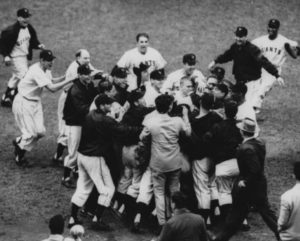
Watch Bobby Thompson’s
“Shot heard round the world,” in 1951
The New York Giants beating the Brooklyn Dodgers
to advance to the World Series.
(Yes, the voice is Russ Hodges)
https://www.youtube.com/watch?v=lrI7dVj90zs
And one final quote, from Yogi Berra: “It’s fun; baseball’s fun.”
We could all use more of that fun, d’ya think?![]()
The Good Old Days?
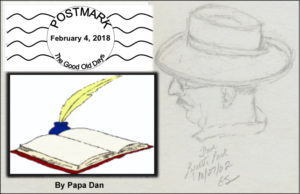
“Nothing is more responsible for ‘The Good Old Days’ than a bad memory.”
— Franklin P. Adams
“These are ‘The Good Old Days.’ ”
— Carly Simon
Click here to download a PDF of this post: ConVivio_DRAFT_GoodOldDays
= = = = = = = = = = = = = = = = = = = = = = = = = = = = = = = = = = = = = = = = =
We’ve All Heard It— Or Said it — Some Version of It
I’ve heard it a number of times lately, in various forms, by people of different ages or with very different points of view — myself included — some version of:
“How did we get here? Things were never this bad back in _____________”
(and here we fill in the blank with our version of ‘a better time’)
Mighta been “back in the 1950s, when I was a kid,” Or maybe “back in my thirties when my kids were little.” Some might offer: “The 1970s, when I was a kid.” Or “at the peak of my career when I was at the top of my game.” Or “back when movies were better” or “back when the government worked better” or “when I could hit consistently from the three-point-circle.” Or how about “when the world (or the country or the city or the neighborhood) was safer (or cleaner, friendlier, easier to understand or had less traffic)?” Or “two years ago, before . . . ”
You know: “The Good Old Days.” You remember.
I suspect each generation can recall a decade or a year (or a month or a day or even a place) when/where the things that are annoying or troublesome or frightening about today were NOT happening (or at least did not seem so annoying or troublesome or frightening in our memory). Do you have a memory of such a time — a time that you remember as being better than today in some way? I bet you have some images in your mind that represent what was better about that time. Were the people better, more reliable, more friendly, smarter? Were the choices available to you more appealing back then? Easier to achieve? Less of a struggle? More fun? Did stuff make more sense to you? Were those times really better?
A Well-Used Example
People my age (the ‘baby-boom’ generation) like to talk about the 1950s and early 1960s, remembering it as a time of stability and simplicity, when music was more harmonious, when post-war America was expanding its prosperity and influence in the world and building lots of shiny new things — cars and highways, and buildings, and corporations, and … stuff. Maybe we remember that we liked our neighborhood better somehow.
Just for fun, let’s take a look at that time, just was an example. We’ve got pictures …




Some of us remember the time before seat belts, riding in the back of station wagons and pick-up trucks. It was a time when there weren’t so many rules; but I guess we don’t want to think about the danger we were in every day. Seat belts started showing up at the end of the 1950s and many of us actually started using them in the mid-1960s.
Other memories come to mind from that era —
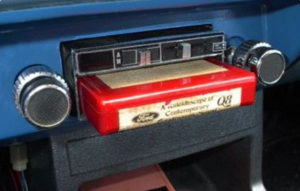

Remember when eight-track stereo (above, left) started showing up in cars about 1964? And when they were replaced by cassette players in the late 1970s? Yes, this was way before CDs (1982). But, we’re getting ahead of ourselves. Here’s what really mattered at the end of the 1950s:
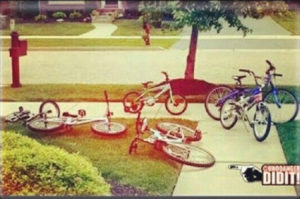
Before any of us cared about cars, here is how you found your friends in the neighborhood in the 1950s. Here, they’re all down the street at Kelly’s (he had a swimming pool).

And do you remember when you (OK, your parents) could drive up to a hamburger place (like A&W or the “Panther Drive-In” in Antioch) and the ‘Car Hop’ would come out to the car (sometimes on roller skates) and serve your food on one of these window trays? (What do you mean you never went to the Panther Drive-In in Antioch? There was a time when it was the center of the universe. Didn’t you know?)
Me? OK, I hung out at Fosters Freeze.



Surely you remember when every business had a cash register like this one on the left? Maybe you started using an Instamatic camera with flash cubes to take photos around 1963? (It used film — remember film?) But, most important of all was the transistor radio, above on the right. I’m sure you, like me, listened to the San Francisco Giants (as described by Russ Hodges and Lon Simmons) on one of these. And, on Saturday mornings, I listened as Emperor Gene Nelson counted down the Top 30 songs on KYA. Then in the late evening on KYA, Big Daddy Tom Donohue played those same songs and read commercials for Clearasil (the Acne Cream). He would sign on at the beginning of his show with these words: “This is your Big Daddy Tom Donohue. I’m here to clear up your face and mess up your mind.” No fooling, he actually said that every night — don’t you remember?
“The Fifties” Come Into Sharper Focus
Those are some of the things that I remember about that era. I claim that “The Fifties,” the fabled time of stability, predictability and good times, lasted from 1950 until November of 1963. After that, troubling, unexpected things started happening — or maybe I just became more aware of a wider world with more complexity and danger than I had seen before. I learned that America was in a mortal struggle against The Soviet Union who, we were told, wanted to kill us all with nuclear weapons because they believed that we wanted to kill them with those same weapons. When we practiced diving under our desks at school in the event of a nuclear attack, I became painfully aware that the wider world was a threat to us right here in my town.
On the evening news, Walter Cronkite starting telling us some very disturbing things including the fact that my hero at the time had been murdered on the streets of Dallas. When I showed up in high school in 1964, I began to learn that wars were brewing all over the world and Americans not much older than me were being sent to fight in those wars. I learned that while I was having my stable and secure childhood in my peaceful California town, others in my own state lived in towns that had bloody race riots. The only people of color I met growing up were the housekeepers who worked for my mother and basketball players who played for Pittsburg High School in the town next to ours. I wondered why there were no Black students in my high school and none seemed to live in my town. It wasn’t until 1968 — about the time that Martin Luther King and Robert Kennedy were murdered — that I learned that a class-action lawsuit had been filed against realtors who had conspired to make sure that no Blacks moved into Antioch. I remember being shocked and embarrassed as I packed up to go away to college.
Every day, it seemed, there was more distressing news and I became increasing aware that my own stable and peaceful life was an exception, not the rule, and I was living in the middle of troubled times across my country and around the world.
Well, so much for my example of “The Good Old Days.”
Waiting? What Might We Learn?
Just as we learn that it’s foolish to look back and wish for a return to “good old days” we think we remember, it also turns out to be foolish to wait for better days ahead. A song I remember from 1971, written and sung by Carly Simon, advises us to invest our energies into making TODAY the best it can be. The song, “Anticipation,” tells us that pinning our hopes on the future is wasteful. She wrote:
Anticipation, anticipation
Is makin’ me late
Is keepin’ me waitin’
She offers this advice:
I’m no prophet and I don’t know nature’s ways
So I’ll try and see into your eyes right now
And stay right here ’cause these are the good old days
These are the good old days. These are the good old days.
These are the good old days.
I take her advice to suggest that we have to invest in THIS day. I observe that there is much to like about today — I am surrounded by people who matter to me and who make my life matter. If today is not what we want it to be, we, along with those close to us, have the responsibility to make it better.
My conclusion? The past and the future are both flawed. THESE are the only “Good Old Days” we get. Maybe they’re only as good as we make them.
![]()
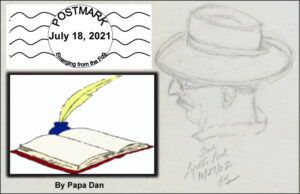
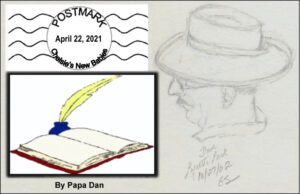

 In this photo, the two little bundles of fur are barely
In this photo, the two little bundles of fur are barely
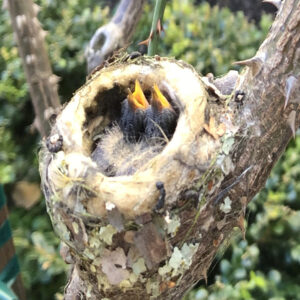

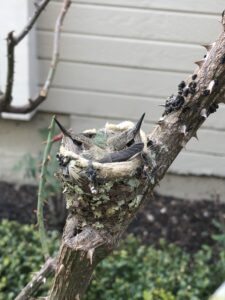

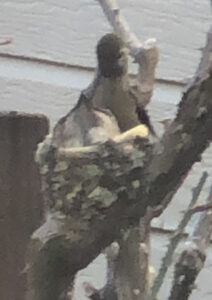


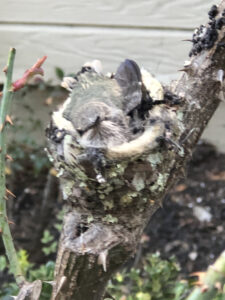
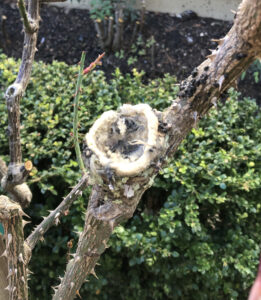


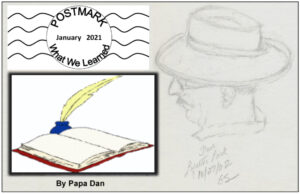



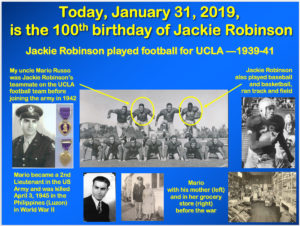
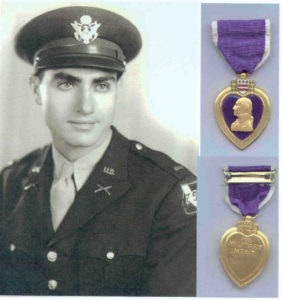
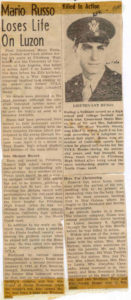


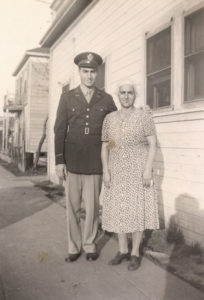


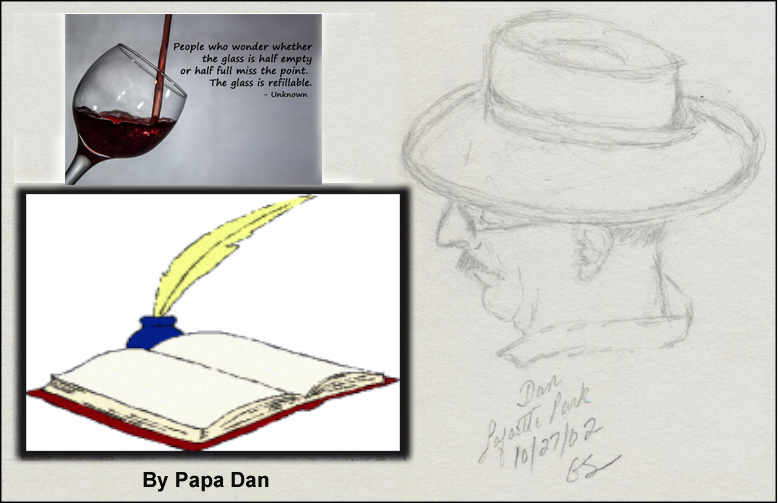

 We’ve been taught to hope by people with a lot of experience.
We’ve been taught to hope by people with a lot of experience.
